Assessment 6 – Address language, literacy and numeracy skills
VerifiedAdded on 2024/07/22
|45
|11062
|64
AI Summary
This assessment is based on a unit of competency of your choice. As part of Assessment 5, you will deliver two training sessions. Within your learner group in Session 2, you will have a learner who has low language, literacy and/or numeracy skills. This assessment involves analysing and planning for this learner so you can support them during training and assessment in Session 2.
Contribute Materials
Your contribution can guide someone’s learning journey. Share your
documents today.
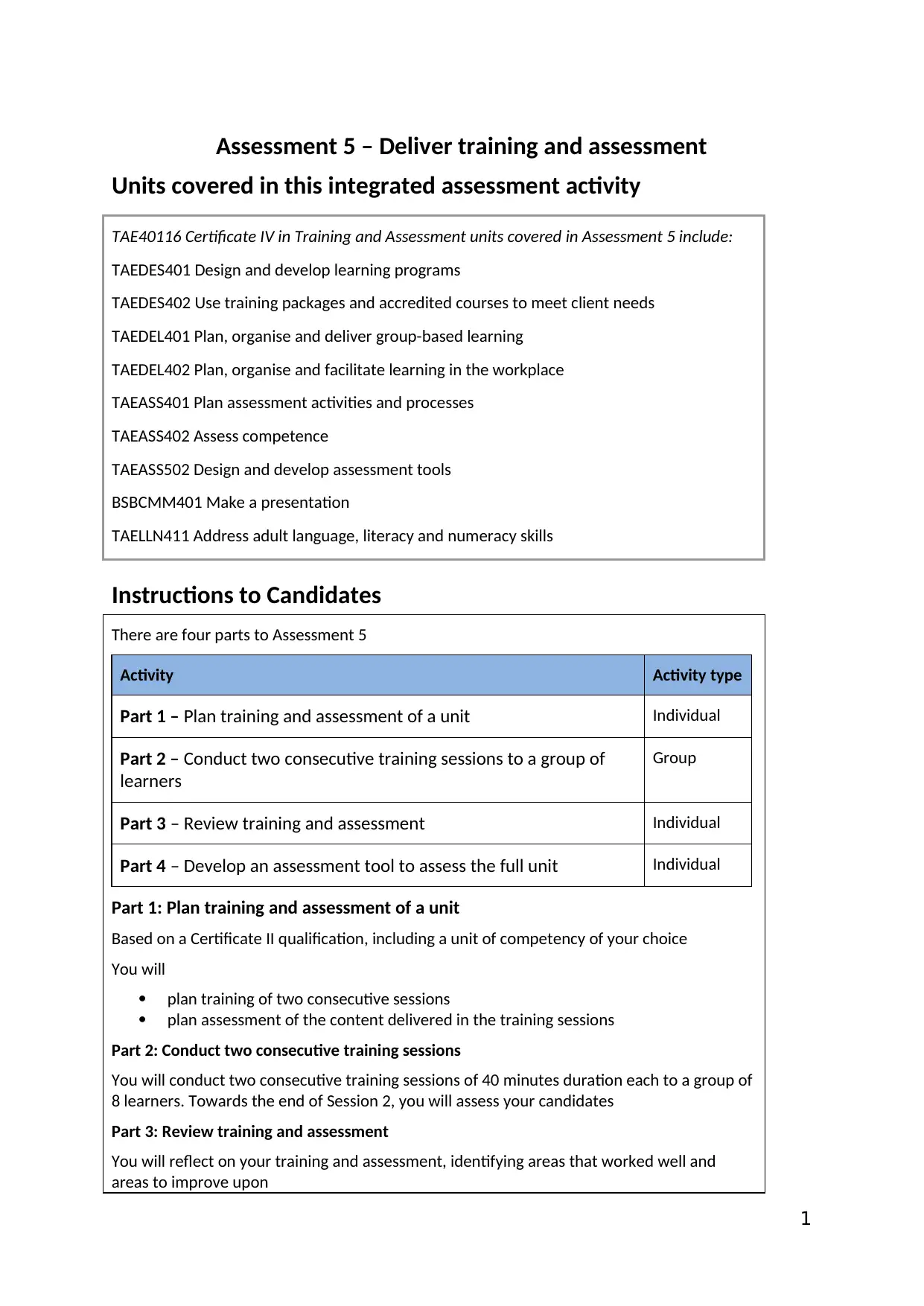
Assessment 5 – Deliver training and assessment
Units covered in this integrated assessment activity
TAE40116 Certificate IV in Training and Assessment units covered in Assessment 5 include:
TAEDES401 Design and develop learning programs
TAEDES402 Use training packages and accredited courses to meet client needs
TAEDEL401 Plan, organise and deliver group-based learning
TAEDEL402 Plan, organise and facilitate learning in the workplace
TAEASS401 Plan assessment activities and processes
TAEASS402 Assess competence
TAEASS502 Design and develop assessment tools
BSBCMM401 Make a presentation
TAELLN411 Address adult language, literacy and numeracy skills
Instructions to Candidates
There are four parts to Assessment 5
Activity Activity type
Part 1 – Plan training and assessment of a unit Individual
Part 2 – Conduct two consecutive training sessions to a group of
learners
Group
Part 3 – Review training and assessment Individual
Part 4 – Develop an assessment tool to assess the full unit Individual
Part 1: Plan training and assessment of a unit
Based on a Certificate II qualification, including a unit of competency of your choice
You will
plan training of two consecutive sessions
plan assessment of the content delivered in the training sessions
Part 2: Conduct two consecutive training sessions
You will conduct two consecutive training sessions of 40 minutes duration each to a group of
8 learners. Towards the end of Session 2, you will assess your candidates
Part 3: Review training and assessment
You will reflect on your training and assessment, identifying areas that worked well and
areas to improve upon
1
Units covered in this integrated assessment activity
TAE40116 Certificate IV in Training and Assessment units covered in Assessment 5 include:
TAEDES401 Design and develop learning programs
TAEDES402 Use training packages and accredited courses to meet client needs
TAEDEL401 Plan, organise and deliver group-based learning
TAEDEL402 Plan, organise and facilitate learning in the workplace
TAEASS401 Plan assessment activities and processes
TAEASS402 Assess competence
TAEASS502 Design and develop assessment tools
BSBCMM401 Make a presentation
TAELLN411 Address adult language, literacy and numeracy skills
Instructions to Candidates
There are four parts to Assessment 5
Activity Activity type
Part 1 – Plan training and assessment of a unit Individual
Part 2 – Conduct two consecutive training sessions to a group of
learners
Group
Part 3 – Review training and assessment Individual
Part 4 – Develop an assessment tool to assess the full unit Individual
Part 1: Plan training and assessment of a unit
Based on a Certificate II qualification, including a unit of competency of your choice
You will
plan training of two consecutive sessions
plan assessment of the content delivered in the training sessions
Part 2: Conduct two consecutive training sessions
You will conduct two consecutive training sessions of 40 minutes duration each to a group of
8 learners. Towards the end of Session 2, you will assess your candidates
Part 3: Review training and assessment
You will reflect on your training and assessment, identifying areas that worked well and
areas to improve upon
1
Secure Best Marks with AI Grader
Need help grading? Try our AI Grader for instant feedback on your assignments.
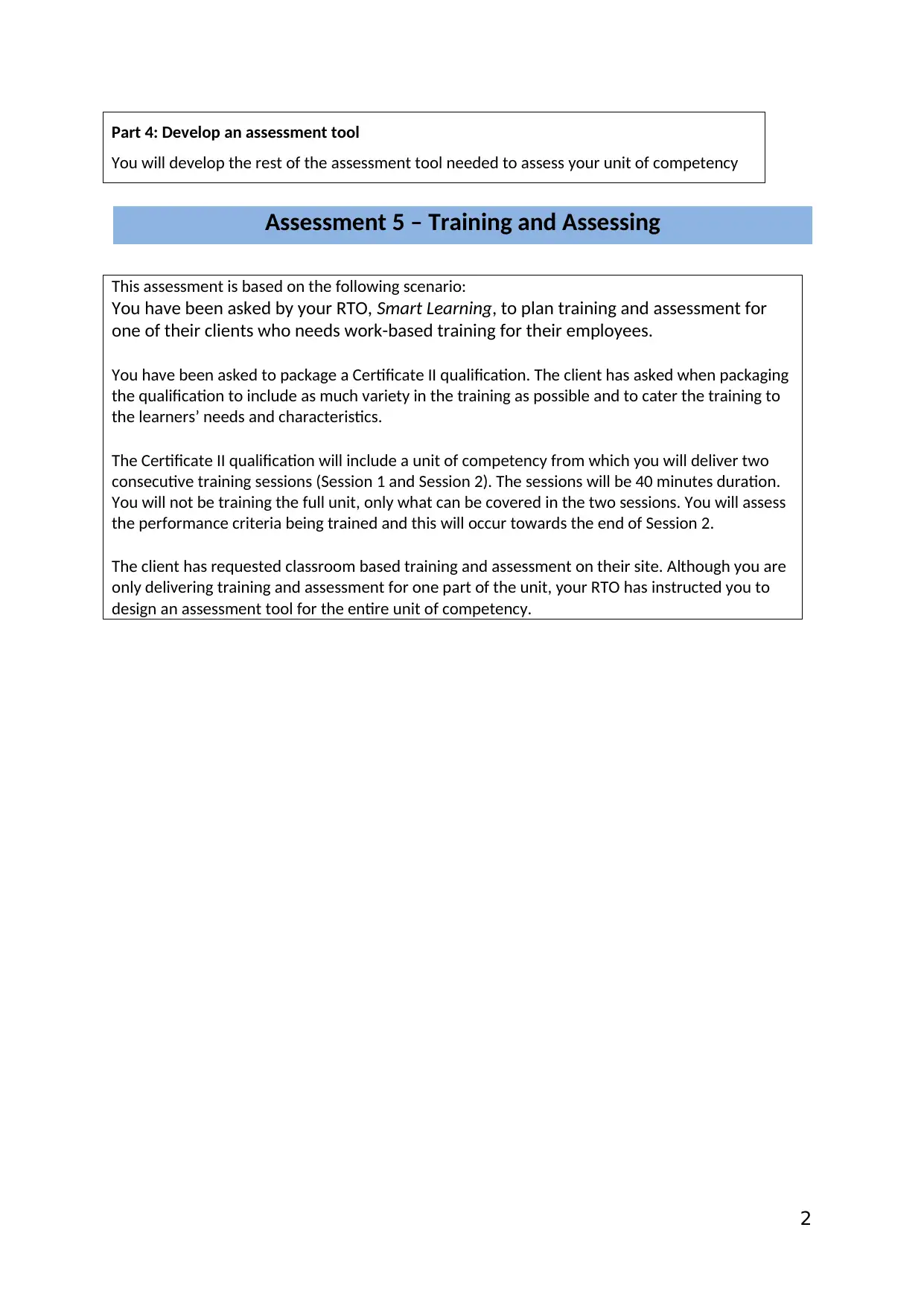
Part 4: Develop an assessment tool
You will develop the rest of the assessment tool needed to assess your unit of competency
This assessment is based on the following scenario:
You have been asked by your RTO, Smart Learning, to plan training and assessment for
one of their clients who needs work-based training for their employees.
You have been asked to package a Certificate II qualification. The client has asked when packaging
the qualification to include as much variety in the training as possible and to cater the training to
the learners’ needs and characteristics.
The Certificate II qualification will include a unit of competency from which you will deliver two
consecutive training sessions (Session 1 and Session 2). The sessions will be 40 minutes duration.
You will not be training the full unit, only what can be covered in the two sessions. You will assess
the performance criteria being trained and this will occur towards the end of Session 2.
The client has requested classroom based training and assessment on their site. Although you are
only delivering training and assessment for one part of the unit, your RTO has instructed you to
design an assessment tool for the entire unit of competency.
2
Assessment 5 – Training and Assessing
You will develop the rest of the assessment tool needed to assess your unit of competency
This assessment is based on the following scenario:
You have been asked by your RTO, Smart Learning, to plan training and assessment for
one of their clients who needs work-based training for their employees.
You have been asked to package a Certificate II qualification. The client has asked when packaging
the qualification to include as much variety in the training as possible and to cater the training to
the learners’ needs and characteristics.
The Certificate II qualification will include a unit of competency from which you will deliver two
consecutive training sessions (Session 1 and Session 2). The sessions will be 40 minutes duration.
You will not be training the full unit, only what can be covered in the two sessions. You will assess
the performance criteria being trained and this will occur towards the end of Session 2.
The client has requested classroom based training and assessment on their site. Although you are
only delivering training and assessment for one part of the unit, your RTO has instructed you to
design an assessment tool for the entire unit of competency.
2
Assessment 5 – Training and Assessing
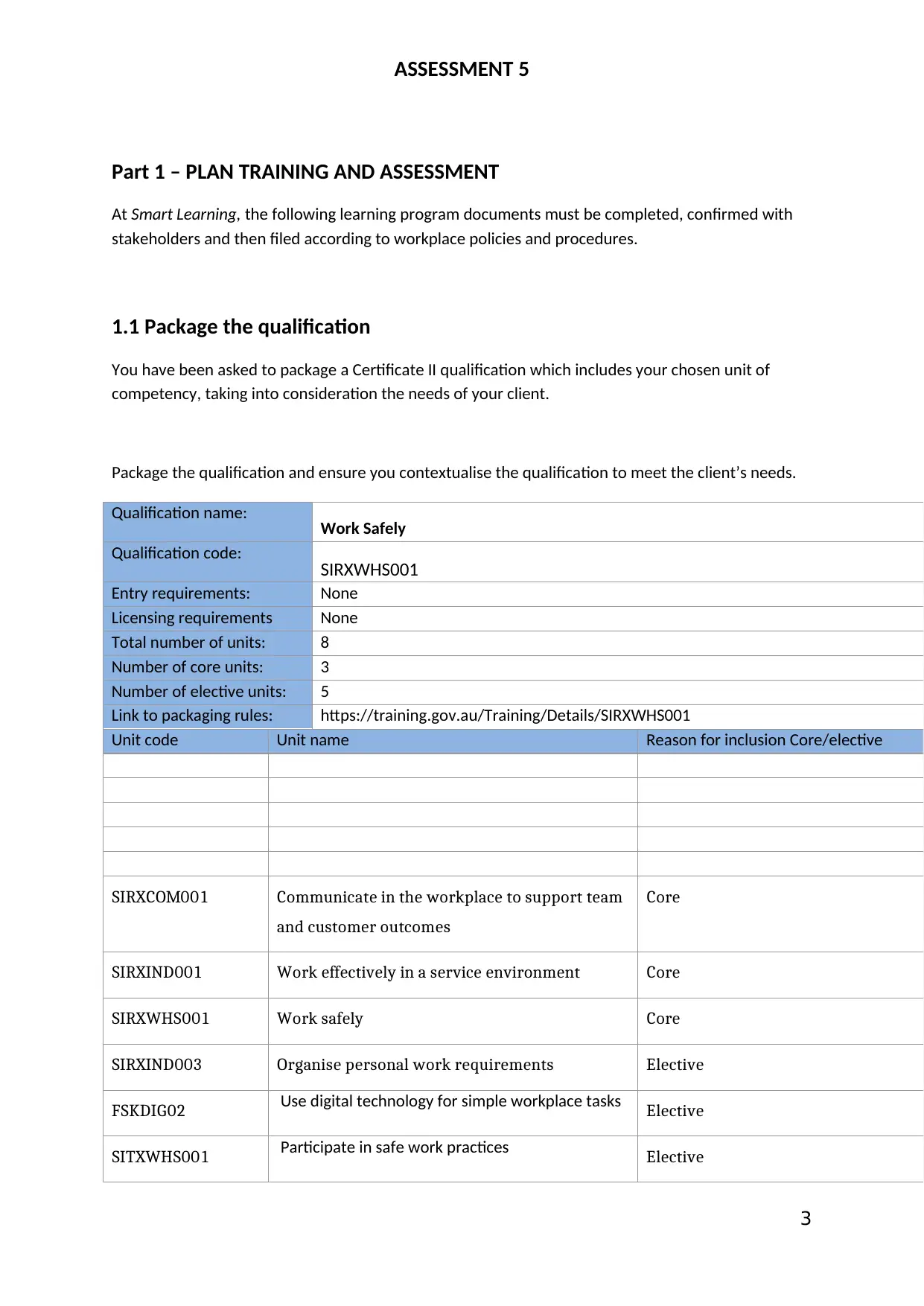
ASSESSMENT 5
Part 1 – PLAN TRAINING AND ASSESSMENT
At Smart Learning, the following learning program documents must be completed, confirmed with
stakeholders and then filed according to workplace policies and procedures.
1.1 Package the qualification
You have been asked to package a Certificate II qualification which includes your chosen unit of
competency, taking into consideration the needs of your client.
Package the qualification and ensure you contextualise the qualification to meet the client’s needs.
Qualification name: Work Safely
Qualification code: SIRXWHS001
Entry requirements: None
Licensing requirements None
Total number of units: 8
Number of core units: 3
Number of elective units: 5
Link to packaging rules: https://training.gov.au/Training/Details/SIRXWHS001
Unit code Unit name Reason for inclusion Core/elective
SIRXCOM001 Communicate in the workplace to support team
and customer outcomes
Core
SIRXIND001 Work effectively in a service environment Core
SIRXWHS001 Work safely Core
SIRXIND003 Organise personal work requirements Elective
FSKDIG02 Use digital technology for simple workplace tasks Elective
SITXWHS001 Participate in safe work practices Elective
3
Part 1 – PLAN TRAINING AND ASSESSMENT
At Smart Learning, the following learning program documents must be completed, confirmed with
stakeholders and then filed according to workplace policies and procedures.
1.1 Package the qualification
You have been asked to package a Certificate II qualification which includes your chosen unit of
competency, taking into consideration the needs of your client.
Package the qualification and ensure you contextualise the qualification to meet the client’s needs.
Qualification name: Work Safely
Qualification code: SIRXWHS001
Entry requirements: None
Licensing requirements None
Total number of units: 8
Number of core units: 3
Number of elective units: 5
Link to packaging rules: https://training.gov.au/Training/Details/SIRXWHS001
Unit code Unit name Reason for inclusion Core/elective
SIRXCOM001 Communicate in the workplace to support team
and customer outcomes
Core
SIRXIND001 Work effectively in a service environment Core
SIRXWHS001 Work safely Core
SIRXIND003 Organise personal work requirements Elective
FSKDIG02 Use digital technology for simple workplace tasks Elective
SITXWHS001 Participate in safe work practices Elective
3
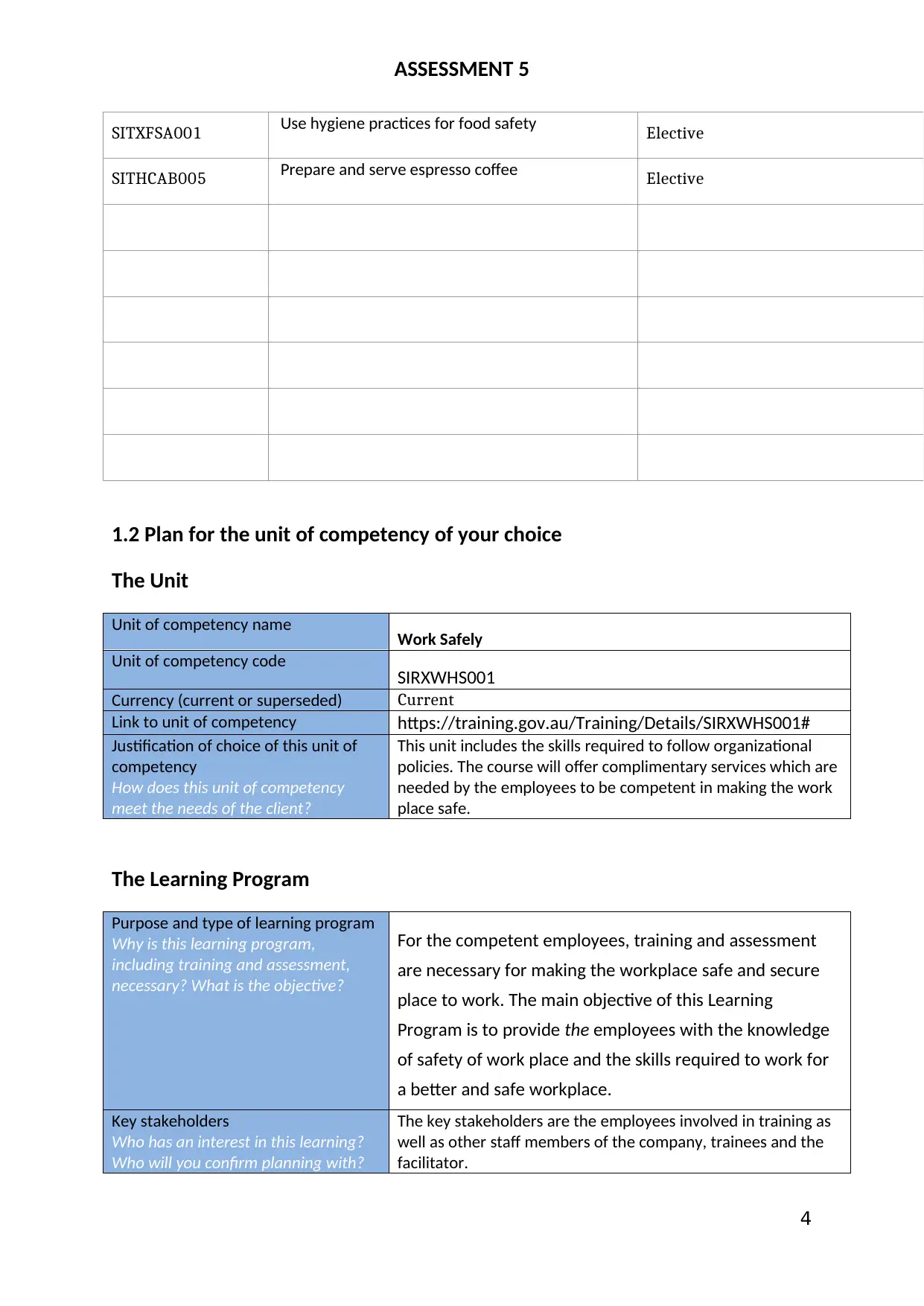
ASSESSMENT 5
SITXFSA001 Use hygiene practices for food safety Elective
SITHCAB005 Prepare and serve espresso coffee Elective
1.2 Plan for the unit of competency of your choice
The Unit
Unit of competency name Work Safely
Unit of competency code SIRXWHS001
Currency (current or superseded) Current
Link to unit of competency https://training.gov.au/Training/Details/SIRXWHS001#
Justification of choice of this unit of
competency
How does this unit of competency
meet the needs of the client?
This unit includes the skills required to follow organizational
policies. The course will offer complimentary services which are
needed by the employees to be competent in making the work
place safe.
The Learning Program
Purpose and type of learning program
Why is this learning program,
including training and assessment,
necessary? What is the objective?
For the competent employees, training and assessment
are necessary for making the workplace safe and secure
place to work. The main objective of this Learning
Program is to provide the employees with the knowledge
of safety of work place and the skills required to work for
a better and safe workplace.
Key stakeholders
Who has an interest in this learning?
Who will you confirm planning with?
The key stakeholders are the employees involved in training as
well as other staff members of the company, trainees and the
facilitator.
4
SITXFSA001 Use hygiene practices for food safety Elective
SITHCAB005 Prepare and serve espresso coffee Elective
1.2 Plan for the unit of competency of your choice
The Unit
Unit of competency name Work Safely
Unit of competency code SIRXWHS001
Currency (current or superseded) Current
Link to unit of competency https://training.gov.au/Training/Details/SIRXWHS001#
Justification of choice of this unit of
competency
How does this unit of competency
meet the needs of the client?
This unit includes the skills required to follow organizational
policies. The course will offer complimentary services which are
needed by the employees to be competent in making the work
place safe.
The Learning Program
Purpose and type of learning program
Why is this learning program,
including training and assessment,
necessary? What is the objective?
For the competent employees, training and assessment
are necessary for making the workplace safe and secure
place to work. The main objective of this Learning
Program is to provide the employees with the knowledge
of safety of work place and the skills required to work for
a better and safe workplace.
Key stakeholders
Who has an interest in this learning?
Who will you confirm planning with?
The key stakeholders are the employees involved in training as
well as other staff members of the company, trainees and the
facilitator.
4
Secure Best Marks with AI Grader
Need help grading? Try our AI Grader for instant feedback on your assignments.
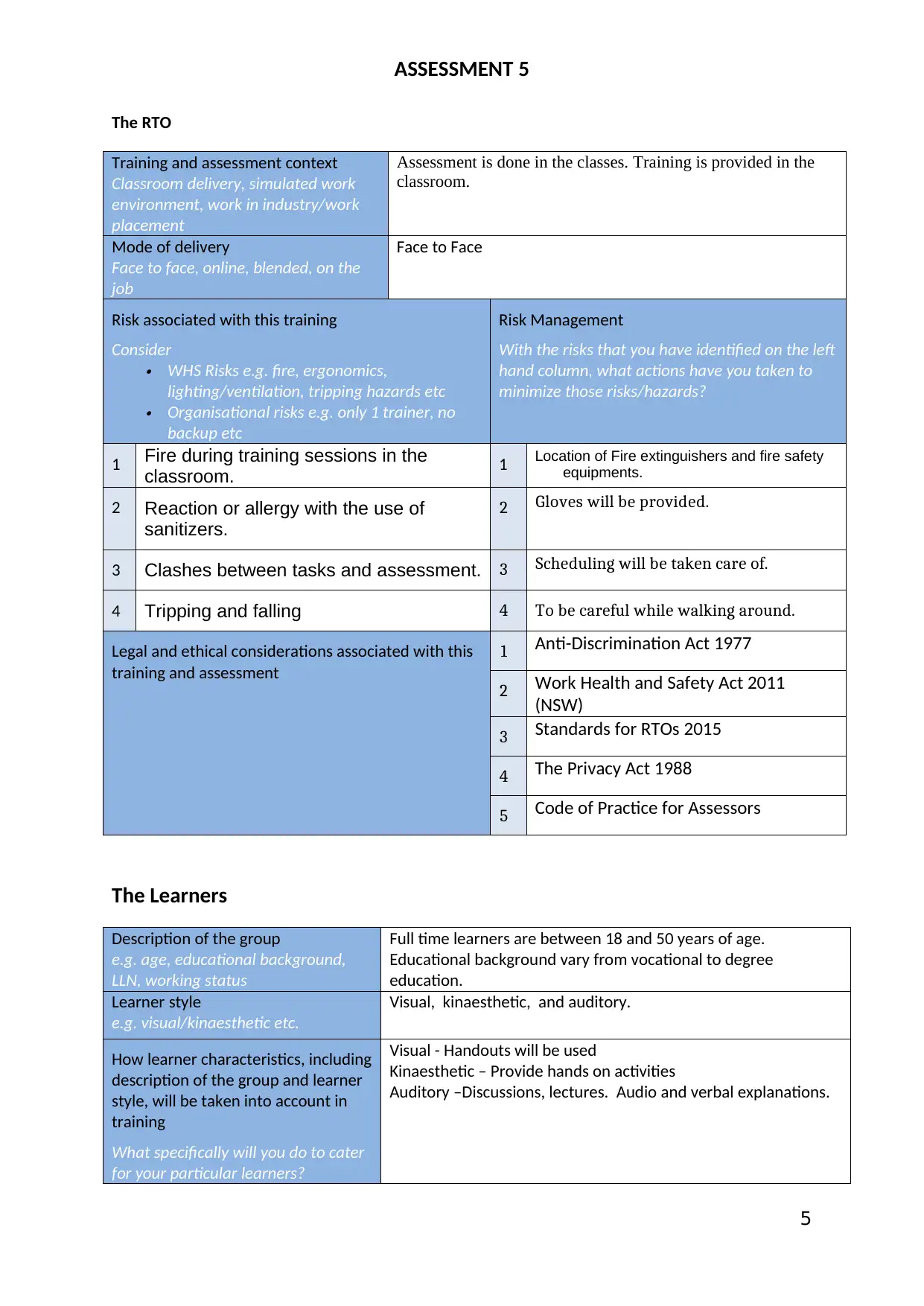
ASSESSMENT 5
The RTO
Training and assessment context
Classroom delivery, simulated work
environment, work in industry/work
placement
Assessment is done in the classes. Training is provided in the
classroom.
Mode of delivery
Face to face, online, blended, on the
job
Face to Face
Risk associated with this training
Consider
WHS Risks e.g. fire, ergonomics,
lighting/ventilation, tripping hazards etc
Organisational risks e.g. only 1 trainer, no
backup etc
Risk Management
With the risks that you have identified on the left
hand column, what actions have you taken to
minimize those risks/hazards?
1 Fire during training sessions in the
classroom. 1 Location of Fire extinguishers and fire safety
equipments.
2 Reaction or allergy with the use of
sanitizers.
2 Gloves will be provided.
3 Clashes between tasks and assessment. 3 Scheduling will be taken care of.
4 Tripping and falling 4 To be careful while walking around.
Legal and ethical considerations associated with this
training and assessment
1 Anti-Discrimination Act 1977
2 Work Health and Safety Act 2011
(NSW)
3 Standards for RTOs 2015
4 The Privacy Act 1988
5 Code of Practice for Assessors
The Learners
Description of the group
e.g. age, educational background,
LLN, working status
Full time learners are between 18 and 50 years of age.
Educational background vary from vocational to degree
education.
Learner style
e.g. visual/kinaesthetic etc.
Visual, kinaesthetic, and auditory.
How learner characteristics, including
description of the group and learner
style, will be taken into account in
training
What specifically will you do to cater
for your particular learners?
Visual - Handouts will be used
Kinaesthetic – Provide hands on activities
Auditory –Discussions, lectures. Audio and verbal explanations.
5
The RTO
Training and assessment context
Classroom delivery, simulated work
environment, work in industry/work
placement
Assessment is done in the classes. Training is provided in the
classroom.
Mode of delivery
Face to face, online, blended, on the
job
Face to Face
Risk associated with this training
Consider
WHS Risks e.g. fire, ergonomics,
lighting/ventilation, tripping hazards etc
Organisational risks e.g. only 1 trainer, no
backup etc
Risk Management
With the risks that you have identified on the left
hand column, what actions have you taken to
minimize those risks/hazards?
1 Fire during training sessions in the
classroom. 1 Location of Fire extinguishers and fire safety
equipments.
2 Reaction or allergy with the use of
sanitizers.
2 Gloves will be provided.
3 Clashes between tasks and assessment. 3 Scheduling will be taken care of.
4 Tripping and falling 4 To be careful while walking around.
Legal and ethical considerations associated with this
training and assessment
1 Anti-Discrimination Act 1977
2 Work Health and Safety Act 2011
(NSW)
3 Standards for RTOs 2015
4 The Privacy Act 1988
5 Code of Practice for Assessors
The Learners
Description of the group
e.g. age, educational background,
LLN, working status
Full time learners are between 18 and 50 years of age.
Educational background vary from vocational to degree
education.
Learner style
e.g. visual/kinaesthetic etc.
Visual, kinaesthetic, and auditory.
How learner characteristics, including
description of the group and learner
style, will be taken into account in
training
What specifically will you do to cater
for your particular learners?
Visual - Handouts will be used
Kinaesthetic – Provide hands on activities
Auditory –Discussions, lectures. Audio and verbal explanations.
5
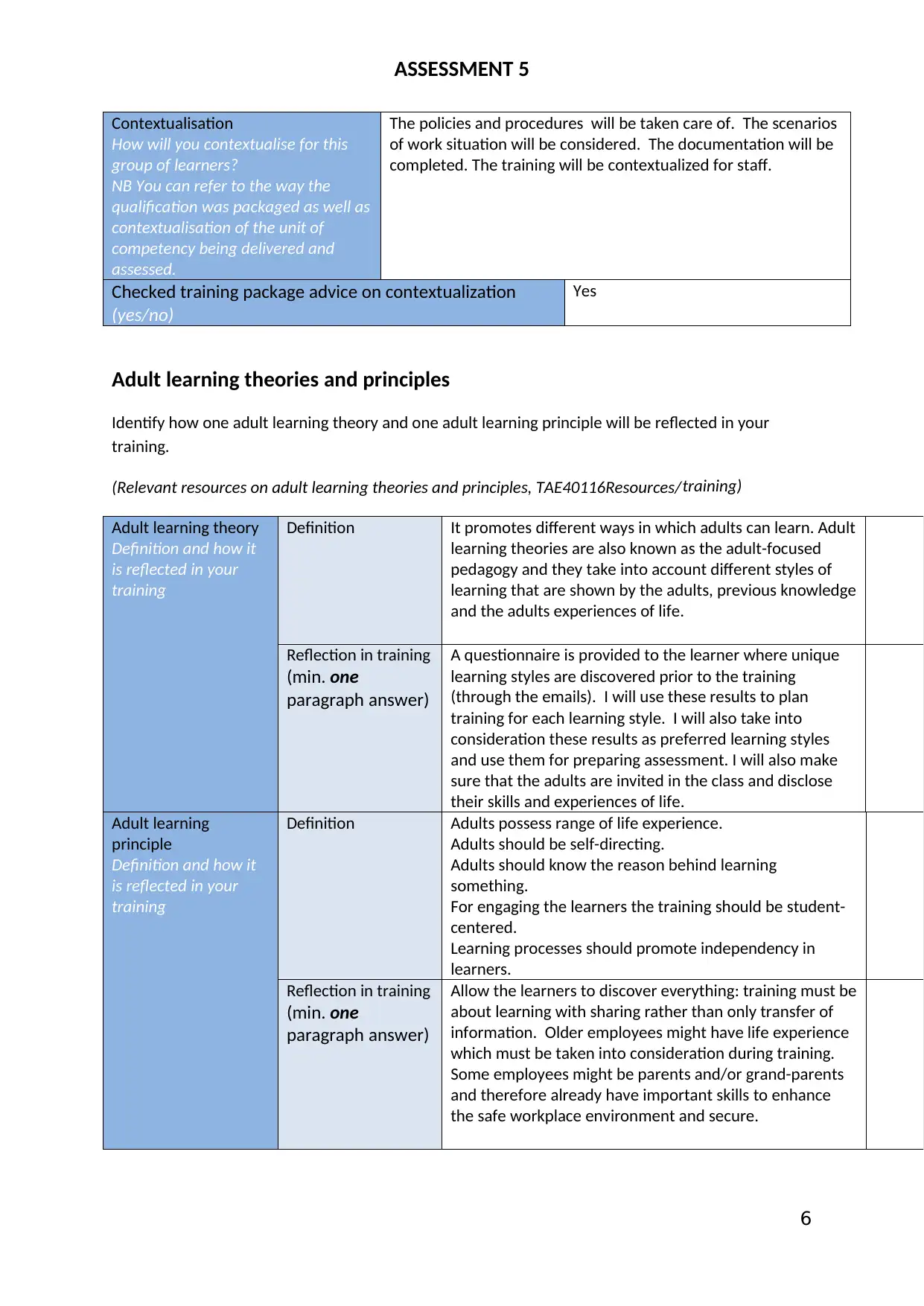
ASSESSMENT 5
Contextualisation
How will you contextualise for this
group of learners?
NB You can refer to the way the
qualification was packaged as well as
contextualisation of the unit of
competency being delivered and
assessed.
The policies and procedures will be taken care of. The scenarios
of work situation will be considered. The documentation will be
completed. The training will be contextualized for staff.
Checked training package advice on contextualization
(yes/no)
Yes
Adult learning theories and principles
Identify how one adult learning theory and one adult learning principle will be reflected in your
training.
(Relevant resources on adult learning theories and principles, TAE40116Resources/training)
Adult learning theory
Definition and how it
is reflected in your
training
Definition It promotes different ways in which adults can learn. Adult
learning theories are also known as the adult-focused
pedagogy and they take into account different styles of
learning that are shown by the adults, previous knowledge
and the adults experiences of life.
Reflection in training
(min. one
paragraph answer)
A questionnaire is provided to the learner where unique
learning styles are discovered prior to the training
(through the emails). I will use these results to plan
training for each learning style. I will also take into
consideration these results as preferred learning styles
and use them for preparing assessment. I will also make
sure that the adults are invited in the class and disclose
their skills and experiences of life.
Adult learning
principle
Definition and how it
is reflected in your
training
Definition Adults possess range of life experience.
Adults should be self-directing.
Adults should know the reason behind learning
something.
For engaging the learners the training should be student-
centered.
Learning processes should promote independency in
learners.
Reflection in training
(min. one
paragraph answer)
Allow the learners to discover everything: training must be
about learning with sharing rather than only transfer of
information. Older employees might have life experience
which must be taken into consideration during training.
Some employees might be parents and/or grand-parents
and therefore already have important skills to enhance
the safe workplace environment and secure.
6
Contextualisation
How will you contextualise for this
group of learners?
NB You can refer to the way the
qualification was packaged as well as
contextualisation of the unit of
competency being delivered and
assessed.
The policies and procedures will be taken care of. The scenarios
of work situation will be considered. The documentation will be
completed. The training will be contextualized for staff.
Checked training package advice on contextualization
(yes/no)
Yes
Adult learning theories and principles
Identify how one adult learning theory and one adult learning principle will be reflected in your
training.
(Relevant resources on adult learning theories and principles, TAE40116Resources/training)
Adult learning theory
Definition and how it
is reflected in your
training
Definition It promotes different ways in which adults can learn. Adult
learning theories are also known as the adult-focused
pedagogy and they take into account different styles of
learning that are shown by the adults, previous knowledge
and the adults experiences of life.
Reflection in training
(min. one
paragraph answer)
A questionnaire is provided to the learner where unique
learning styles are discovered prior to the training
(through the emails). I will use these results to plan
training for each learning style. I will also take into
consideration these results as preferred learning styles
and use them for preparing assessment. I will also make
sure that the adults are invited in the class and disclose
their skills and experiences of life.
Adult learning
principle
Definition and how it
is reflected in your
training
Definition Adults possess range of life experience.
Adults should be self-directing.
Adults should know the reason behind learning
something.
For engaging the learners the training should be student-
centered.
Learning processes should promote independency in
learners.
Reflection in training
(min. one
paragraph answer)
Allow the learners to discover everything: training must be
about learning with sharing rather than only transfer of
information. Older employees might have life experience
which must be taken into consideration during training.
Some employees might be parents and/or grand-parents
and therefore already have important skills to enhance
the safe workplace environment and secure.
6

ASSESSMENT 5
7
7
Paraphrase This Document
Need a fresh take? Get an instant paraphrase of this document with our AI Paraphraser
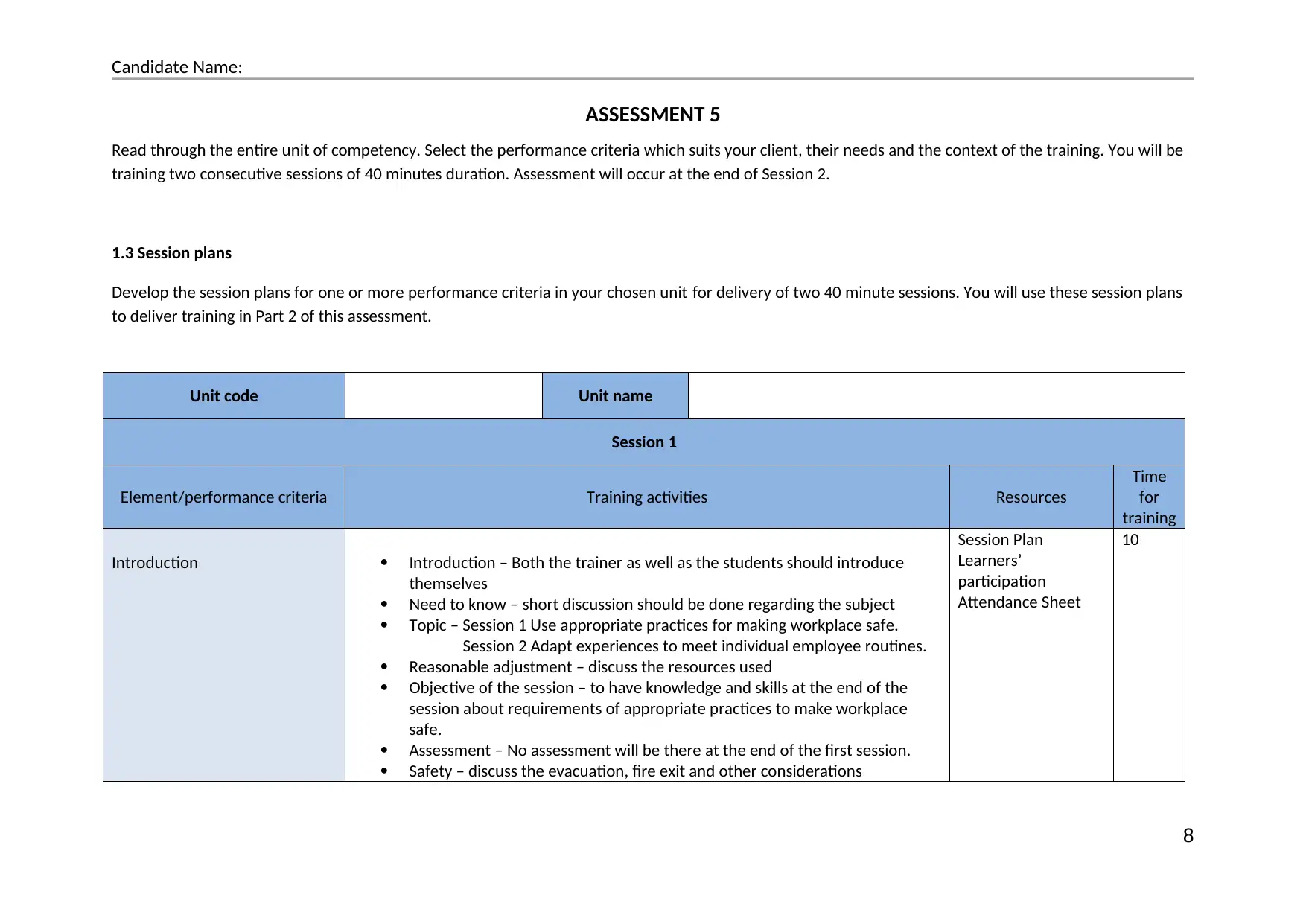
Candidate Name:
ASSESSMENT 5
Read through the entire unit of competency. Select the performance criteria which suits your client, their needs and the context of the training. You will be
training two consecutive sessions of 40 minutes duration. Assessment will occur at the end of Session 2.
1.3 Session plans
Develop the session plans for one or more performance criteria in your chosen unit for delivery of two 40 minute sessions. You will use these session plans
to deliver training in Part 2 of this assessment.
Unit code Unit name
Session 1
Element/performance criteria Training activities Resources
Time
for
training
Introduction Introduction – Both the trainer as well as the students should introduce
themselves
Need to know – short discussion should be done regarding the subject
Topic – Session 1 Use appropriate practices for making workplace safe.
Session 2 Adapt experiences to meet individual employee routines.
Reasonable adjustment – discuss the resources used
Objective of the session – to have knowledge and skills at the end of the
session about requirements of appropriate practices to make workplace
safe.
Assessment – No assessment will be there at the end of the first session.
Safety – discuss the evacuation, fire exit and other considerations
Session Plan
Learners’
participation
Attendance Sheet
10
8
ASSESSMENT 5
Read through the entire unit of competency. Select the performance criteria which suits your client, their needs and the context of the training. You will be
training two consecutive sessions of 40 minutes duration. Assessment will occur at the end of Session 2.
1.3 Session plans
Develop the session plans for one or more performance criteria in your chosen unit for delivery of two 40 minute sessions. You will use these session plans
to deliver training in Part 2 of this assessment.
Unit code Unit name
Session 1
Element/performance criteria Training activities Resources
Time
for
training
Introduction Introduction – Both the trainer as well as the students should introduce
themselves
Need to know – short discussion should be done regarding the subject
Topic – Session 1 Use appropriate practices for making workplace safe.
Session 2 Adapt experiences to meet individual employee routines.
Reasonable adjustment – discuss the resources used
Objective of the session – to have knowledge and skills at the end of the
session about requirements of appropriate practices to make workplace
safe.
Assessment – No assessment will be there at the end of the first session.
Safety – discuss the evacuation, fire exit and other considerations
Session Plan
Learners’
participation
Attendance Sheet
10
8
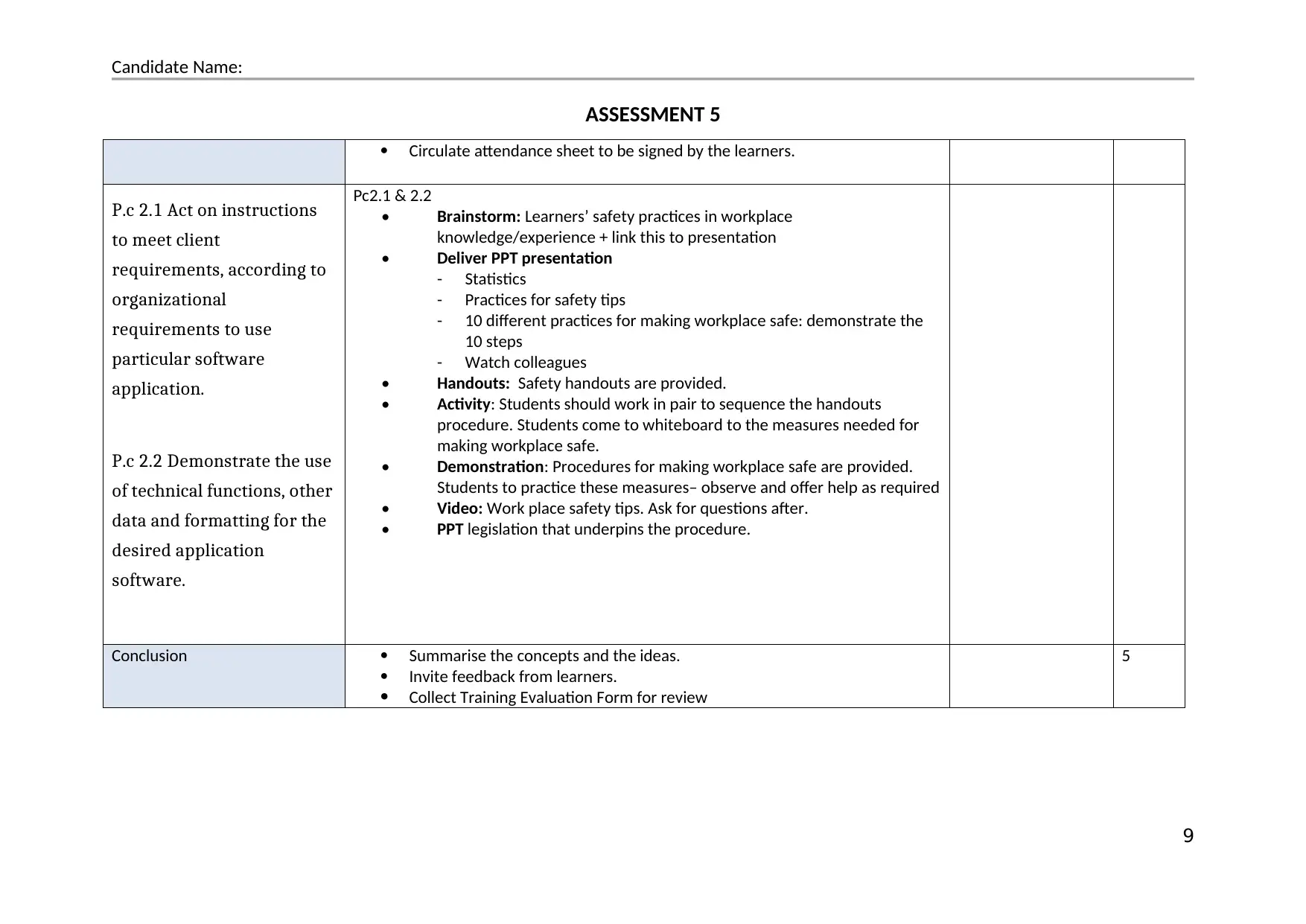
Candidate Name:
ASSESSMENT 5
Circulate attendance sheet to be signed by the learners.
P.c 2.1 Act on instructions
to meet client
requirements, according to
organizational
requirements to use
particular software
application.
P.c 2.2 Demonstrate the use
of technical functions, other
data and formatting for the
desired application
software.
Pc2.1 & 2.2
• Brainstorm: Learners’ safety practices in workplace
knowledge/experience + link this to presentation
• Deliver PPT presentation
- Statistics
- Practices for safety tips
- 10 different practices for making workplace safe: demonstrate the
10 steps
- Watch colleagues
• Handouts: Safety handouts are provided.
• Activity: Students should work in pair to sequence the handouts
procedure. Students come to whiteboard to the measures needed for
making workplace safe.
• Demonstration: Procedures for making workplace safe are provided.
Students to practice these measures– observe and offer help as required
• Video: Work place safety tips. Ask for questions after.
• PPT legislation that underpins the procedure.
Conclusion Summarise the concepts and the ideas.
Invite feedback from learners.
Collect Training Evaluation Form for review
5
9
ASSESSMENT 5
Circulate attendance sheet to be signed by the learners.
P.c 2.1 Act on instructions
to meet client
requirements, according to
organizational
requirements to use
particular software
application.
P.c 2.2 Demonstrate the use
of technical functions, other
data and formatting for the
desired application
software.
Pc2.1 & 2.2
• Brainstorm: Learners’ safety practices in workplace
knowledge/experience + link this to presentation
• Deliver PPT presentation
- Statistics
- Practices for safety tips
- 10 different practices for making workplace safe: demonstrate the
10 steps
- Watch colleagues
• Handouts: Safety handouts are provided.
• Activity: Students should work in pair to sequence the handouts
procedure. Students come to whiteboard to the measures needed for
making workplace safe.
• Demonstration: Procedures for making workplace safe are provided.
Students to practice these measures– observe and offer help as required
• Video: Work place safety tips. Ask for questions after.
• PPT legislation that underpins the procedure.
Conclusion Summarise the concepts and the ideas.
Invite feedback from learners.
Collect Training Evaluation Form for review
5
9
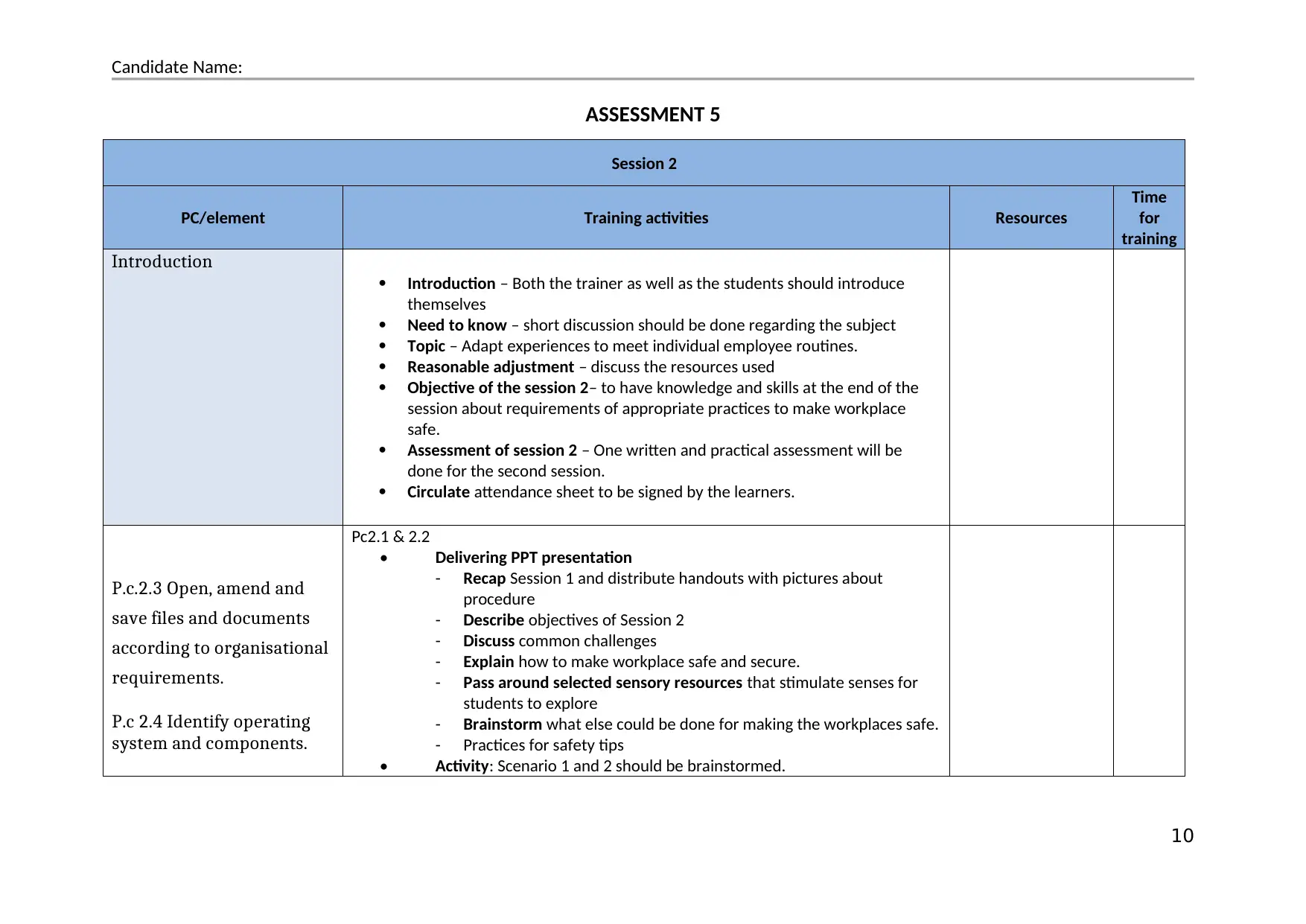
Candidate Name:
ASSESSMENT 5
Session 2
PC/element Training activities Resources
Time
for
training
Introduction
Introduction – Both the trainer as well as the students should introduce
themselves
Need to know – short discussion should be done regarding the subject
Topic – Adapt experiences to meet individual employee routines.
Reasonable adjustment – discuss the resources used
Objective of the session 2– to have knowledge and skills at the end of the
session about requirements of appropriate practices to make workplace
safe.
Assessment of session 2 – One written and practical assessment will be
done for the second session.
Circulate attendance sheet to be signed by the learners.
P.c.2.3 Open, amend and
save files and documents
according to organisational
requirements.
P.c 2.4 Identify operating
system and components.
Pc2.1 & 2.2
• Delivering PPT presentation
- Recap Session 1 and distribute handouts with pictures about
procedure
- Describe objectives of Session 2
- Discuss common challenges
- Explain how to make workplace safe and secure.
- Pass around selected sensory resources that stimulate senses for
students to explore
- Brainstorm what else could be done for making the workplaces safe.
- Practices for safety tips
• Activity: Scenario 1 and 2 should be brainstormed.
10
ASSESSMENT 5
Session 2
PC/element Training activities Resources
Time
for
training
Introduction
Introduction – Both the trainer as well as the students should introduce
themselves
Need to know – short discussion should be done regarding the subject
Topic – Adapt experiences to meet individual employee routines.
Reasonable adjustment – discuss the resources used
Objective of the session 2– to have knowledge and skills at the end of the
session about requirements of appropriate practices to make workplace
safe.
Assessment of session 2 – One written and practical assessment will be
done for the second session.
Circulate attendance sheet to be signed by the learners.
P.c.2.3 Open, amend and
save files and documents
according to organisational
requirements.
P.c 2.4 Identify operating
system and components.
Pc2.1 & 2.2
• Delivering PPT presentation
- Recap Session 1 and distribute handouts with pictures about
procedure
- Describe objectives of Session 2
- Discuss common challenges
- Explain how to make workplace safe and secure.
- Pass around selected sensory resources that stimulate senses for
students to explore
- Brainstorm what else could be done for making the workplaces safe.
- Practices for safety tips
• Activity: Scenario 1 and 2 should be brainstormed.
10
Secure Best Marks with AI Grader
Need help grading? Try our AI Grader for instant feedback on your assignments.
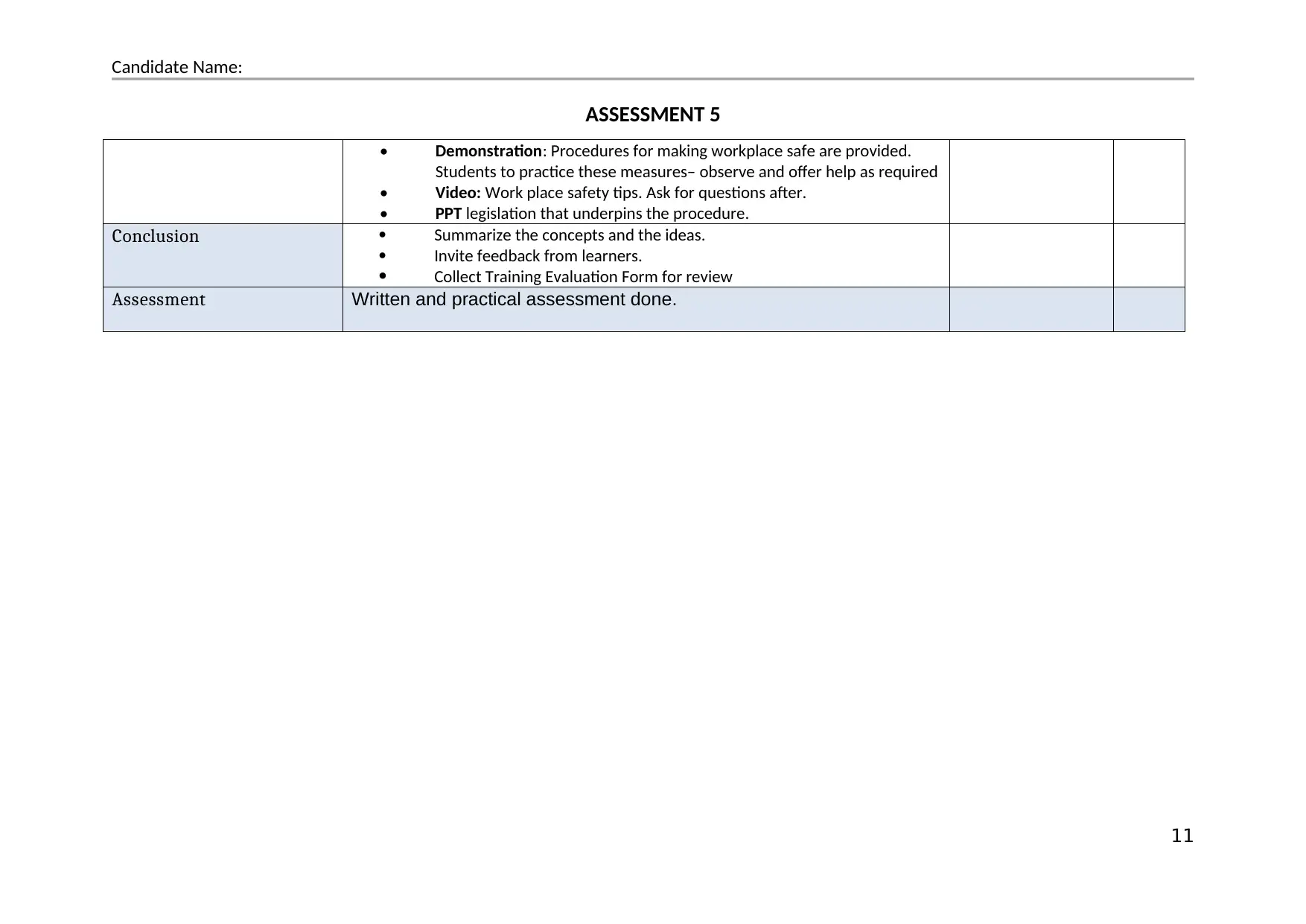
Candidate Name:
ASSESSMENT 5
• Demonstration: Procedures for making workplace safe are provided.
Students to practice these measures– observe and offer help as required
• Video: Work place safety tips. Ask for questions after.
• PPT legislation that underpins the procedure.
Conclusion Summarize the concepts and the ideas.
Invite feedback from learners.
Collect Training Evaluation Form for review
Assessment Written and practical assessment done.
11
ASSESSMENT 5
• Demonstration: Procedures for making workplace safe are provided.
Students to practice these measures– observe and offer help as required
• Video: Work place safety tips. Ask for questions after.
• PPT legislation that underpins the procedure.
Conclusion Summarize the concepts and the ideas.
Invite feedback from learners.
Collect Training Evaluation Form for review
Assessment Written and practical assessment done.
11
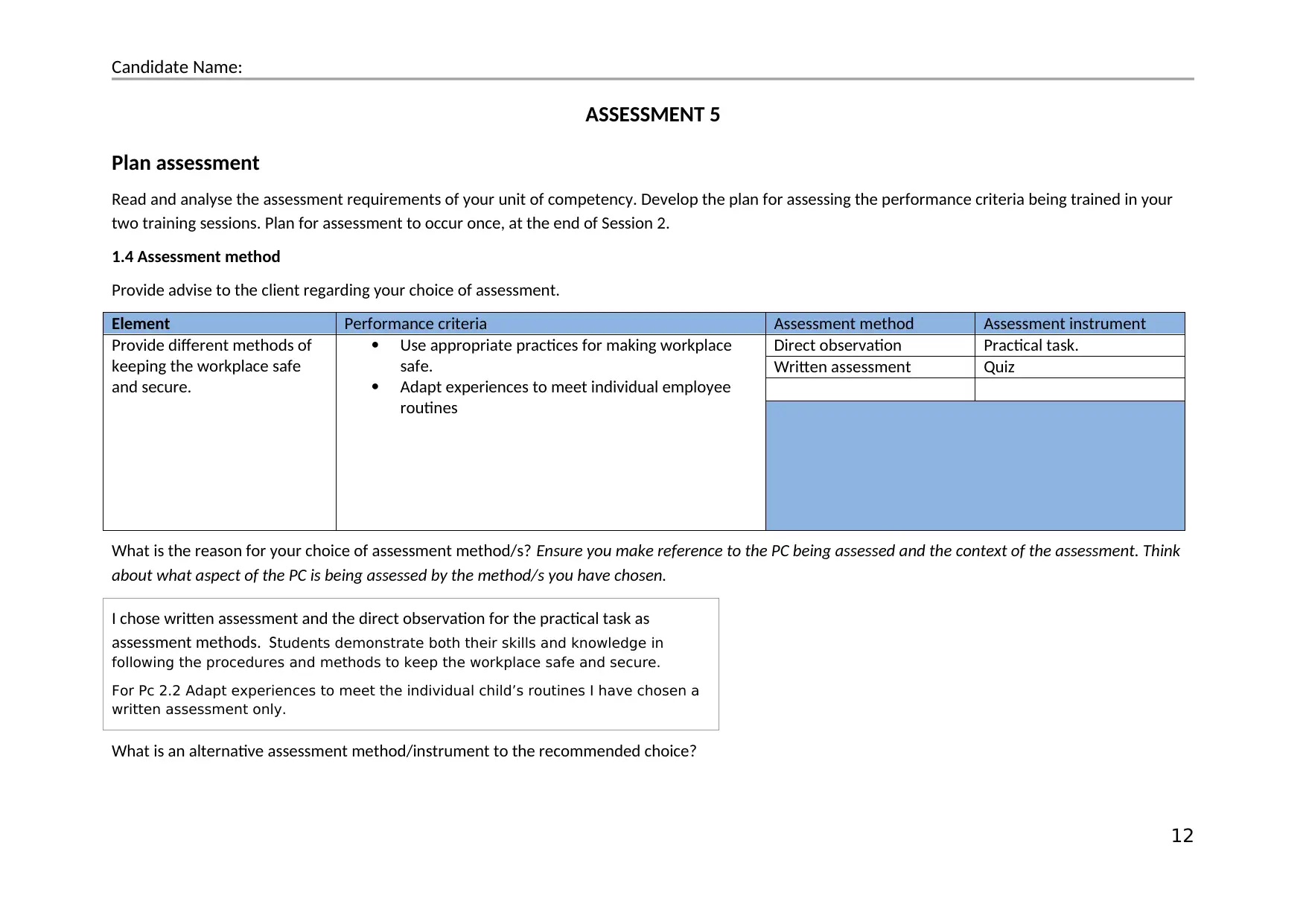
Candidate Name:
ASSESSMENT 5
Plan assessment
Read and analyse the assessment requirements of your unit of competency. Develop the plan for assessing the performance criteria being trained in your
two training sessions. Plan for assessment to occur once, at the end of Session 2.
1.4 Assessment method
Provide advise to the client regarding your choice of assessment.
Element Performance criteria Assessment method Assessment instrument
Provide different methods of
keeping the workplace safe
and secure.
Use appropriate practices for making workplace
safe.
Adapt experiences to meet individual employee
routines
Direct observation Practical task.
Written assessment Quiz
What is the reason for your choice of assessment method/s? Ensure you make reference to the PC being assessed and the context of the assessment. Think
about what aspect of the PC is being assessed by the method/s you have chosen.
I chose written assessment and the direct observation for the practical task as
assessment methods. Students demonstrate both their skills and knowledge in
following the procedures and methods to keep the workplace safe and secure.
For Pc 2.2 Adapt experiences to meet the individual child’s routines I have chosen a
written assessment only.
What is an alternative assessment method/instrument to the recommended choice?
12
ASSESSMENT 5
Plan assessment
Read and analyse the assessment requirements of your unit of competency. Develop the plan for assessing the performance criteria being trained in your
two training sessions. Plan for assessment to occur once, at the end of Session 2.
1.4 Assessment method
Provide advise to the client regarding your choice of assessment.
Element Performance criteria Assessment method Assessment instrument
Provide different methods of
keeping the workplace safe
and secure.
Use appropriate practices for making workplace
safe.
Adapt experiences to meet individual employee
routines
Direct observation Practical task.
Written assessment Quiz
What is the reason for your choice of assessment method/s? Ensure you make reference to the PC being assessed and the context of the assessment. Think
about what aspect of the PC is being assessed by the method/s you have chosen.
I chose written assessment and the direct observation for the practical task as
assessment methods. Students demonstrate both their skills and knowledge in
following the procedures and methods to keep the workplace safe and secure.
For Pc 2.2 Adapt experiences to meet the individual child’s routines I have chosen a
written assessment only.
What is an alternative assessment method/instrument to the recommended choice?
12
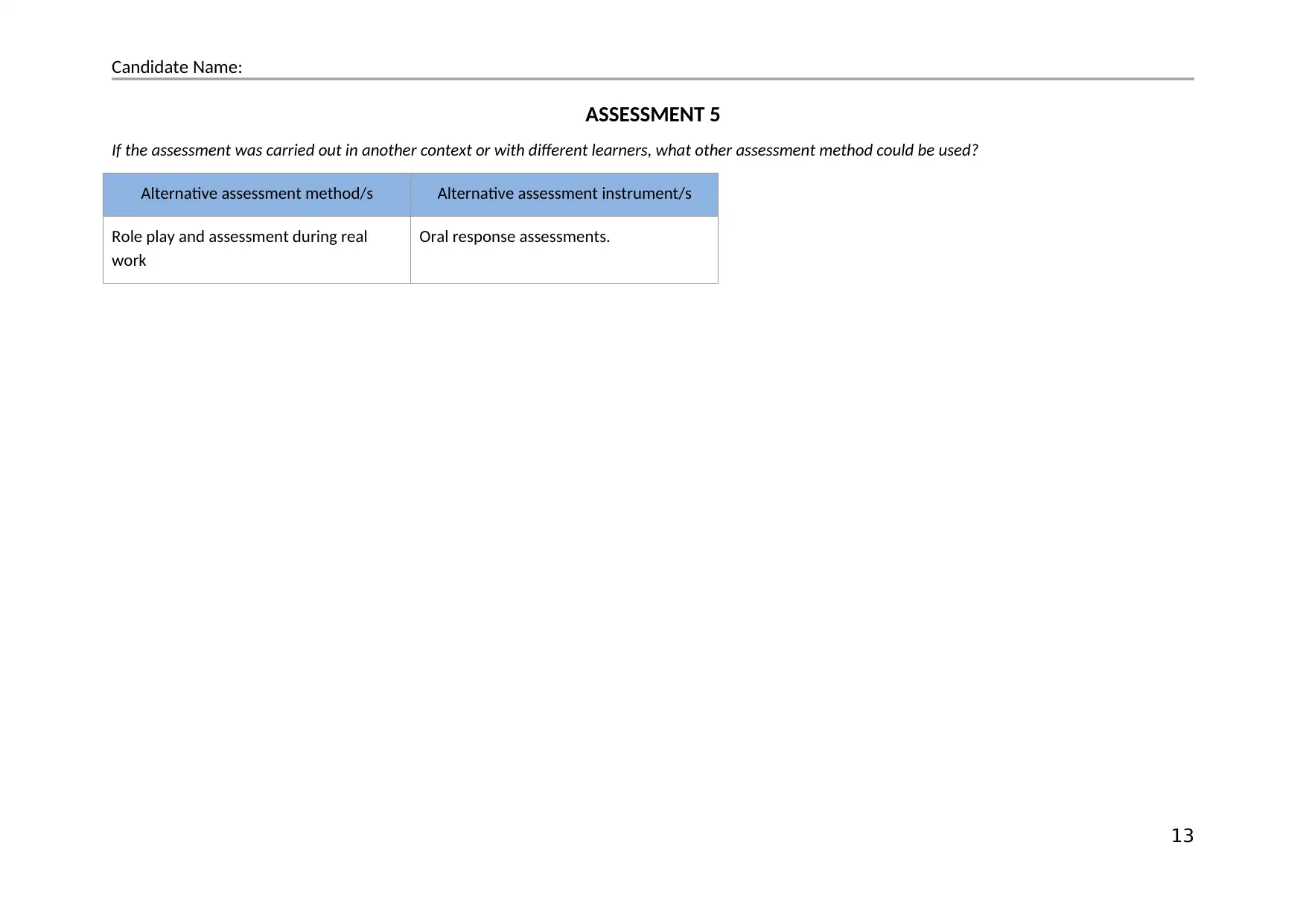
Candidate Name:
ASSESSMENT 5
If the assessment was carried out in another context or with different learners, what other assessment method could be used?
Alternative assessment method/s Alternative assessment instrument/s
Role play and assessment during real
work
Oral response assessments.
13
ASSESSMENT 5
If the assessment was carried out in another context or with different learners, what other assessment method could be used?
Alternative assessment method/s Alternative assessment instrument/s
Role play and assessment during real
work
Oral response assessments.
13
Paraphrase This Document
Need a fresh take? Get an instant paraphrase of this document with our AI Paraphraser
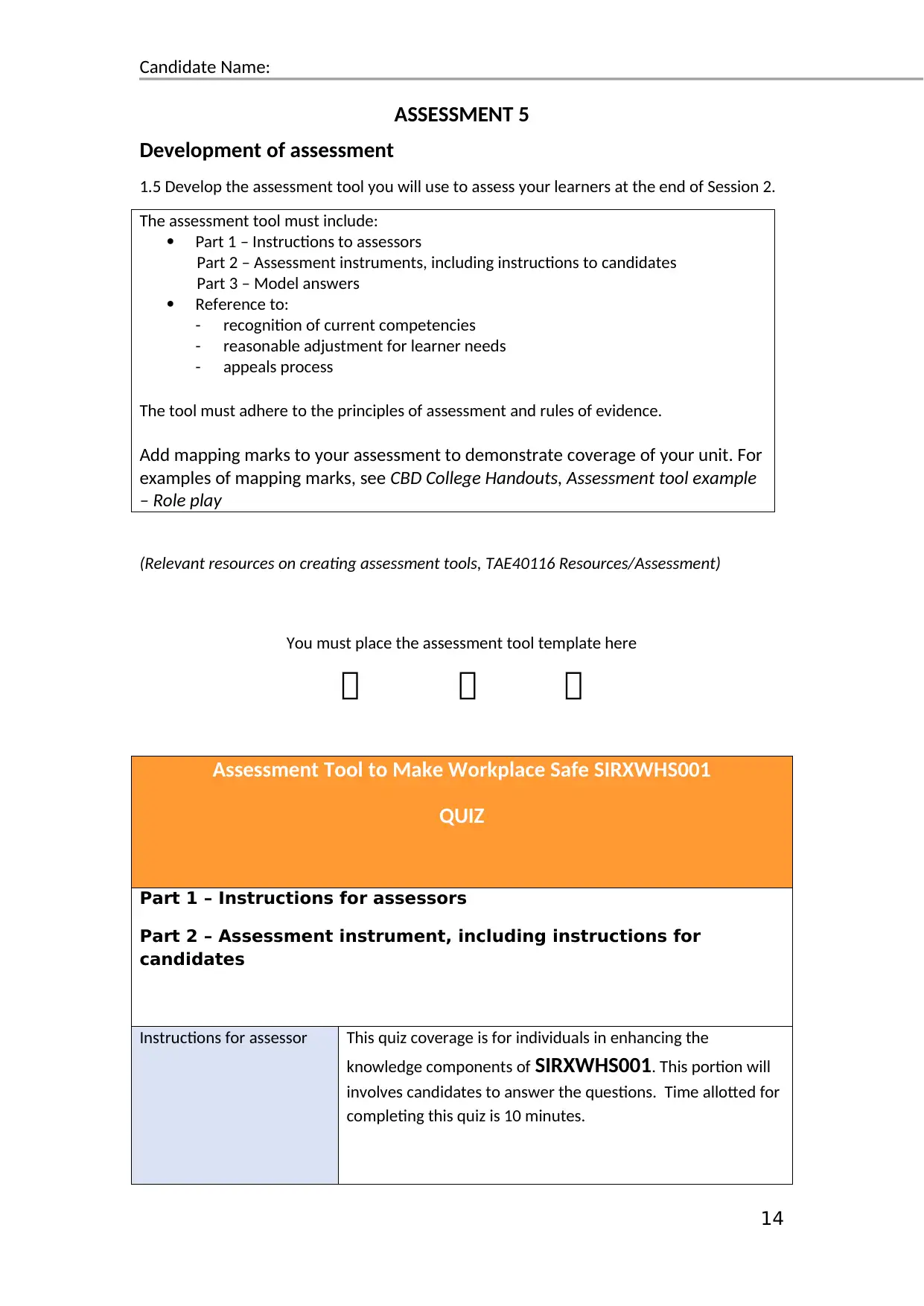
Candidate Name:
ASSESSMENT 5
Development of assessment
1.5 Develop the assessment tool you will use to assess your learners at the end of Session 2.
The assessment tool must include:
Part 1 – Instructions to assessors
Part 2 – Assessment instruments, including instructions to candidates
Part 3 – Model answers
Reference to:
- recognition of current competencies
- reasonable adjustment for learner needs
- appeals process
The tool must adhere to the principles of assessment and rules of evidence.
Add mapping marks to your assessment to demonstrate coverage of your unit. For
examples of mapping marks, see CBD College Handouts, Assessment tool example
– Role play
(Relevant resources on creating assessment tools, TAE40116 Resources/Assessment)
You must place the assessment tool template here
Assessment Tool to Make Workplace Safe SIRXWHS001
QUIZ
Part 1 – Instructions for assessors
Part 2 – Assessment instrument, including instructions for
candidates
Instructions for assessor This quiz coverage is for individuals in enhancing the
knowledge components of SIRXWHS001. This portion will
involves candidates to answer the questions. Time allotted for
completing this quiz is 10 minutes.
14
ASSESSMENT 5
Development of assessment
1.5 Develop the assessment tool you will use to assess your learners at the end of Session 2.
The assessment tool must include:
Part 1 – Instructions to assessors
Part 2 – Assessment instruments, including instructions to candidates
Part 3 – Model answers
Reference to:
- recognition of current competencies
- reasonable adjustment for learner needs
- appeals process
The tool must adhere to the principles of assessment and rules of evidence.
Add mapping marks to your assessment to demonstrate coverage of your unit. For
examples of mapping marks, see CBD College Handouts, Assessment tool example
– Role play
(Relevant resources on creating assessment tools, TAE40116 Resources/Assessment)
You must place the assessment tool template here
Assessment Tool to Make Workplace Safe SIRXWHS001
QUIZ
Part 1 – Instructions for assessors
Part 2 – Assessment instrument, including instructions for
candidates
Instructions for assessor This quiz coverage is for individuals in enhancing the
knowledge components of SIRXWHS001. This portion will
involves candidates to answer the questions. Time allotted for
completing this quiz is 10 minutes.
14
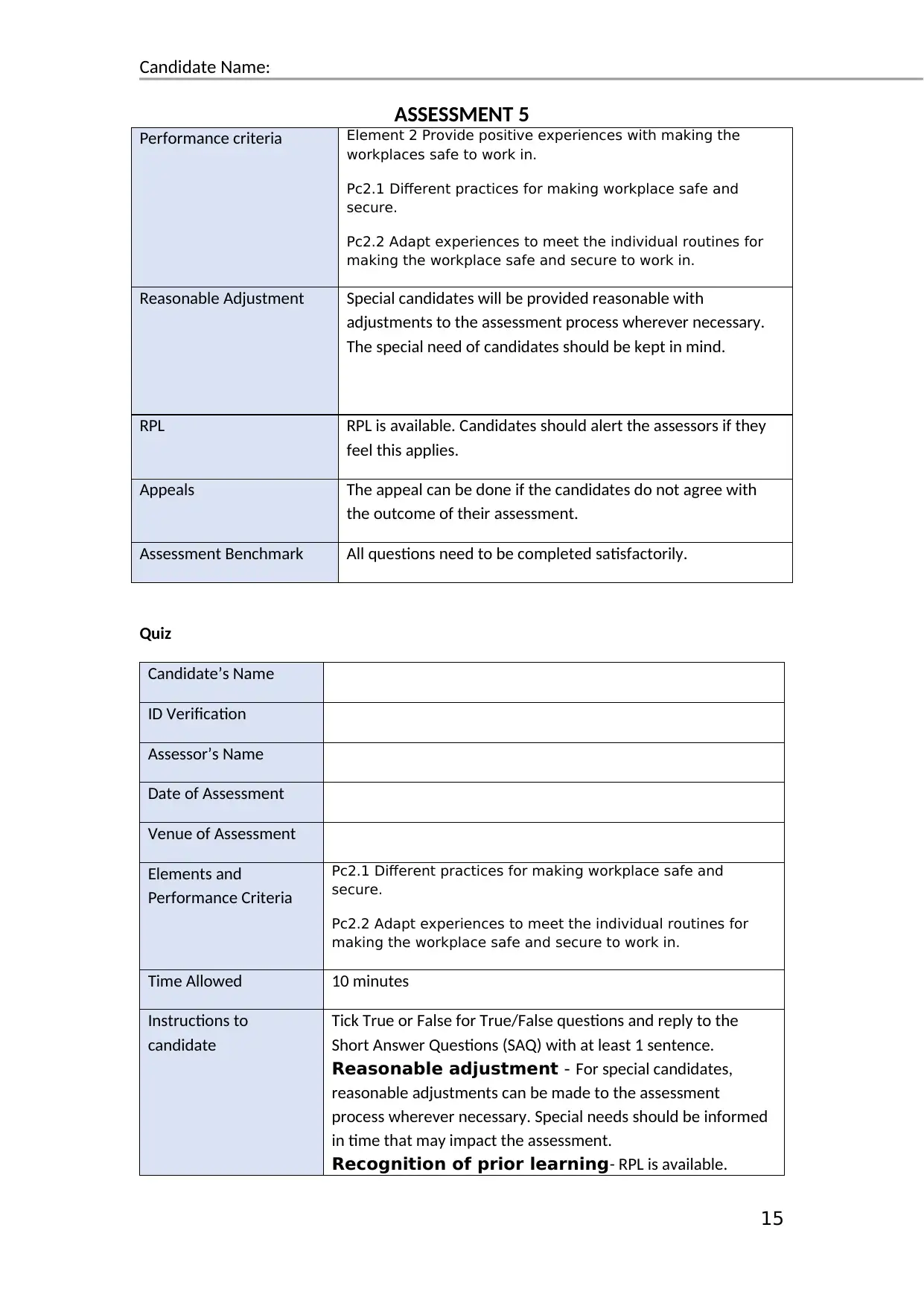
Candidate Name:
ASSESSMENT 5
Performance criteria Element 2 Provide positive experiences with making the
workplaces safe to work in.
Pc2.1 Different practices for making workplace safe and
secure.
Pc2.2 Adapt experiences to meet the individual routines for
making the workplace safe and secure to work in.
Reasonable Adjustment Special candidates will be provided reasonable with
adjustments to the assessment process wherever necessary.
The special need of candidates should be kept in mind.
RPL RPL is available. Candidates should alert the assessors if they
feel this applies.
Appeals The appeal can be done if the candidates do not agree with
the outcome of their assessment.
Assessment Benchmark All questions need to be completed satisfactorily.
Quiz
Candidate’s Name
ID Verification
Assessor’s Name
Date of Assessment
Venue of Assessment
Elements and
Performance Criteria
Pc2.1 Different practices for making workplace safe and
secure.
Pc2.2 Adapt experiences to meet the individual routines for
making the workplace safe and secure to work in.
Time Allowed 10 minutes
Instructions to
candidate
Tick True or False for True/False questions and reply to the
Short Answer Questions (SAQ) with at least 1 sentence.
Reasonable adjustment - For special candidates,
reasonable adjustments can be made to the assessment
process wherever necessary. Special needs should be informed
in time that may impact the assessment.
Recognition of prior learning- RPL is available.
15
ASSESSMENT 5
Performance criteria Element 2 Provide positive experiences with making the
workplaces safe to work in.
Pc2.1 Different practices for making workplace safe and
secure.
Pc2.2 Adapt experiences to meet the individual routines for
making the workplace safe and secure to work in.
Reasonable Adjustment Special candidates will be provided reasonable with
adjustments to the assessment process wherever necessary.
The special need of candidates should be kept in mind.
RPL RPL is available. Candidates should alert the assessors if they
feel this applies.
Appeals The appeal can be done if the candidates do not agree with
the outcome of their assessment.
Assessment Benchmark All questions need to be completed satisfactorily.
Quiz
Candidate’s Name
ID Verification
Assessor’s Name
Date of Assessment
Venue of Assessment
Elements and
Performance Criteria
Pc2.1 Different practices for making workplace safe and
secure.
Pc2.2 Adapt experiences to meet the individual routines for
making the workplace safe and secure to work in.
Time Allowed 10 minutes
Instructions to
candidate
Tick True or False for True/False questions and reply to the
Short Answer Questions (SAQ) with at least 1 sentence.
Reasonable adjustment - For special candidates,
reasonable adjustments can be made to the assessment
process wherever necessary. Special needs should be informed
in time that may impact the assessment.
Recognition of prior learning- RPL is available.
15
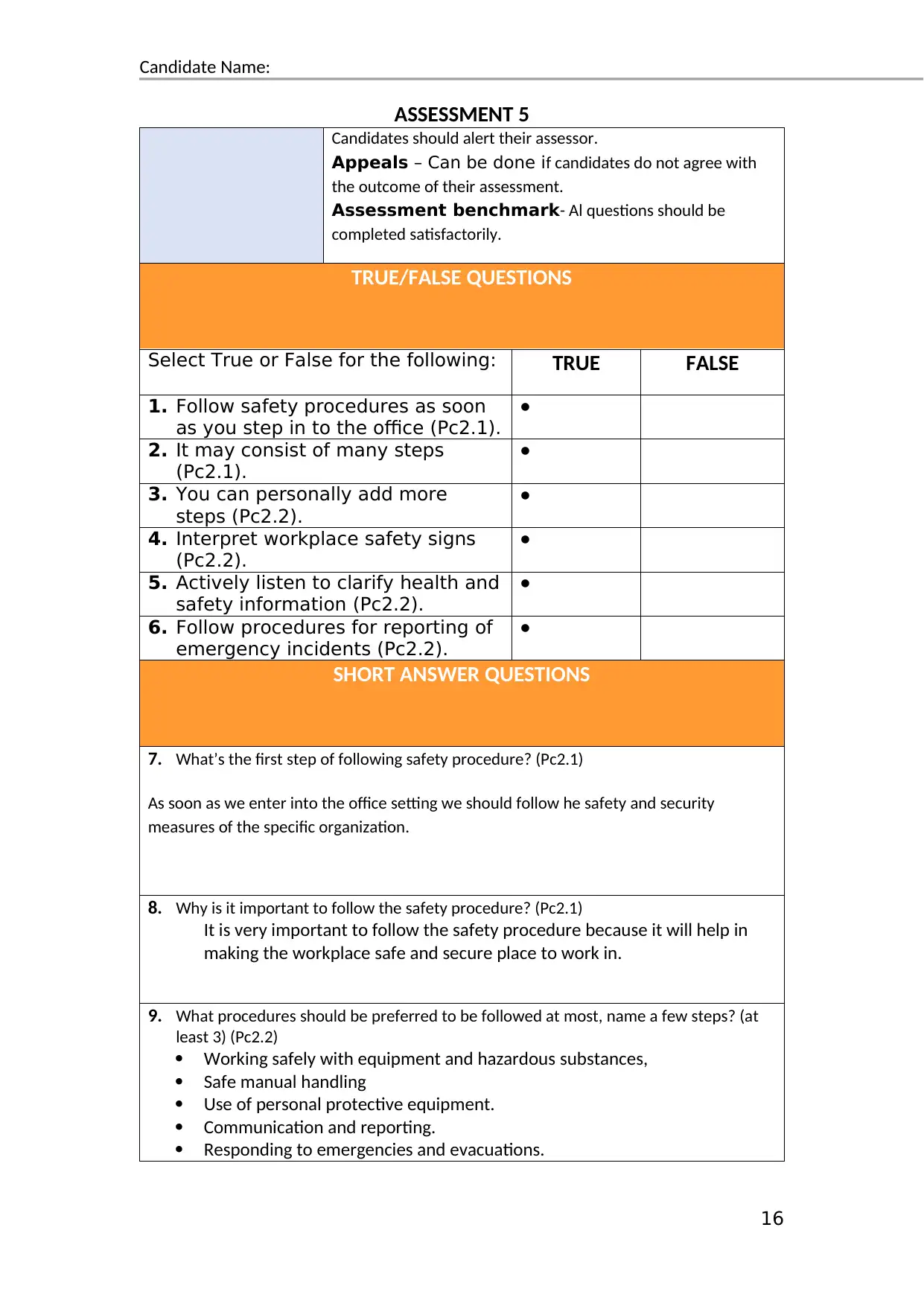
Candidate Name:
ASSESSMENT 5
Candidates should alert their assessor.
Appeals – Can be done if candidates do not agree with
the outcome of their assessment.
Assessment benchmark- Al questions should be
completed satisfactorily.
TRUE/FALSE QUESTIONS
Select True or False for the following: TRUE FALSE
1. Follow safety procedures as soon
as you step in to the office (Pc2.1).
●
2. It may consist of many steps
(Pc2.1).
●
3. You can personally add more
steps (Pc2.2).
●
4. Interpret workplace safety signs
(Pc2.2).
●
5. Actively listen to clarify health and
safety information (Pc2.2).
●
6. Follow procedures for reporting of
emergency incidents (Pc2.2).
●
SHORT ANSWER QUESTIONS
7. What’s the first step of following safety procedure? (Pc2.1)
As soon as we enter into the office setting we should follow he safety and security
measures of the specific organization.
8. Why is it important to follow the safety procedure? (Pc2.1)
It is very important to follow the safety procedure because it will help in
making the workplace safe and secure place to work in.
9. What procedures should be preferred to be followed at most, name a few steps? (at
least 3) (Pc2.2)
Working safely with equipment and hazardous substances,
Safe manual handling
Use of personal protective equipment.
Communication and reporting.
Responding to emergencies and evacuations.
16
ASSESSMENT 5
Candidates should alert their assessor.
Appeals – Can be done if candidates do not agree with
the outcome of their assessment.
Assessment benchmark- Al questions should be
completed satisfactorily.
TRUE/FALSE QUESTIONS
Select True or False for the following: TRUE FALSE
1. Follow safety procedures as soon
as you step in to the office (Pc2.1).
●
2. It may consist of many steps
(Pc2.1).
●
3. You can personally add more
steps (Pc2.2).
●
4. Interpret workplace safety signs
(Pc2.2).
●
5. Actively listen to clarify health and
safety information (Pc2.2).
●
6. Follow procedures for reporting of
emergency incidents (Pc2.2).
●
SHORT ANSWER QUESTIONS
7. What’s the first step of following safety procedure? (Pc2.1)
As soon as we enter into the office setting we should follow he safety and security
measures of the specific organization.
8. Why is it important to follow the safety procedure? (Pc2.1)
It is very important to follow the safety procedure because it will help in
making the workplace safe and secure place to work in.
9. What procedures should be preferred to be followed at most, name a few steps? (at
least 3) (Pc2.2)
Working safely with equipment and hazardous substances,
Safe manual handling
Use of personal protective equipment.
Communication and reporting.
Responding to emergencies and evacuations.
16
Secure Best Marks with AI Grader
Need help grading? Try our AI Grader for instant feedback on your assignments.
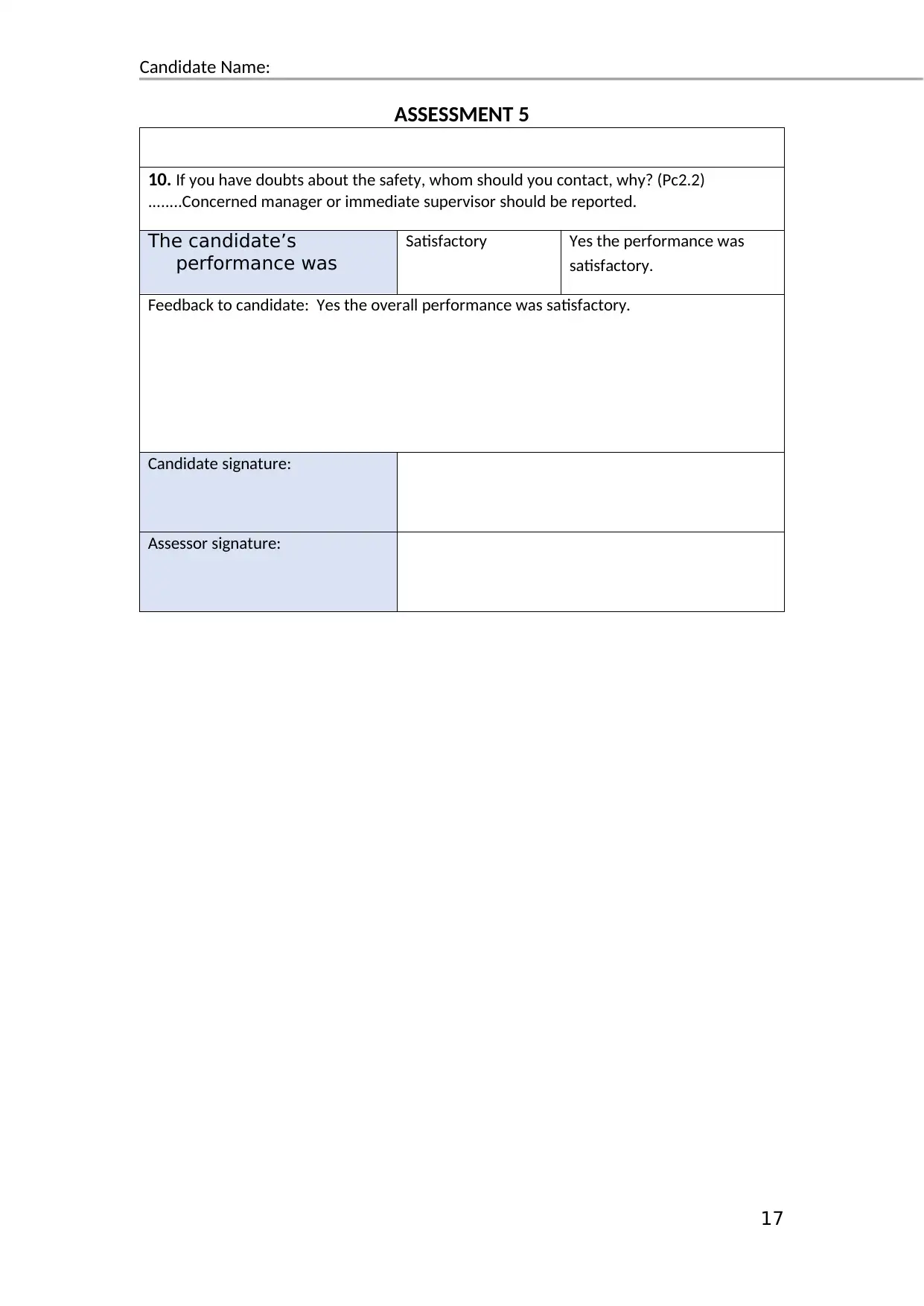
Candidate Name:
ASSESSMENT 5
10. If you have doubts about the safety, whom should you contact, why? (Pc2.2)
........Concerned manager or immediate supervisor should be reported.
The candidate’s
performance was
Satisfactory Yes the performance was
satisfactory.
Feedback to candidate: Yes the overall performance was satisfactory.
Candidate signature:
Assessor signature:
17
ASSESSMENT 5
10. If you have doubts about the safety, whom should you contact, why? (Pc2.2)
........Concerned manager or immediate supervisor should be reported.
The candidate’s
performance was
Satisfactory Yes the performance was
satisfactory.
Feedback to candidate: Yes the overall performance was satisfactory.
Candidate signature:
Assessor signature:
17
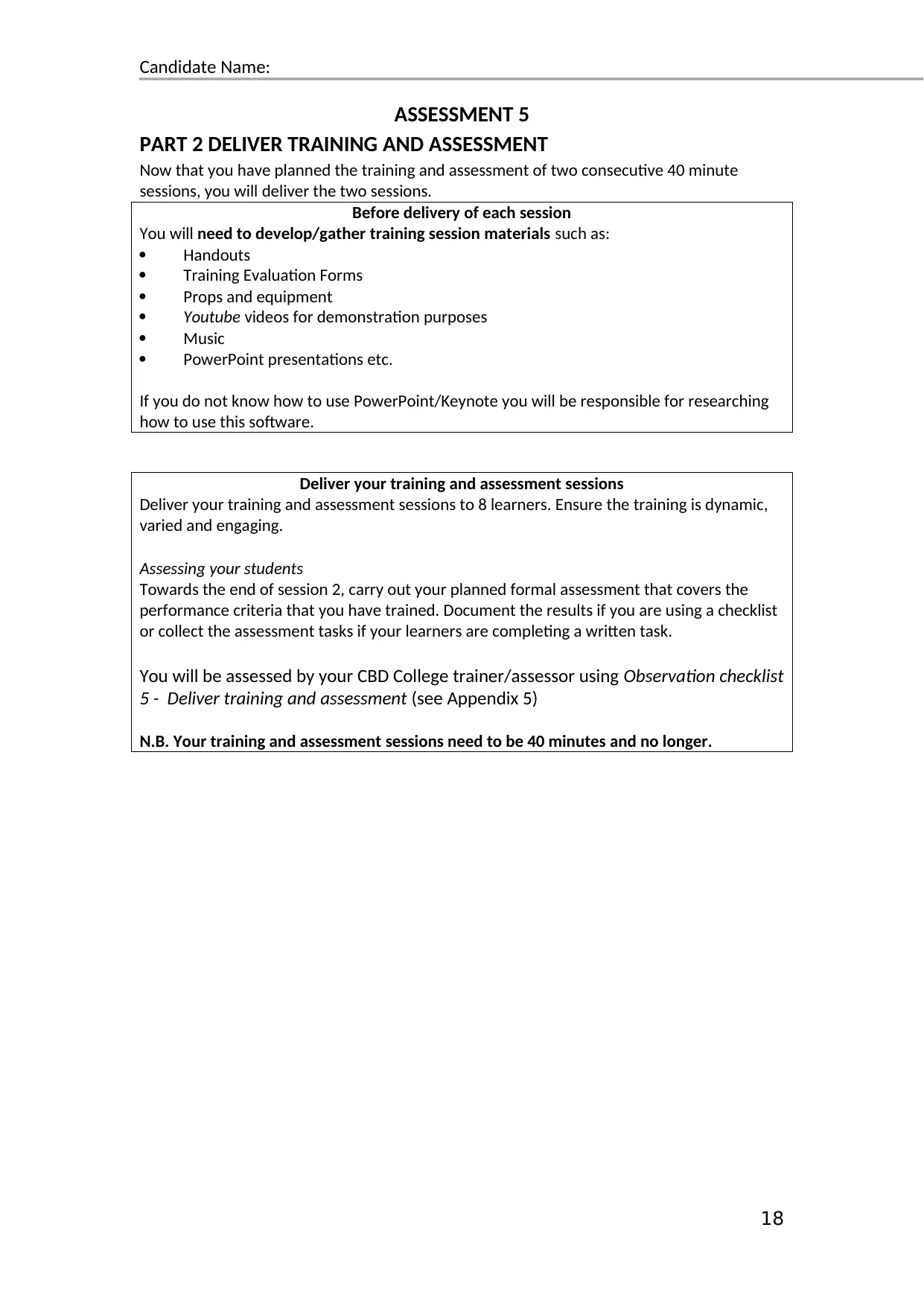
Candidate Name:
ASSESSMENT 5
PART 2 DELIVER TRAINING AND ASSESSMENT
Now that you have planned the training and assessment of two consecutive 40 minute
sessions, you will deliver the two sessions.
Before delivery of each session
You will need to develop/gather training session materials such as:
Handouts
Training Evaluation Forms
Props and equipment
Youtube videos for demonstration purposes
Music
PowerPoint presentations etc.
If you do not know how to use PowerPoint/Keynote you will be responsible for researching
how to use this software.
Deliver your training and assessment sessions
Deliver your training and assessment sessions to 8 learners. Ensure the training is dynamic,
varied and engaging.
Assessing your students
Towards the end of session 2, carry out your planned formal assessment that covers the
performance criteria that you have trained. Document the results if you are using a checklist
or collect the assessment tasks if your learners are completing a written task.
You will be assessed by your CBD College trainer/assessor using Observation checklist
5 - Deliver training and assessment (see Appendix 5)
N.B. Your training and assessment sessions need to be 40 minutes and no longer.
18
ASSESSMENT 5
PART 2 DELIVER TRAINING AND ASSESSMENT
Now that you have planned the training and assessment of two consecutive 40 minute
sessions, you will deliver the two sessions.
Before delivery of each session
You will need to develop/gather training session materials such as:
Handouts
Training Evaluation Forms
Props and equipment
Youtube videos for demonstration purposes
Music
PowerPoint presentations etc.
If you do not know how to use PowerPoint/Keynote you will be responsible for researching
how to use this software.
Deliver your training and assessment sessions
Deliver your training and assessment sessions to 8 learners. Ensure the training is dynamic,
varied and engaging.
Assessing your students
Towards the end of session 2, carry out your planned formal assessment that covers the
performance criteria that you have trained. Document the results if you are using a checklist
or collect the assessment tasks if your learners are completing a written task.
You will be assessed by your CBD College trainer/assessor using Observation checklist
5 - Deliver training and assessment (see Appendix 5)
N.B. Your training and assessment sessions need to be 40 minutes and no longer.
18
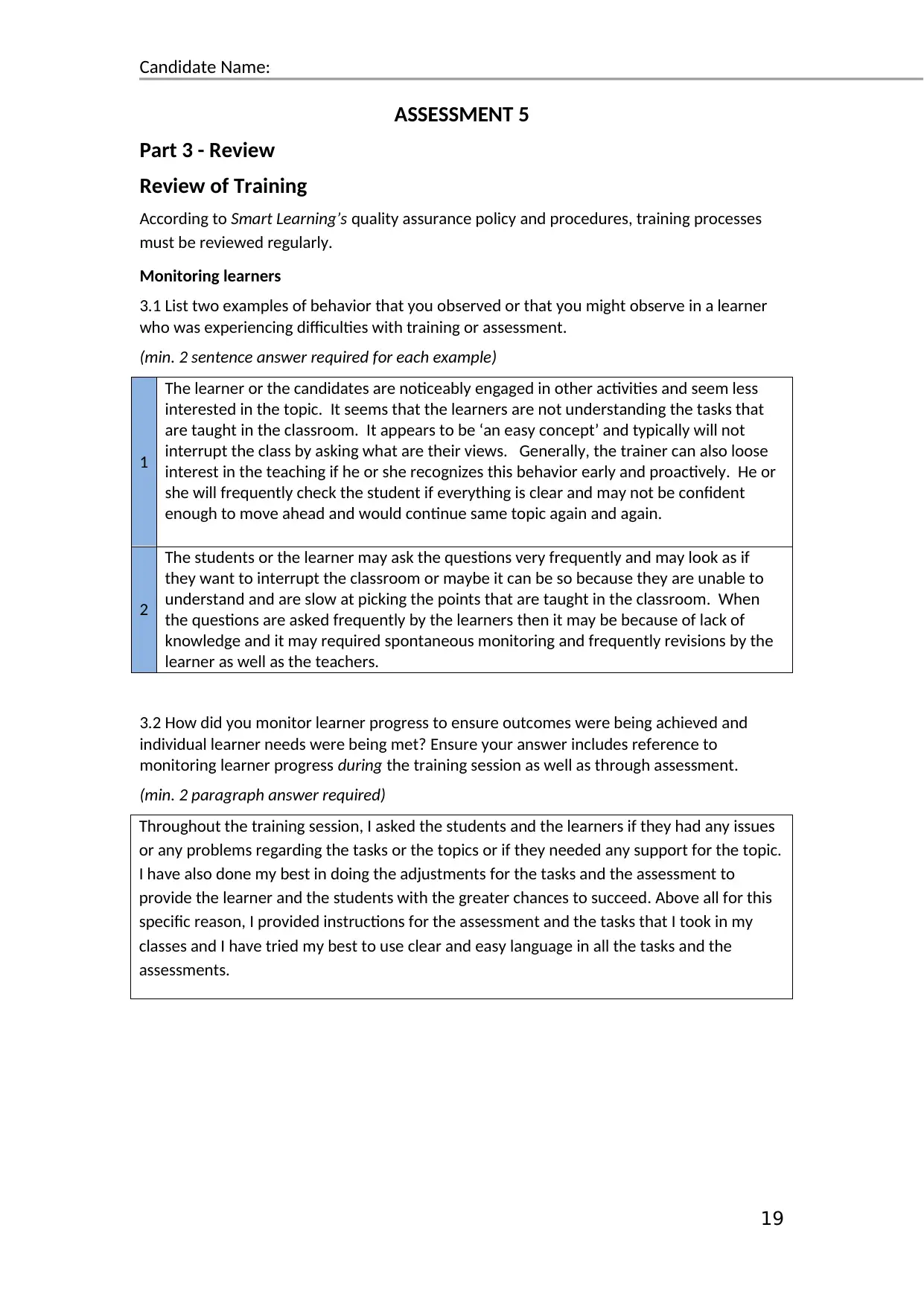
Candidate Name:
ASSESSMENT 5
Part 3 - Review
Review of Training
According to Smart Learning’s quality assurance policy and procedures, training processes
must be reviewed regularly.
Monitoring learners
3.1 List two examples of behavior that you observed or that you might observe in a learner
who was experiencing difficulties with training or assessment.
(min. 2 sentence answer required for each example)
1
The learner or the candidates are noticeably engaged in other activities and seem less
interested in the topic. It seems that the learners are not understanding the tasks that
are taught in the classroom. It appears to be ‘an easy concept’ and typically will not
interrupt the class by asking what are their views. Generally, the trainer can also loose
interest in the teaching if he or she recognizes this behavior early and proactively. He or
she will frequently check the student if everything is clear and may not be confident
enough to move ahead and would continue same topic again and again.
2
The students or the learner may ask the questions very frequently and may look as if
they want to interrupt the classroom or maybe it can be so because they are unable to
understand and are slow at picking the points that are taught in the classroom. When
the questions are asked frequently by the learners then it may be because of lack of
knowledge and it may required spontaneous monitoring and frequently revisions by the
learner as well as the teachers.
3.2 How did you monitor learner progress to ensure outcomes were being achieved and
individual learner needs were being met? Ensure your answer includes reference to
monitoring learner progress during the training session as well as through assessment.
(min. 2 paragraph answer required)
Throughout the training session, I asked the students and the learners if they had any issues
or any problems regarding the tasks or the topics or if they needed any support for the topic.
I have also done my best in doing the adjustments for the tasks and the assessment to
provide the learner and the students with the greater chances to succeed. Above all for this
specific reason, I provided instructions for the assessment and the tasks that I took in my
classes and I have tried my best to use clear and easy language in all the tasks and the
assessments.
19
ASSESSMENT 5
Part 3 - Review
Review of Training
According to Smart Learning’s quality assurance policy and procedures, training processes
must be reviewed regularly.
Monitoring learners
3.1 List two examples of behavior that you observed or that you might observe in a learner
who was experiencing difficulties with training or assessment.
(min. 2 sentence answer required for each example)
1
The learner or the candidates are noticeably engaged in other activities and seem less
interested in the topic. It seems that the learners are not understanding the tasks that
are taught in the classroom. It appears to be ‘an easy concept’ and typically will not
interrupt the class by asking what are their views. Generally, the trainer can also loose
interest in the teaching if he or she recognizes this behavior early and proactively. He or
she will frequently check the student if everything is clear and may not be confident
enough to move ahead and would continue same topic again and again.
2
The students or the learner may ask the questions very frequently and may look as if
they want to interrupt the classroom or maybe it can be so because they are unable to
understand and are slow at picking the points that are taught in the classroom. When
the questions are asked frequently by the learners then it may be because of lack of
knowledge and it may required spontaneous monitoring and frequently revisions by the
learner as well as the teachers.
3.2 How did you monitor learner progress to ensure outcomes were being achieved and
individual learner needs were being met? Ensure your answer includes reference to
monitoring learner progress during the training session as well as through assessment.
(min. 2 paragraph answer required)
Throughout the training session, I asked the students and the learners if they had any issues
or any problems regarding the tasks or the topics or if they needed any support for the topic.
I have also done my best in doing the adjustments for the tasks and the assessment to
provide the learner and the students with the greater chances to succeed. Above all for this
specific reason, I provided instructions for the assessment and the tasks that I took in my
classes and I have tried my best to use clear and easy language in all the tasks and the
assessments.
19
Paraphrase This Document
Need a fresh take? Get an instant paraphrase of this document with our AI Paraphraser
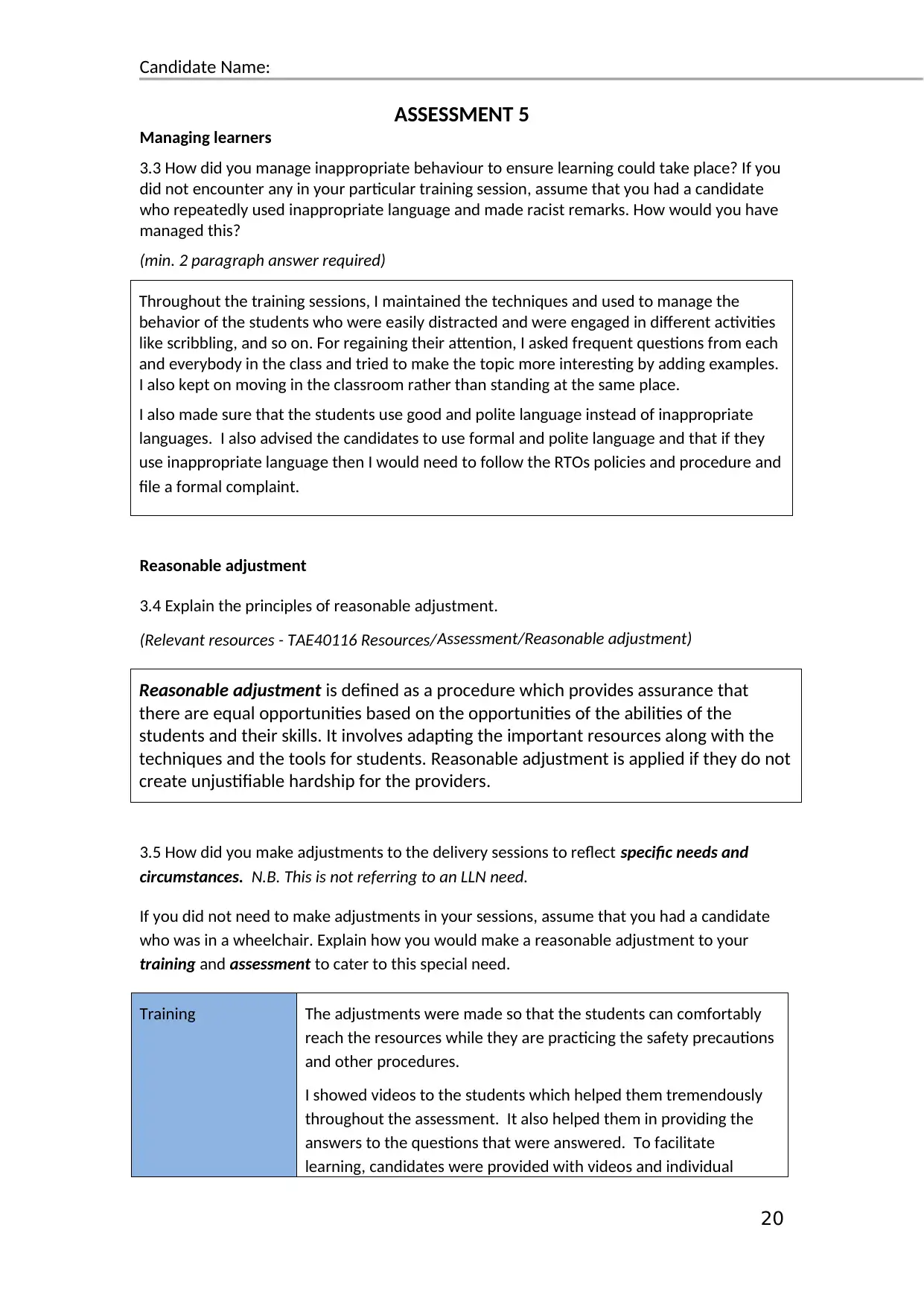
Candidate Name:
ASSESSMENT 5
Managing learners
3.3 How did you manage inappropriate behaviour to ensure learning could take place? If you
did not encounter any in your particular training session, assume that you had a candidate
who repeatedly used inappropriate language and made racist remarks. How would you have
managed this?
(min. 2 paragraph answer required)
Throughout the training sessions, I maintained the techniques and used to manage the
behavior of the students who were easily distracted and were engaged in different activities
like scribbling, and so on. For regaining their attention, I asked frequent questions from each
and everybody in the class and tried to make the topic more interesting by adding examples.
I also kept on moving in the classroom rather than standing at the same place.
I also made sure that the students use good and polite language instead of inappropriate
languages. I also advised the candidates to use formal and polite language and that if they
use inappropriate language then I would need to follow the RTOs policies and procedure and
file a formal complaint.
Reasonable adjustment
3.4 Explain the principles of reasonable adjustment.
(Relevant resources - TAE40116 Resources/Assessment/Reasonable adjustment)
Reasonable adjustment is defined as a procedure which provides assurance that
there are equal opportunities based on the opportunities of the abilities of the
students and their skills. It involves adapting the important resources along with the
techniques and the tools for students. Reasonable adjustment is applied if they do not
create unjustifiable hardship for the providers.
3.5 How did you make adjustments to the delivery sessions to reflect specific needs and
circumstances. N.B. This is not referring to an LLN need.
If you did not need to make adjustments in your sessions, assume that you had a candidate
who was in a wheelchair. Explain how you would make a reasonable adjustment to your
training and assessment to cater to this special need.
Training The adjustments were made so that the students can comfortably
reach the resources while they are practicing the safety precautions
and other procedures.
I showed videos to the students which helped them tremendously
throughout the assessment. It also helped them in providing the
answers to the questions that were answered. To facilitate
learning, candidates were provided with videos and individual
20
ASSESSMENT 5
Managing learners
3.3 How did you manage inappropriate behaviour to ensure learning could take place? If you
did not encounter any in your particular training session, assume that you had a candidate
who repeatedly used inappropriate language and made racist remarks. How would you have
managed this?
(min. 2 paragraph answer required)
Throughout the training sessions, I maintained the techniques and used to manage the
behavior of the students who were easily distracted and were engaged in different activities
like scribbling, and so on. For regaining their attention, I asked frequent questions from each
and everybody in the class and tried to make the topic more interesting by adding examples.
I also kept on moving in the classroom rather than standing at the same place.
I also made sure that the students use good and polite language instead of inappropriate
languages. I also advised the candidates to use formal and polite language and that if they
use inappropriate language then I would need to follow the RTOs policies and procedure and
file a formal complaint.
Reasonable adjustment
3.4 Explain the principles of reasonable adjustment.
(Relevant resources - TAE40116 Resources/Assessment/Reasonable adjustment)
Reasonable adjustment is defined as a procedure which provides assurance that
there are equal opportunities based on the opportunities of the abilities of the
students and their skills. It involves adapting the important resources along with the
techniques and the tools for students. Reasonable adjustment is applied if they do not
create unjustifiable hardship for the providers.
3.5 How did you make adjustments to the delivery sessions to reflect specific needs and
circumstances. N.B. This is not referring to an LLN need.
If you did not need to make adjustments in your sessions, assume that you had a candidate
who was in a wheelchair. Explain how you would make a reasonable adjustment to your
training and assessment to cater to this special need.
Training The adjustments were made so that the students can comfortably
reach the resources while they are practicing the safety precautions
and other procedures.
I showed videos to the students which helped them tremendously
throughout the assessment. It also helped them in providing the
answers to the questions that were answered. To facilitate
learning, candidates were provided with videos and individual
20
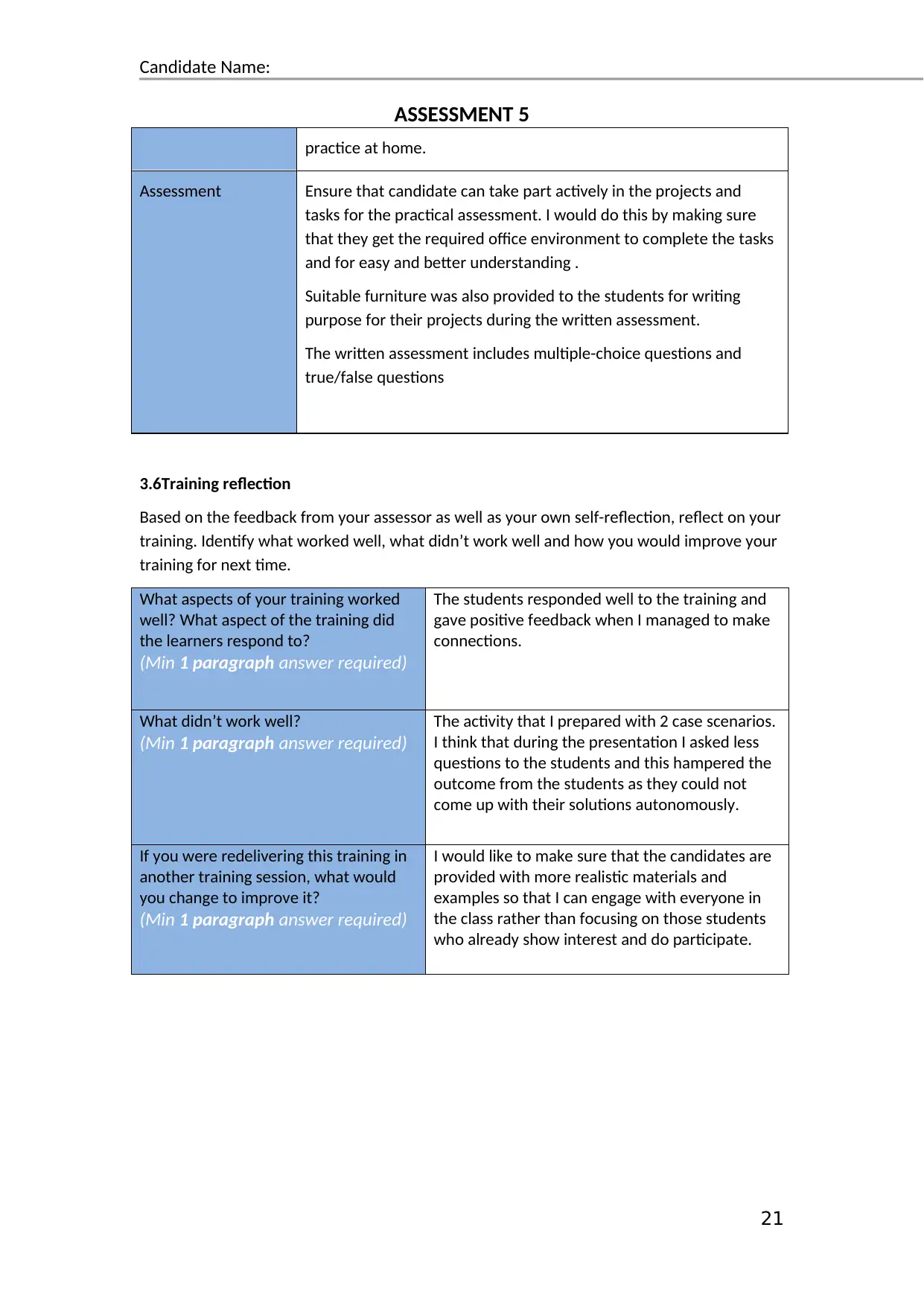
Candidate Name:
ASSESSMENT 5
practice at home.
Assessment Ensure that candidate can take part actively in the projects and
tasks for the practical assessment. I would do this by making sure
that they get the required office environment to complete the tasks
and for easy and better understanding .
Suitable furniture was also provided to the students for writing
purpose for their projects during the written assessment.
The written assessment includes multiple-choice questions and
true/false questions
3.6Training reflection
Based on the feedback from your assessor as well as your own self-reflection, reflect on your
training. Identify what worked well, what didn’t work well and how you would improve your
training for next time.
What aspects of your training worked
well? What aspect of the training did
the learners respond to?
(Min 1 paragraph answer required)
The students responded well to the training and
gave positive feedback when I managed to make
connections.
What didn’t work well?
(Min 1 paragraph answer required)
The activity that I prepared with 2 case scenarios.
I think that during the presentation I asked less
questions to the students and this hampered the
outcome from the students as they could not
come up with their solutions autonomously.
If you were redelivering this training in
another training session, what would
you change to improve it?
(Min 1 paragraph answer required)
I would like to make sure that the candidates are
provided with more realistic materials and
examples so that I can engage with everyone in
the class rather than focusing on those students
who already show interest and do participate.
21
ASSESSMENT 5
practice at home.
Assessment Ensure that candidate can take part actively in the projects and
tasks for the practical assessment. I would do this by making sure
that they get the required office environment to complete the tasks
and for easy and better understanding .
Suitable furniture was also provided to the students for writing
purpose for their projects during the written assessment.
The written assessment includes multiple-choice questions and
true/false questions
3.6Training reflection
Based on the feedback from your assessor as well as your own self-reflection, reflect on your
training. Identify what worked well, what didn’t work well and how you would improve your
training for next time.
What aspects of your training worked
well? What aspect of the training did
the learners respond to?
(Min 1 paragraph answer required)
The students responded well to the training and
gave positive feedback when I managed to make
connections.
What didn’t work well?
(Min 1 paragraph answer required)
The activity that I prepared with 2 case scenarios.
I think that during the presentation I asked less
questions to the students and this hampered the
outcome from the students as they could not
come up with their solutions autonomously.
If you were redelivering this training in
another training session, what would
you change to improve it?
(Min 1 paragraph answer required)
I would like to make sure that the candidates are
provided with more realistic materials and
examples so that I can engage with everyone in
the class rather than focusing on those students
who already show interest and do participate.
21
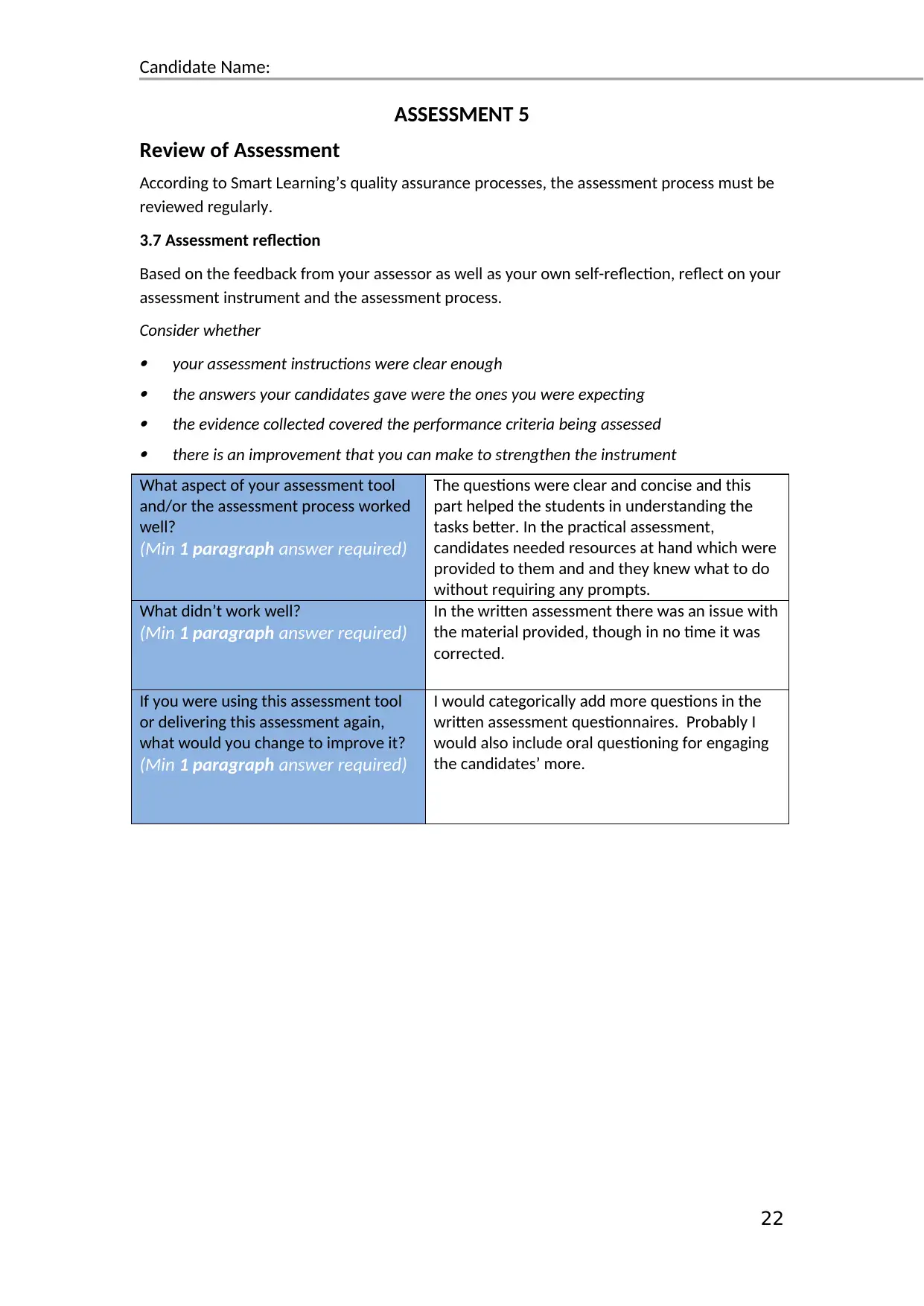
Candidate Name:
ASSESSMENT 5
Review of Assessment
According to Smart Learning’s quality assurance processes, the assessment process must be
reviewed regularly.
3.7 Assessment reflection
Based on the feedback from your assessor as well as your own self-reflection, reflect on your
assessment instrument and the assessment process.
Consider whether your assessment instructions were clear enough the answers your candidates gave were the ones you were expecting the evidence collected covered the performance criteria being assessed there is an improvement that you can make to strengthen the instrument
What aspect of your assessment tool
and/or the assessment process worked
well?
(Min 1 paragraph answer required)
The questions were clear and concise and this
part helped the students in understanding the
tasks better. In the practical assessment,
candidates needed resources at hand which were
provided to them and and they knew what to do
without requiring any prompts.
What didn’t work well?
(Min 1 paragraph answer required)
In the written assessment there was an issue with
the material provided, though in no time it was
corrected.
If you were using this assessment tool
or delivering this assessment again,
what would you change to improve it?
(Min 1 paragraph answer required)
I would categorically add more questions in the
written assessment questionnaires. Probably I
would also include oral questioning for engaging
the candidates’ more.
22
ASSESSMENT 5
Review of Assessment
According to Smart Learning’s quality assurance processes, the assessment process must be
reviewed regularly.
3.7 Assessment reflection
Based on the feedback from your assessor as well as your own self-reflection, reflect on your
assessment instrument and the assessment process.
Consider whether your assessment instructions were clear enough the answers your candidates gave were the ones you were expecting the evidence collected covered the performance criteria being assessed there is an improvement that you can make to strengthen the instrument
What aspect of your assessment tool
and/or the assessment process worked
well?
(Min 1 paragraph answer required)
The questions were clear and concise and this
part helped the students in understanding the
tasks better. In the practical assessment,
candidates needed resources at hand which were
provided to them and and they knew what to do
without requiring any prompts.
What didn’t work well?
(Min 1 paragraph answer required)
In the written assessment there was an issue with
the material provided, though in no time it was
corrected.
If you were using this assessment tool
or delivering this assessment again,
what would you change to improve it?
(Min 1 paragraph answer required)
I would categorically add more questions in the
written assessment questionnaires. Probably I
would also include oral questioning for engaging
the candidates’ more.
22
Secure Best Marks with AI Grader
Need help grading? Try our AI Grader for instant feedback on your assignments.
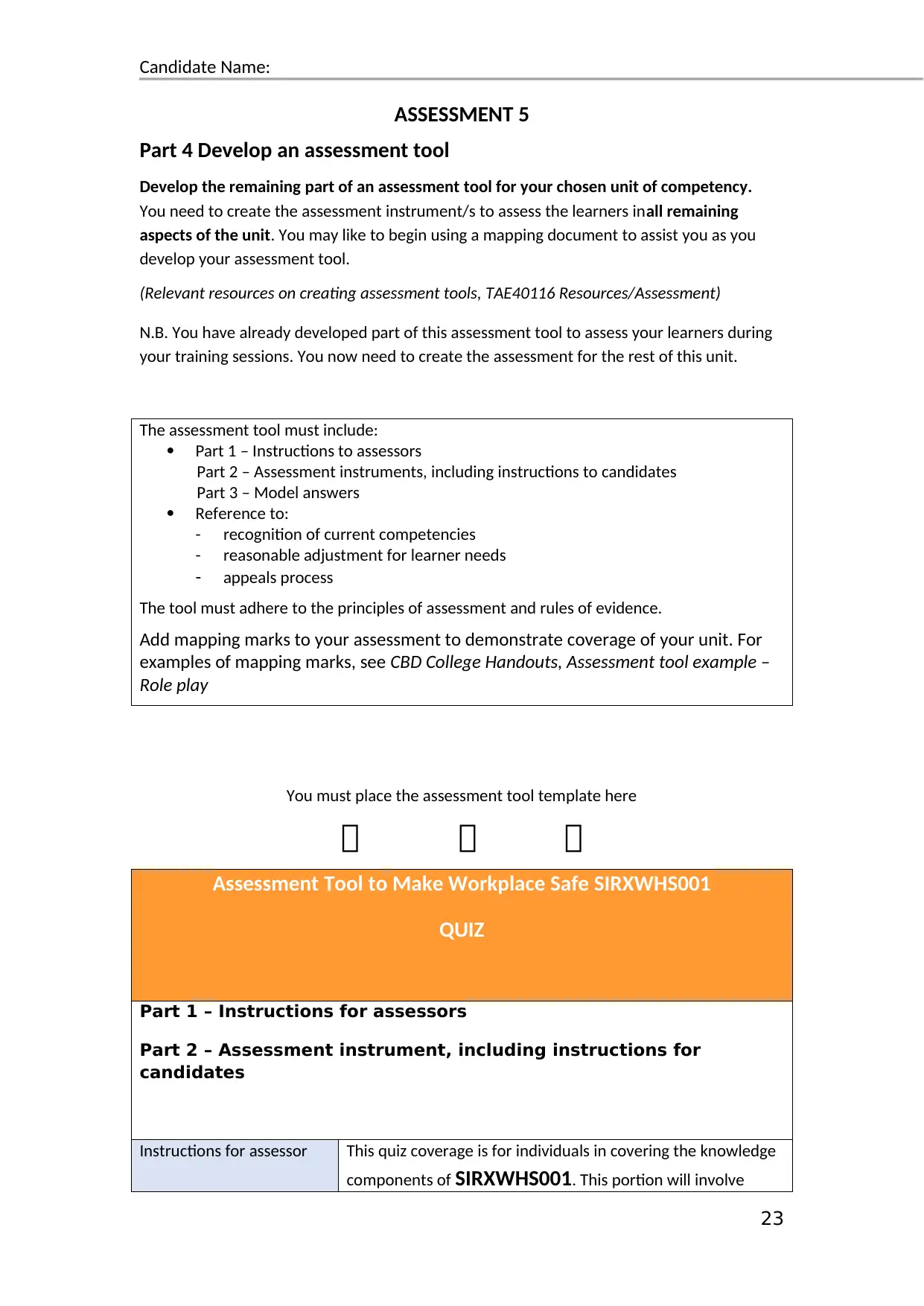
Candidate Name:
ASSESSMENT 5
Part 4 Develop an assessment tool
Develop the remaining part of an assessment tool for your chosen unit of competency.
You need to create the assessment instrument/s to assess the learners inall remaining
aspects of the unit. You may like to begin using a mapping document to assist you as you
develop your assessment tool.
(Relevant resources on creating assessment tools, TAE40116 Resources/Assessment)
N.B. You have already developed part of this assessment tool to assess your learners during
your training sessions. You now need to create the assessment for the rest of this unit.
The assessment tool must include:
Part 1 – Instructions to assessors
Part 2 – Assessment instruments, including instructions to candidates
Part 3 – Model answers
Reference to:
- recognition of current competencies
- reasonable adjustment for learner needs
- appeals process
The tool must adhere to the principles of assessment and rules of evidence.
Add mapping marks to your assessment to demonstrate coverage of your unit. For
examples of mapping marks, see CBD College Handouts, Assessment tool example –
Role play
You must place the assessment tool template here
Assessment Tool to Make Workplace Safe SIRXWHS001
QUIZ
Part 1 – Instructions for assessors
Part 2 – Assessment instrument, including instructions for
candidates
Instructions for assessor This quiz coverage is for individuals in covering the knowledge
components of SIRXWHS001. This portion will involve
23
ASSESSMENT 5
Part 4 Develop an assessment tool
Develop the remaining part of an assessment tool for your chosen unit of competency.
You need to create the assessment instrument/s to assess the learners inall remaining
aspects of the unit. You may like to begin using a mapping document to assist you as you
develop your assessment tool.
(Relevant resources on creating assessment tools, TAE40116 Resources/Assessment)
N.B. You have already developed part of this assessment tool to assess your learners during
your training sessions. You now need to create the assessment for the rest of this unit.
The assessment tool must include:
Part 1 – Instructions to assessors
Part 2 – Assessment instruments, including instructions to candidates
Part 3 – Model answers
Reference to:
- recognition of current competencies
- reasonable adjustment for learner needs
- appeals process
The tool must adhere to the principles of assessment and rules of evidence.
Add mapping marks to your assessment to demonstrate coverage of your unit. For
examples of mapping marks, see CBD College Handouts, Assessment tool example –
Role play
You must place the assessment tool template here
Assessment Tool to Make Workplace Safe SIRXWHS001
QUIZ
Part 1 – Instructions for assessors
Part 2 – Assessment instrument, including instructions for
candidates
Instructions for assessor This quiz coverage is for individuals in covering the knowledge
components of SIRXWHS001. This portion will involve
23
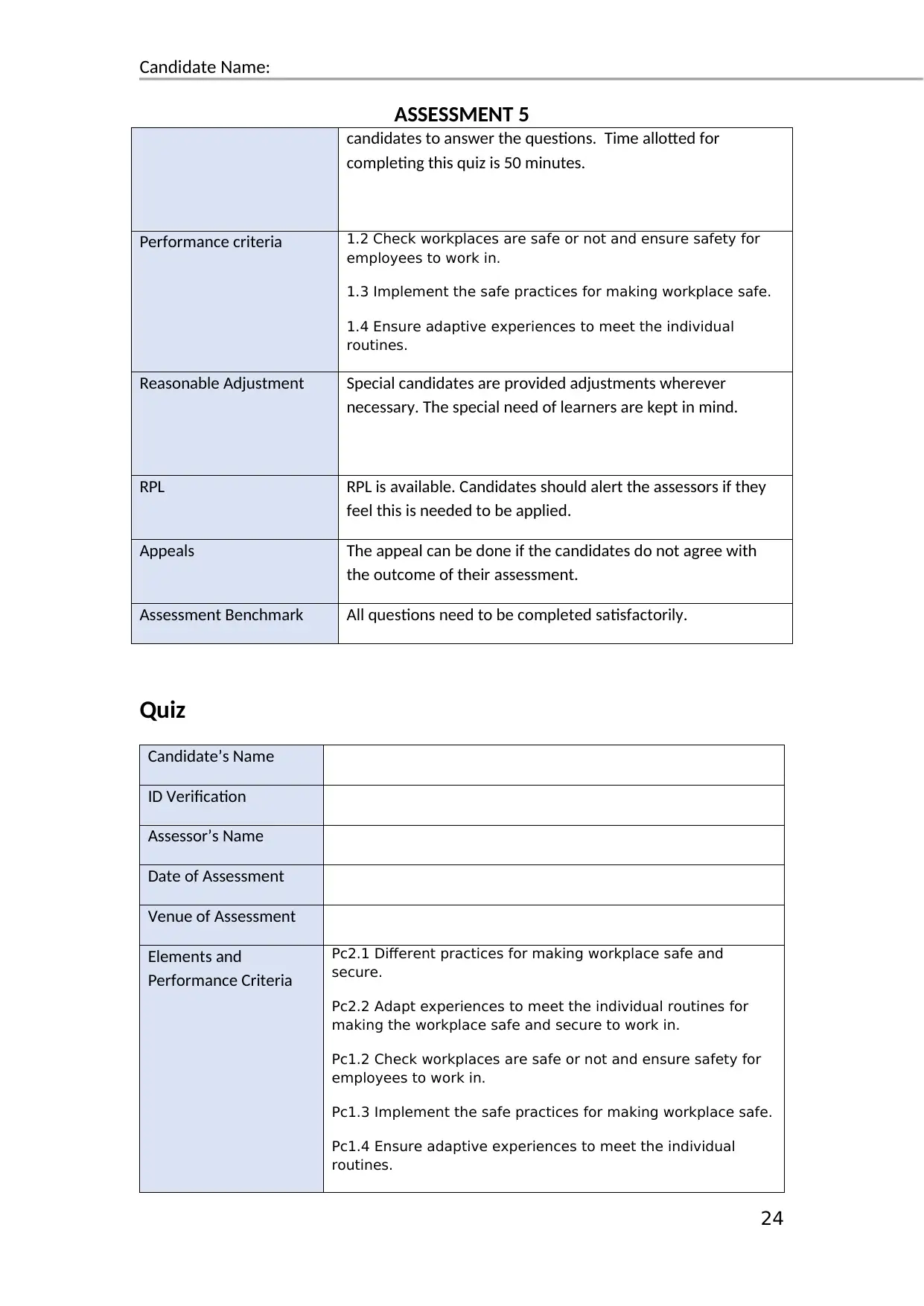
Candidate Name:
ASSESSMENT 5
candidates to answer the questions. Time allotted for
completing this quiz is 50 minutes.
Performance criteria 1.2 Check workplaces are safe or not and ensure safety for
employees to work in.
1.3 Implement the safe practices for making workplace safe.
1.4 Ensure adaptive experiences to meet the individual
routines.
Reasonable Adjustment Special candidates are provided adjustments wherever
necessary. The special need of learners are kept in mind.
RPL RPL is available. Candidates should alert the assessors if they
feel this is needed to be applied.
Appeals The appeal can be done if the candidates do not agree with
the outcome of their assessment.
Assessment Benchmark All questions need to be completed satisfactorily.
Quiz
Candidate’s Name
ID Verification
Assessor’s Name
Date of Assessment
Venue of Assessment
Elements and
Performance Criteria
Pc2.1 Different practices for making workplace safe and
secure.
Pc2.2 Adapt experiences to meet the individual routines for
making the workplace safe and secure to work in.
Pc1.2 Check workplaces are safe or not and ensure safety for
employees to work in.
Pc1.3 Implement the safe practices for making workplace safe.
Pc1.4 Ensure adaptive experiences to meet the individual
routines.
24
ASSESSMENT 5
candidates to answer the questions. Time allotted for
completing this quiz is 50 minutes.
Performance criteria 1.2 Check workplaces are safe or not and ensure safety for
employees to work in.
1.3 Implement the safe practices for making workplace safe.
1.4 Ensure adaptive experiences to meet the individual
routines.
Reasonable Adjustment Special candidates are provided adjustments wherever
necessary. The special need of learners are kept in mind.
RPL RPL is available. Candidates should alert the assessors if they
feel this is needed to be applied.
Appeals The appeal can be done if the candidates do not agree with
the outcome of their assessment.
Assessment Benchmark All questions need to be completed satisfactorily.
Quiz
Candidate’s Name
ID Verification
Assessor’s Name
Date of Assessment
Venue of Assessment
Elements and
Performance Criteria
Pc2.1 Different practices for making workplace safe and
secure.
Pc2.2 Adapt experiences to meet the individual routines for
making the workplace safe and secure to work in.
Pc1.2 Check workplaces are safe or not and ensure safety for
employees to work in.
Pc1.3 Implement the safe practices for making workplace safe.
Pc1.4 Ensure adaptive experiences to meet the individual
routines.
24
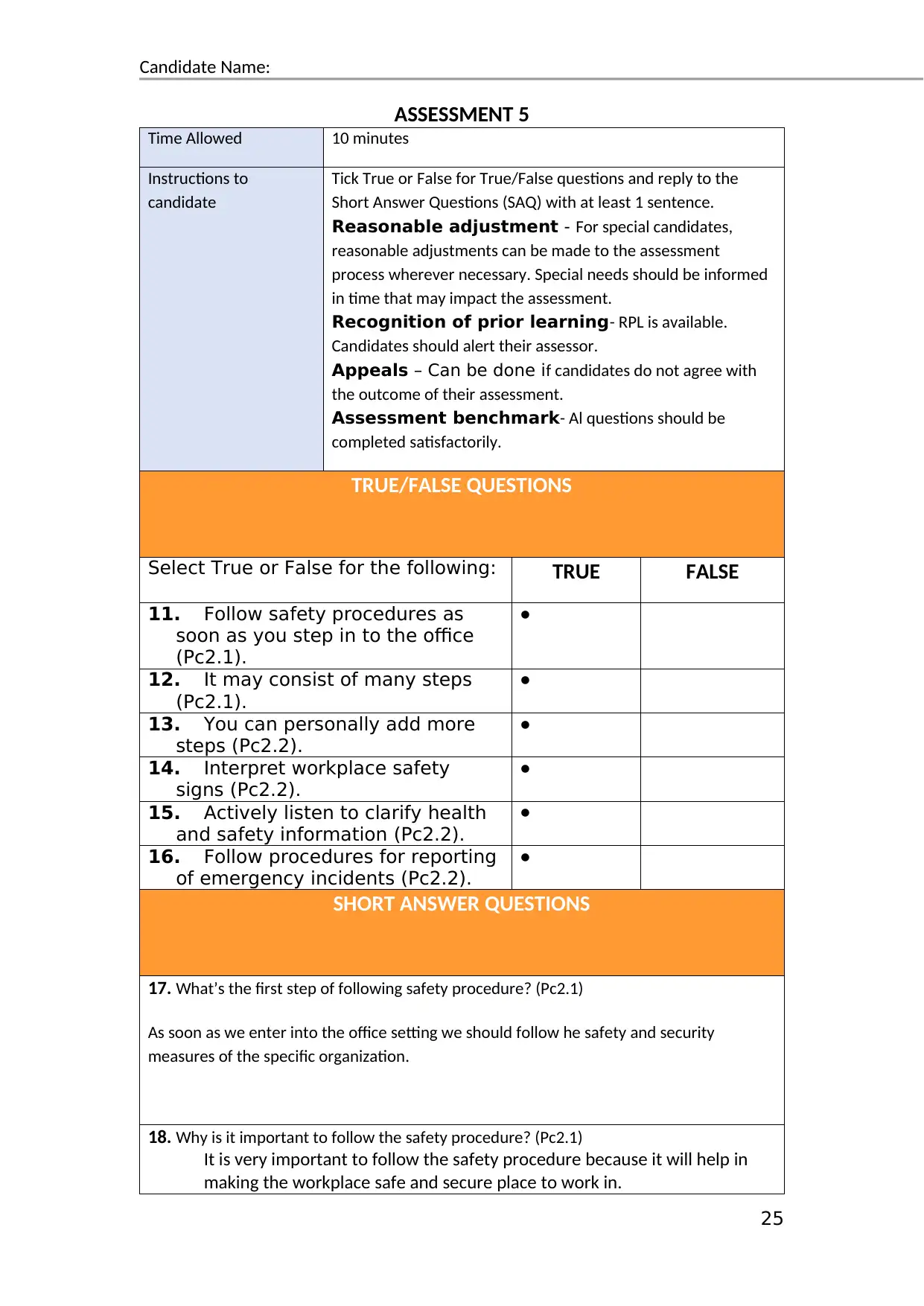
Candidate Name:
ASSESSMENT 5
Time Allowed 10 minutes
Instructions to
candidate
Tick True or False for True/False questions and reply to the
Short Answer Questions (SAQ) with at least 1 sentence.
Reasonable adjustment - For special candidates,
reasonable adjustments can be made to the assessment
process wherever necessary. Special needs should be informed
in time that may impact the assessment.
Recognition of prior learning- RPL is available.
Candidates should alert their assessor.
Appeals – Can be done if candidates do not agree with
the outcome of their assessment.
Assessment benchmark- Al questions should be
completed satisfactorily.
TRUE/FALSE QUESTIONS
Select True or False for the following: TRUE FALSE
11. Follow safety procedures as
soon as you step in to the office
(Pc2.1).
●
12. It may consist of many steps
(Pc2.1).
●
13. You can personally add more
steps (Pc2.2).
●
14. Interpret workplace safety
signs (Pc2.2).
●
15. Actively listen to clarify health
and safety information (Pc2.2).
●
16. Follow procedures for reporting
of emergency incidents (Pc2.2).
●
SHORT ANSWER QUESTIONS
17. What’s the first step of following safety procedure? (Pc2.1)
As soon as we enter into the office setting we should follow he safety and security
measures of the specific organization.
18. Why is it important to follow the safety procedure? (Pc2.1)
It is very important to follow the safety procedure because it will help in
making the workplace safe and secure place to work in.
25
ASSESSMENT 5
Time Allowed 10 minutes
Instructions to
candidate
Tick True or False for True/False questions and reply to the
Short Answer Questions (SAQ) with at least 1 sentence.
Reasonable adjustment - For special candidates,
reasonable adjustments can be made to the assessment
process wherever necessary. Special needs should be informed
in time that may impact the assessment.
Recognition of prior learning- RPL is available.
Candidates should alert their assessor.
Appeals – Can be done if candidates do not agree with
the outcome of their assessment.
Assessment benchmark- Al questions should be
completed satisfactorily.
TRUE/FALSE QUESTIONS
Select True or False for the following: TRUE FALSE
11. Follow safety procedures as
soon as you step in to the office
(Pc2.1).
●
12. It may consist of many steps
(Pc2.1).
●
13. You can personally add more
steps (Pc2.2).
●
14. Interpret workplace safety
signs (Pc2.2).
●
15. Actively listen to clarify health
and safety information (Pc2.2).
●
16. Follow procedures for reporting
of emergency incidents (Pc2.2).
●
SHORT ANSWER QUESTIONS
17. What’s the first step of following safety procedure? (Pc2.1)
As soon as we enter into the office setting we should follow he safety and security
measures of the specific organization.
18. Why is it important to follow the safety procedure? (Pc2.1)
It is very important to follow the safety procedure because it will help in
making the workplace safe and secure place to work in.
25
Paraphrase This Document
Need a fresh take? Get an instant paraphrase of this document with our AI Paraphraser
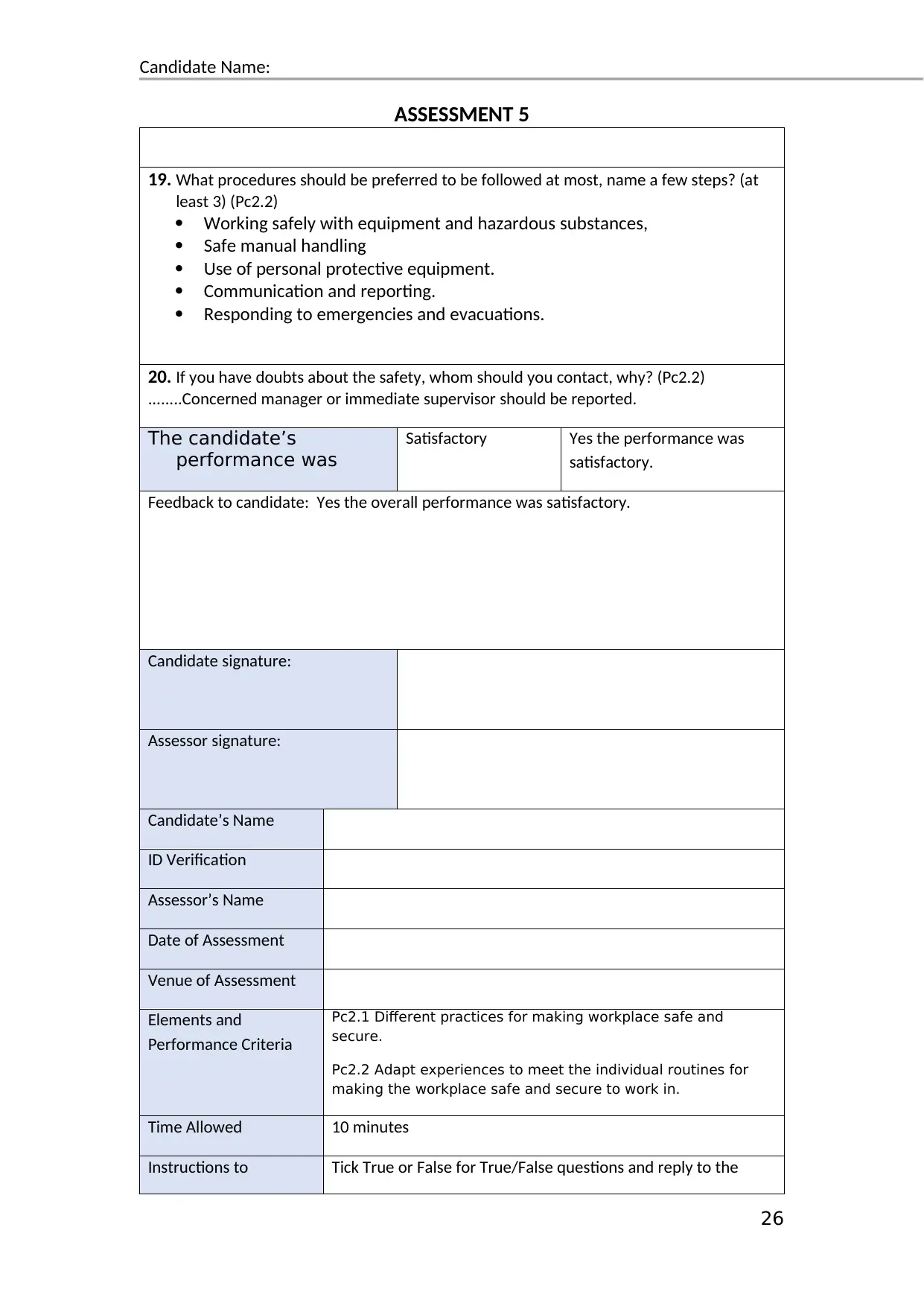
Candidate Name:
ASSESSMENT 5
19. What procedures should be preferred to be followed at most, name a few steps? (at
least 3) (Pc2.2)
Working safely with equipment and hazardous substances,
Safe manual handling
Use of personal protective equipment.
Communication and reporting.
Responding to emergencies and evacuations.
20. If you have doubts about the safety, whom should you contact, why? (Pc2.2)
........Concerned manager or immediate supervisor should be reported.
The candidate’s
performance was
Satisfactory Yes the performance was
satisfactory.
Feedback to candidate: Yes the overall performance was satisfactory.
Candidate signature:
Assessor signature:
Candidate’s Name
ID Verification
Assessor’s Name
Date of Assessment
Venue of Assessment
Elements and
Performance Criteria
Pc2.1 Different practices for making workplace safe and
secure.
Pc2.2 Adapt experiences to meet the individual routines for
making the workplace safe and secure to work in.
Time Allowed 10 minutes
Instructions to Tick True or False for True/False questions and reply to the
26
ASSESSMENT 5
19. What procedures should be preferred to be followed at most, name a few steps? (at
least 3) (Pc2.2)
Working safely with equipment and hazardous substances,
Safe manual handling
Use of personal protective equipment.
Communication and reporting.
Responding to emergencies and evacuations.
20. If you have doubts about the safety, whom should you contact, why? (Pc2.2)
........Concerned manager or immediate supervisor should be reported.
The candidate’s
performance was
Satisfactory Yes the performance was
satisfactory.
Feedback to candidate: Yes the overall performance was satisfactory.
Candidate signature:
Assessor signature:
Candidate’s Name
ID Verification
Assessor’s Name
Date of Assessment
Venue of Assessment
Elements and
Performance Criteria
Pc2.1 Different practices for making workplace safe and
secure.
Pc2.2 Adapt experiences to meet the individual routines for
making the workplace safe and secure to work in.
Time Allowed 10 minutes
Instructions to Tick True or False for True/False questions and reply to the
26
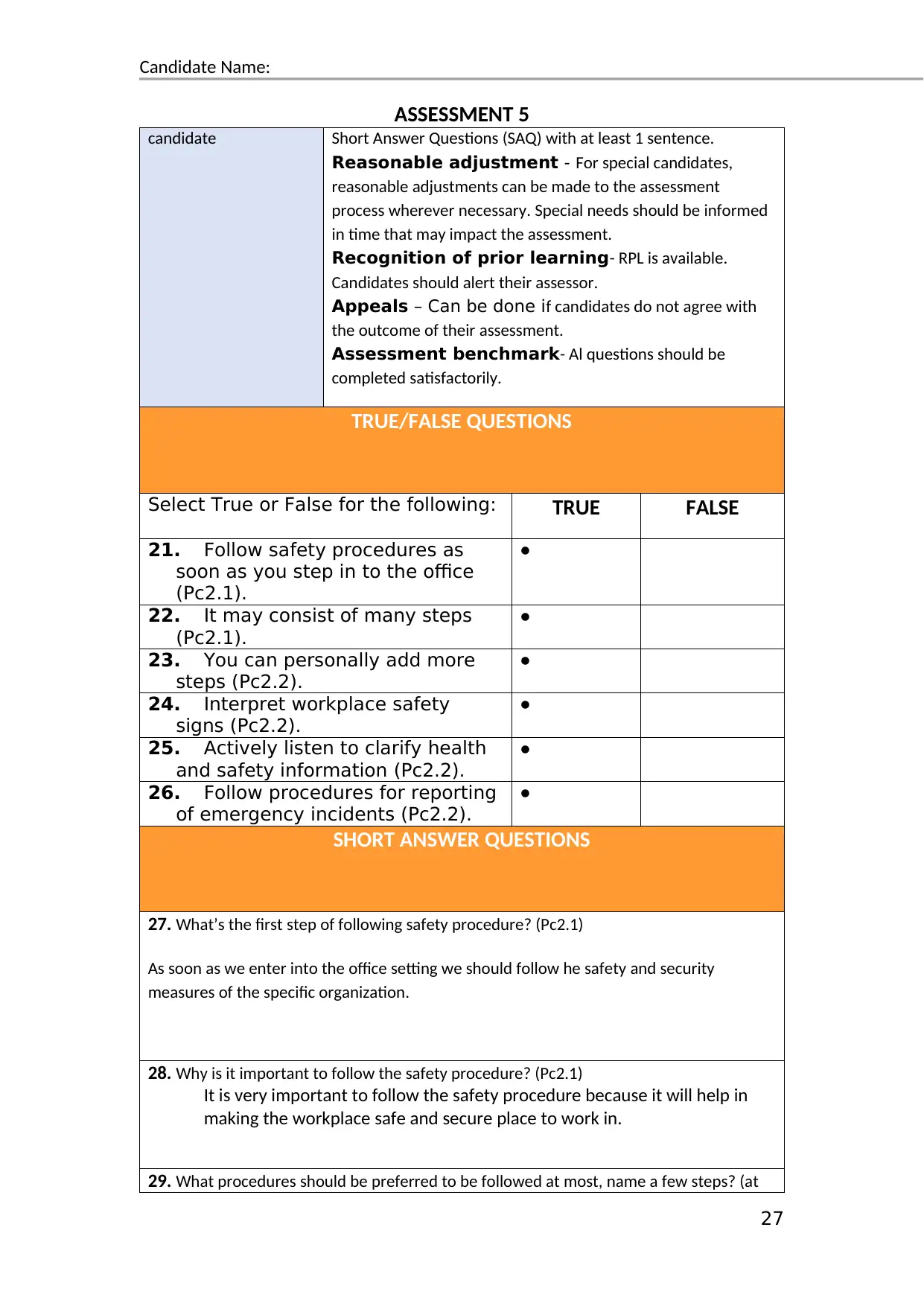
Candidate Name:
ASSESSMENT 5
candidate Short Answer Questions (SAQ) with at least 1 sentence.
Reasonable adjustment - For special candidates,
reasonable adjustments can be made to the assessment
process wherever necessary. Special needs should be informed
in time that may impact the assessment.
Recognition of prior learning- RPL is available.
Candidates should alert their assessor.
Appeals – Can be done if candidates do not agree with
the outcome of their assessment.
Assessment benchmark- Al questions should be
completed satisfactorily.
TRUE/FALSE QUESTIONS
Select True or False for the following: TRUE FALSE
21. Follow safety procedures as
soon as you step in to the office
(Pc2.1).
●
22. It may consist of many steps
(Pc2.1).
●
23. You can personally add more
steps (Pc2.2).
●
24. Interpret workplace safety
signs (Pc2.2).
●
25. Actively listen to clarify health
and safety information (Pc2.2).
●
26. Follow procedures for reporting
of emergency incidents (Pc2.2).
●
SHORT ANSWER QUESTIONS
27. What’s the first step of following safety procedure? (Pc2.1)
As soon as we enter into the office setting we should follow he safety and security
measures of the specific organization.
28. Why is it important to follow the safety procedure? (Pc2.1)
It is very important to follow the safety procedure because it will help in
making the workplace safe and secure place to work in.
29. What procedures should be preferred to be followed at most, name a few steps? (at
27
ASSESSMENT 5
candidate Short Answer Questions (SAQ) with at least 1 sentence.
Reasonable adjustment - For special candidates,
reasonable adjustments can be made to the assessment
process wherever necessary. Special needs should be informed
in time that may impact the assessment.
Recognition of prior learning- RPL is available.
Candidates should alert their assessor.
Appeals – Can be done if candidates do not agree with
the outcome of their assessment.
Assessment benchmark- Al questions should be
completed satisfactorily.
TRUE/FALSE QUESTIONS
Select True or False for the following: TRUE FALSE
21. Follow safety procedures as
soon as you step in to the office
(Pc2.1).
●
22. It may consist of many steps
(Pc2.1).
●
23. You can personally add more
steps (Pc2.2).
●
24. Interpret workplace safety
signs (Pc2.2).
●
25. Actively listen to clarify health
and safety information (Pc2.2).
●
26. Follow procedures for reporting
of emergency incidents (Pc2.2).
●
SHORT ANSWER QUESTIONS
27. What’s the first step of following safety procedure? (Pc2.1)
As soon as we enter into the office setting we should follow he safety and security
measures of the specific organization.
28. Why is it important to follow the safety procedure? (Pc2.1)
It is very important to follow the safety procedure because it will help in
making the workplace safe and secure place to work in.
29. What procedures should be preferred to be followed at most, name a few steps? (at
27
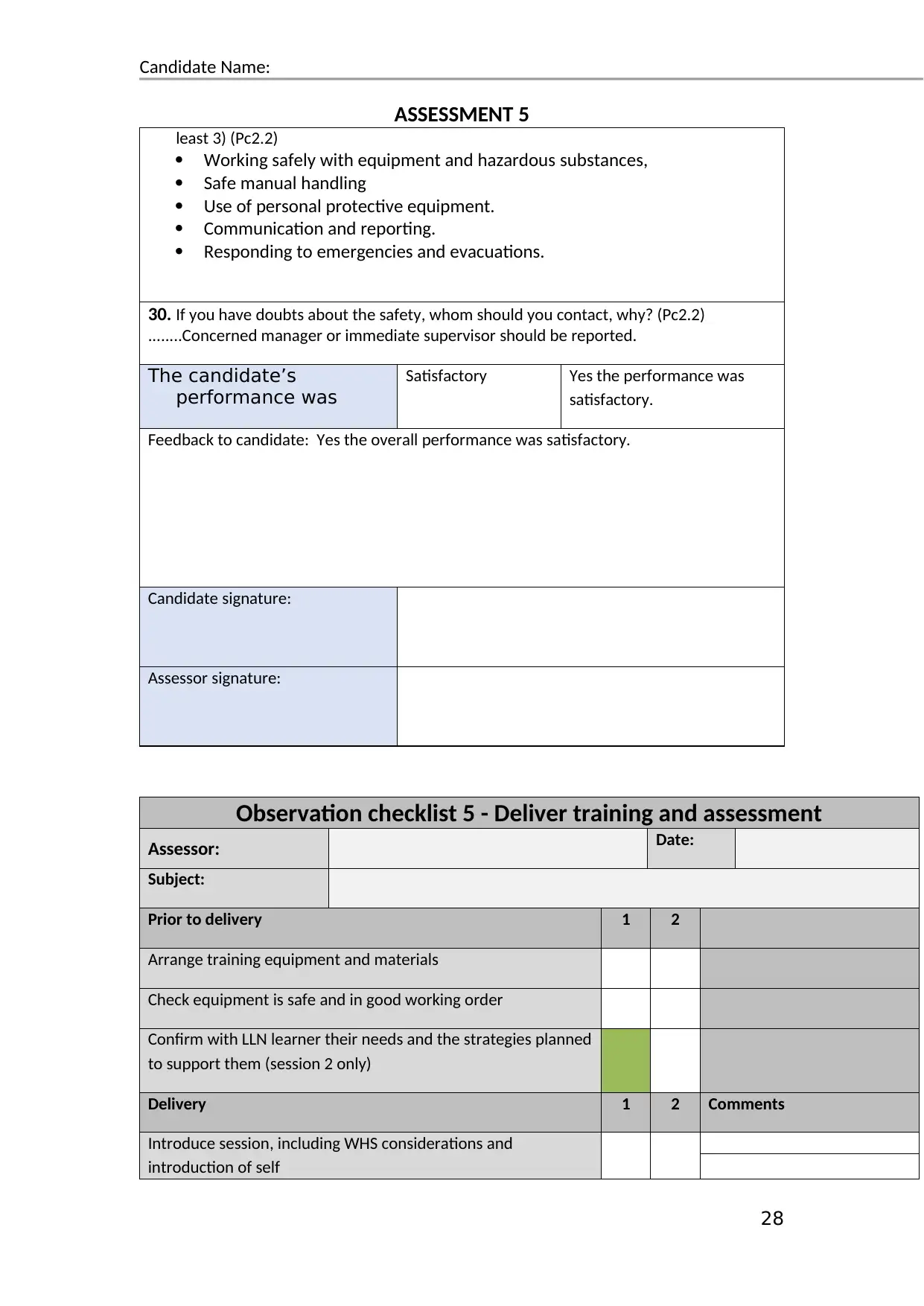
Candidate Name:
ASSESSMENT 5
least 3) (Pc2.2)
Working safely with equipment and hazardous substances,
Safe manual handling
Use of personal protective equipment.
Communication and reporting.
Responding to emergencies and evacuations.
30. If you have doubts about the safety, whom should you contact, why? (Pc2.2)
........Concerned manager or immediate supervisor should be reported.
The candidate’s
performance was
Satisfactory Yes the performance was
satisfactory.
Feedback to candidate: Yes the overall performance was satisfactory.
Candidate signature:
Assessor signature:
Observation checklist 5 - Deliver training and assessment
Assessor: Date:
Subject:
Prior to delivery 1 2
Arrange training equipment and materials
Check equipment is safe and in good working order
Confirm with LLN learner their needs and the strategies planned
to support them (session 2 only)
Delivery 1 2 Comments
Introduce session, including WHS considerations and
introduction of self
28
ASSESSMENT 5
least 3) (Pc2.2)
Working safely with equipment and hazardous substances,
Safe manual handling
Use of personal protective equipment.
Communication and reporting.
Responding to emergencies and evacuations.
30. If you have doubts about the safety, whom should you contact, why? (Pc2.2)
........Concerned manager or immediate supervisor should be reported.
The candidate’s
performance was
Satisfactory Yes the performance was
satisfactory.
Feedback to candidate: Yes the overall performance was satisfactory.
Candidate signature:
Assessor signature:
Observation checklist 5 - Deliver training and assessment
Assessor: Date:
Subject:
Prior to delivery 1 2
Arrange training equipment and materials
Check equipment is safe and in good working order
Confirm with LLN learner their needs and the strategies planned
to support them (session 2 only)
Delivery 1 2 Comments
Introduce session, including WHS considerations and
introduction of self
28
Secure Best Marks with AI Grader
Need help grading? Try our AI Grader for instant feedback on your assignments.
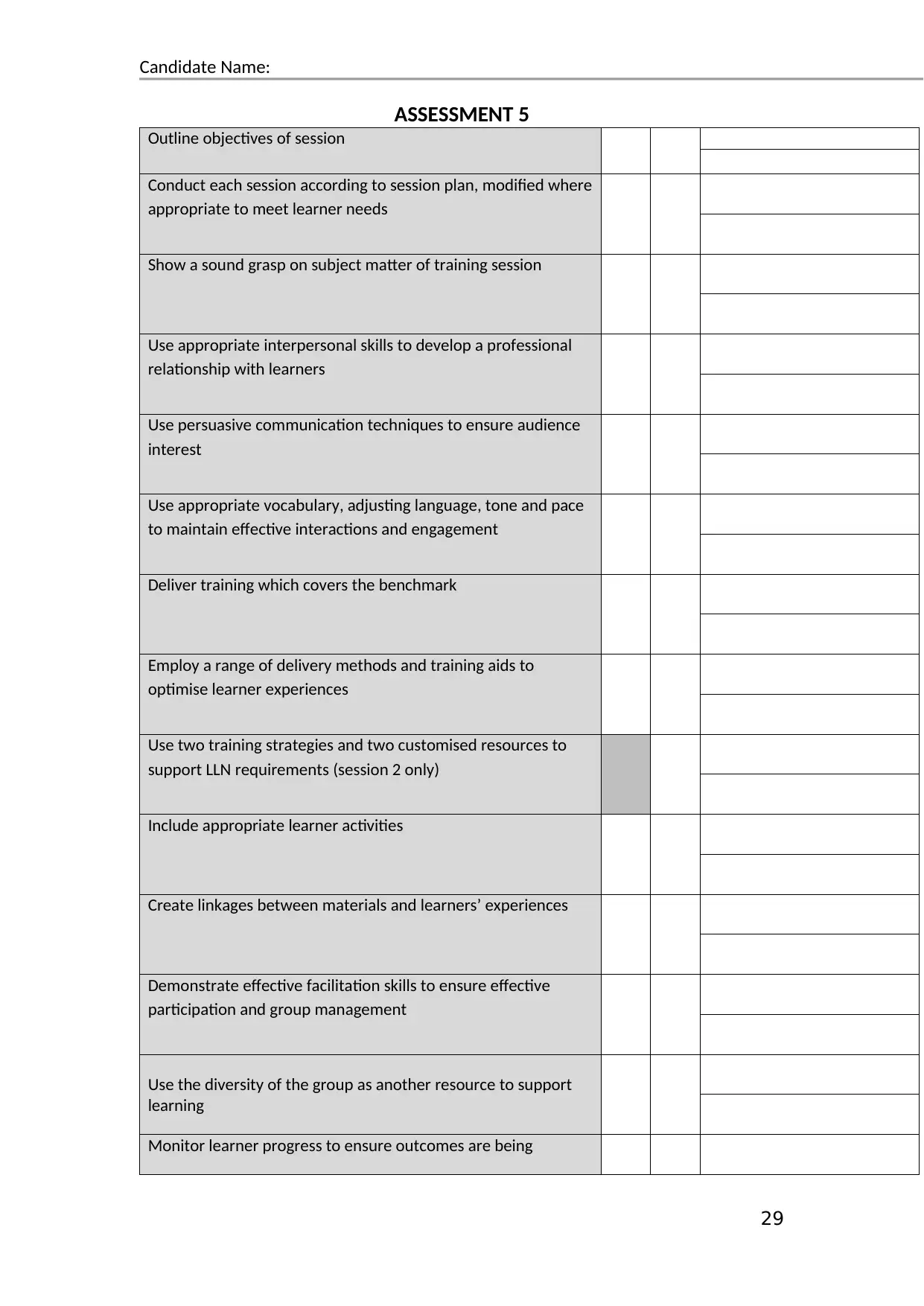
Candidate Name:
ASSESSMENT 5
Outline objectives of session
Conduct each session according to session plan, modified where
appropriate to meet learner needs
Show a sound grasp on subject matter of training session
Use appropriate interpersonal skills to develop a professional
relationship with learners
Use persuasive communication techniques to ensure audience
interest
Use appropriate vocabulary, adjusting language, tone and pace
to maintain effective interactions and engagement
Deliver training which covers the benchmark
Employ a range of delivery methods and training aids to
optimise learner experiences
Use two training strategies and two customised resources to
support LLN requirements (session 2 only)
Include appropriate learner activities
Create linkages between materials and learners’ experiences
Demonstrate effective facilitation skills to ensure effective
participation and group management
Use the diversity of the group as another resource to support
learning
Monitor learner progress to ensure outcomes are being
29
ASSESSMENT 5
Outline objectives of session
Conduct each session according to session plan, modified where
appropriate to meet learner needs
Show a sound grasp on subject matter of training session
Use appropriate interpersonal skills to develop a professional
relationship with learners
Use persuasive communication techniques to ensure audience
interest
Use appropriate vocabulary, adjusting language, tone and pace
to maintain effective interactions and engagement
Deliver training which covers the benchmark
Employ a range of delivery methods and training aids to
optimise learner experiences
Use two training strategies and two customised resources to
support LLN requirements (session 2 only)
Include appropriate learner activities
Create linkages between materials and learners’ experiences
Demonstrate effective facilitation skills to ensure effective
participation and group management
Use the diversity of the group as another resource to support
learning
Monitor learner progress to ensure outcomes are being
29
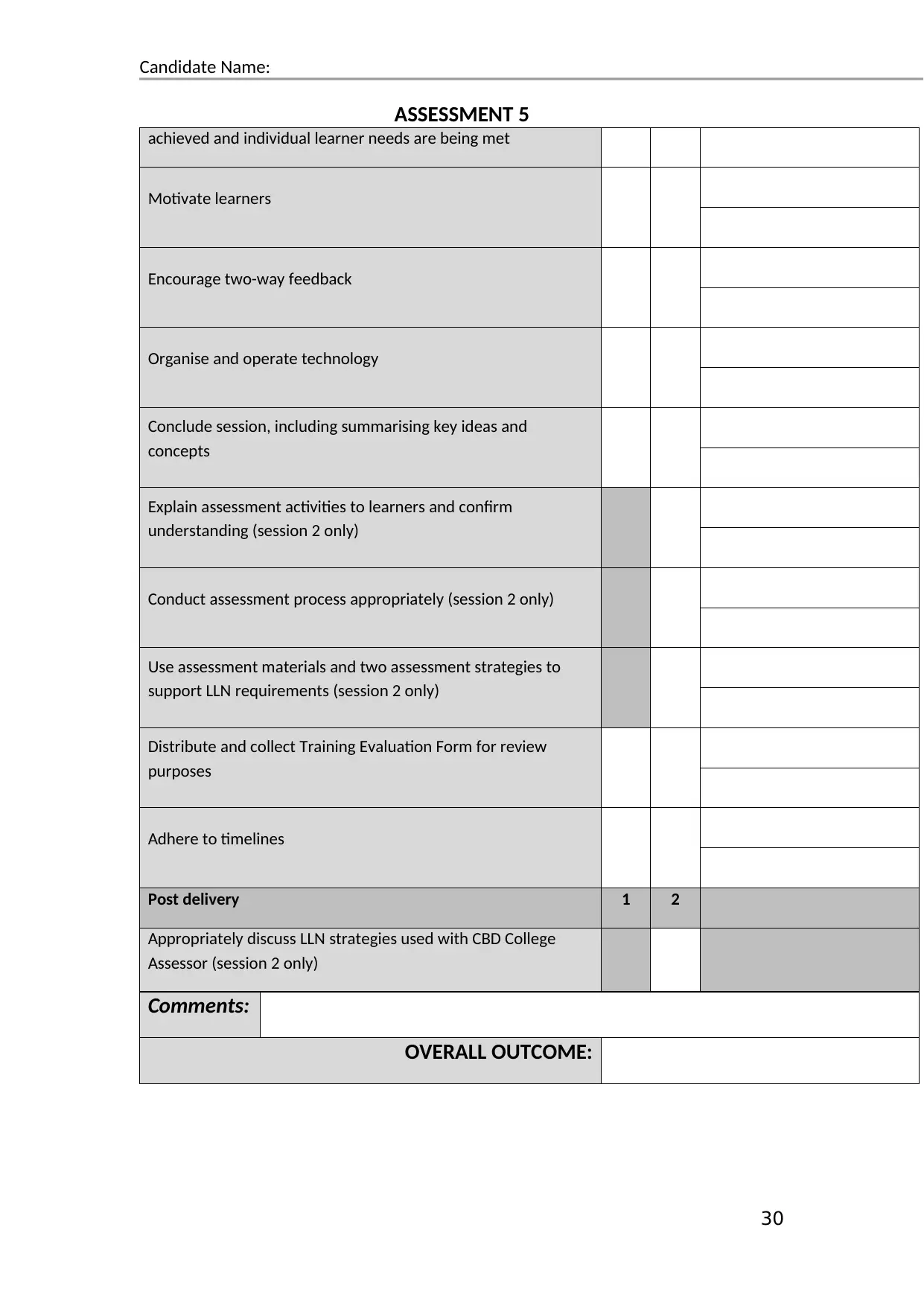
Candidate Name:
ASSESSMENT 5
achieved and individual learner needs are being met
Motivate learners
Encourage two-way feedback
Organise and operate technology
Conclude session, including summarising key ideas and
concepts
Explain assessment activities to learners and confirm
understanding (session 2 only)
Conduct assessment process appropriately (session 2 only)
Use assessment materials and two assessment strategies to
support LLN requirements (session 2 only)
Distribute and collect Training Evaluation Form for review
purposes
Adhere to timelines
Post delivery 1 2
Appropriately discuss LLN strategies used with CBD College
Assessor (session 2 only)
Comments:
OVERALL OUTCOME:
30
ASSESSMENT 5
achieved and individual learner needs are being met
Motivate learners
Encourage two-way feedback
Organise and operate technology
Conclude session, including summarising key ideas and
concepts
Explain assessment activities to learners and confirm
understanding (session 2 only)
Conduct assessment process appropriately (session 2 only)
Use assessment materials and two assessment strategies to
support LLN requirements (session 2 only)
Distribute and collect Training Evaluation Form for review
purposes
Adhere to timelines
Post delivery 1 2
Appropriately discuss LLN strategies used with CBD College
Assessor (session 2 only)
Comments:
OVERALL OUTCOME:
30
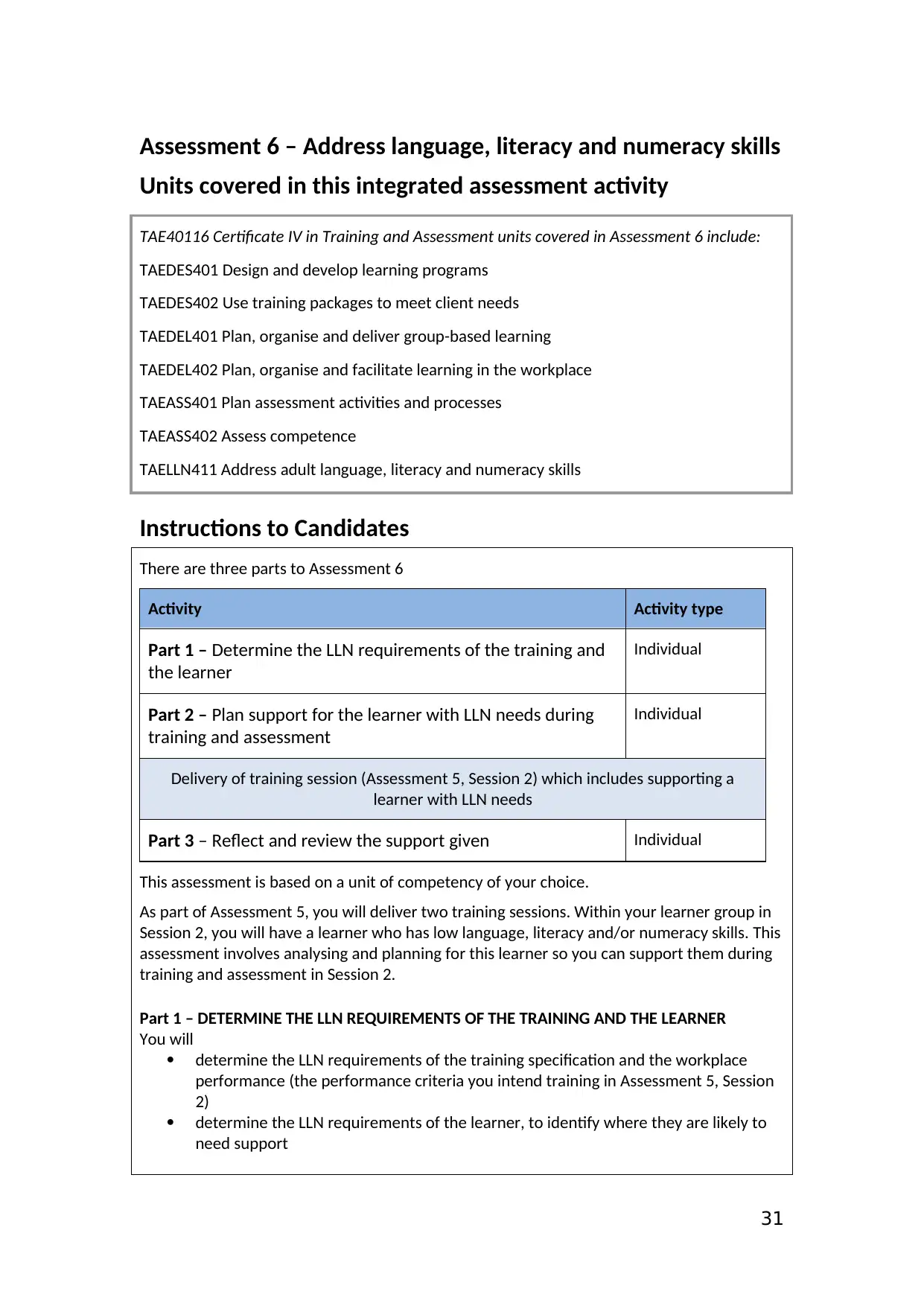
Assessment 6 – Address language, literacy and numeracy skills
Units covered in this integrated assessment activity
TAE40116 Certificate IV in Training and Assessment units covered in Assessment 6 include:
TAEDES401 Design and develop learning programs
TAEDES402 Use training packages to meet client needs
TAEDEL401 Plan, organise and deliver group-based learning
TAEDEL402 Plan, organise and facilitate learning in the workplace
TAEASS401 Plan assessment activities and processes
TAEASS402 Assess competence
TAELLN411 Address adult language, literacy and numeracy skills
Instructions to Candidates
There are three parts to Assessment 6
Activity Activity type
Part 1 – Determine the LLN requirements of the training and
the learner
Individual
Part 2 – Plan support for the learner with LLN needs during
training and assessment
Individual
Delivery of training session (Assessment 5, Session 2) which includes supporting a
learner with LLN needs
Part 3 – Reflect and review the support given Individual
This assessment is based on a unit of competency of your choice.
As part of Assessment 5, you will deliver two training sessions. Within your learner group in
Session 2, you will have a learner who has low language, literacy and/or numeracy skills. This
assessment involves analysing and planning for this learner so you can support them during
training and assessment in Session 2.
Part 1 – DETERMINE THE LLN REQUIREMENTS OF THE TRAINING AND THE LEARNER
You will
determine the LLN requirements of the training specification and the workplace
performance (the performance criteria you intend training in Assessment 5, Session
2)
determine the LLN requirements of the learner, to identify where they are likely to
need support
31
Units covered in this integrated assessment activity
TAE40116 Certificate IV in Training and Assessment units covered in Assessment 6 include:
TAEDES401 Design and develop learning programs
TAEDES402 Use training packages to meet client needs
TAEDEL401 Plan, organise and deliver group-based learning
TAEDEL402 Plan, organise and facilitate learning in the workplace
TAEASS401 Plan assessment activities and processes
TAEASS402 Assess competence
TAELLN411 Address adult language, literacy and numeracy skills
Instructions to Candidates
There are three parts to Assessment 6
Activity Activity type
Part 1 – Determine the LLN requirements of the training and
the learner
Individual
Part 2 – Plan support for the learner with LLN needs during
training and assessment
Individual
Delivery of training session (Assessment 5, Session 2) which includes supporting a
learner with LLN needs
Part 3 – Reflect and review the support given Individual
This assessment is based on a unit of competency of your choice.
As part of Assessment 5, you will deliver two training sessions. Within your learner group in
Session 2, you will have a learner who has low language, literacy and/or numeracy skills. This
assessment involves analysing and planning for this learner so you can support them during
training and assessment in Session 2.
Part 1 – DETERMINE THE LLN REQUIREMENTS OF THE TRAINING AND THE LEARNER
You will
determine the LLN requirements of the training specification and the workplace
performance (the performance criteria you intend training in Assessment 5, Session
2)
determine the LLN requirements of the learner, to identify where they are likely to
need support
31
Paraphrase This Document
Need a fresh take? Get an instant paraphrase of this document with our AI Paraphraser
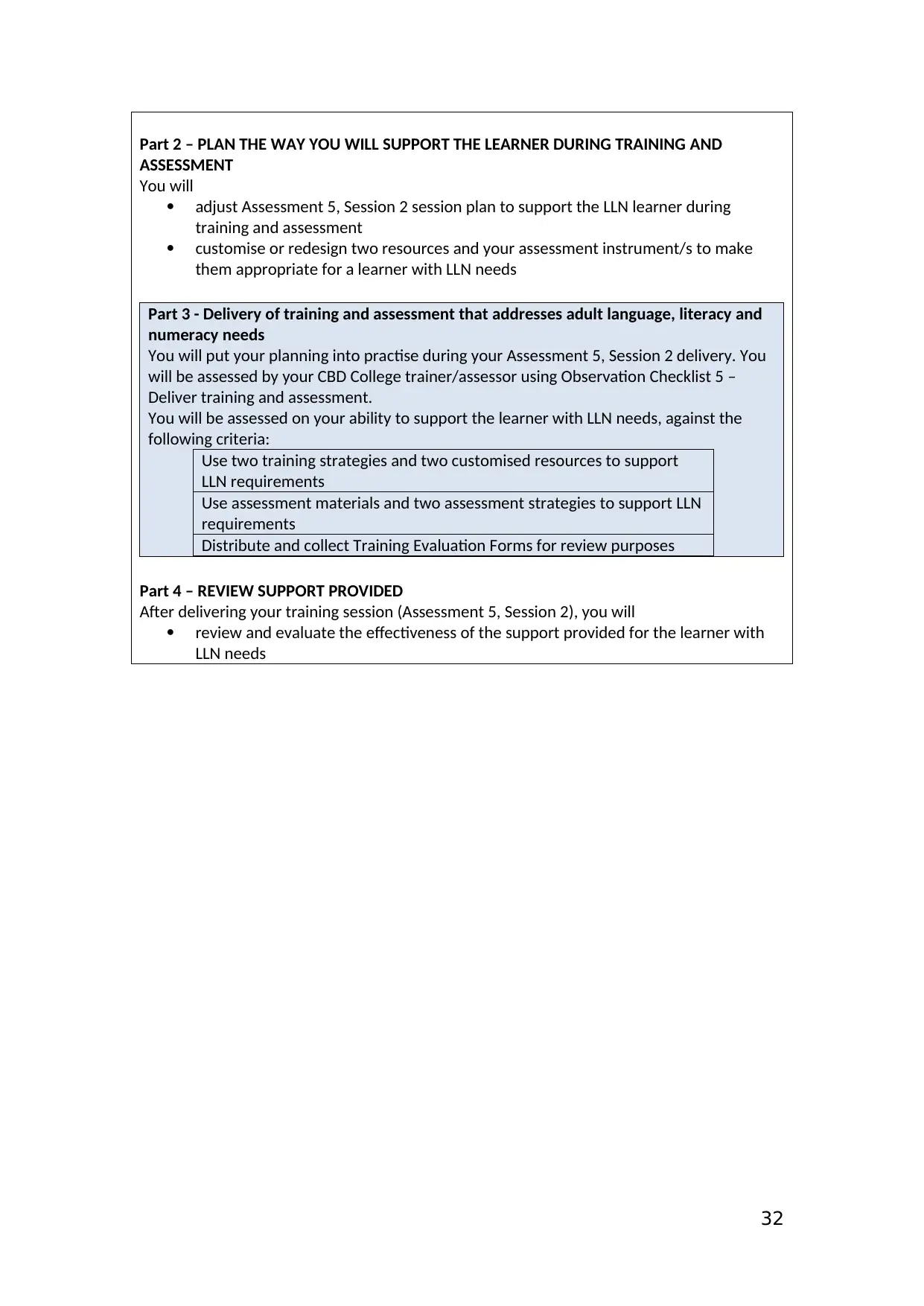
Part 2 – PLAN THE WAY YOU WILL SUPPORT THE LEARNER DURING TRAINING AND
ASSESSMENT
You will
adjust Assessment 5, Session 2 session plan to support the LLN learner during
training and assessment
customise or redesign two resources and your assessment instrument/s to make
them appropriate for a learner with LLN needs
Part 3 - Delivery of training and assessment that addresses adult language, literacy and
numeracy needs
You will put your planning into practise during your Assessment 5, Session 2 delivery. You
will be assessed by your CBD College trainer/assessor using Observation Checklist 5 –
Deliver training and assessment.
You will be assessed on your ability to support the learner with LLN needs, against the
following criteria:
Use two training strategies and two customised resources to support
LLN requirements
Use assessment materials and two assessment strategies to support LLN
requirements
Distribute and collect Training Evaluation Forms for review purposes
Part 4 – REVIEW SUPPORT PROVIDED
After delivering your training session (Assessment 5, Session 2), you will
review and evaluate the effectiveness of the support provided for the learner with
LLN needs
32
ASSESSMENT
You will
adjust Assessment 5, Session 2 session plan to support the LLN learner during
training and assessment
customise or redesign two resources and your assessment instrument/s to make
them appropriate for a learner with LLN needs
Part 3 - Delivery of training and assessment that addresses adult language, literacy and
numeracy needs
You will put your planning into practise during your Assessment 5, Session 2 delivery. You
will be assessed by your CBD College trainer/assessor using Observation Checklist 5 –
Deliver training and assessment.
You will be assessed on your ability to support the learner with LLN needs, against the
following criteria:
Use two training strategies and two customised resources to support
LLN requirements
Use assessment materials and two assessment strategies to support LLN
requirements
Distribute and collect Training Evaluation Forms for review purposes
Part 4 – REVIEW SUPPORT PROVIDED
After delivering your training session (Assessment 5, Session 2), you will
review and evaluate the effectiveness of the support provided for the learner with
LLN needs
32
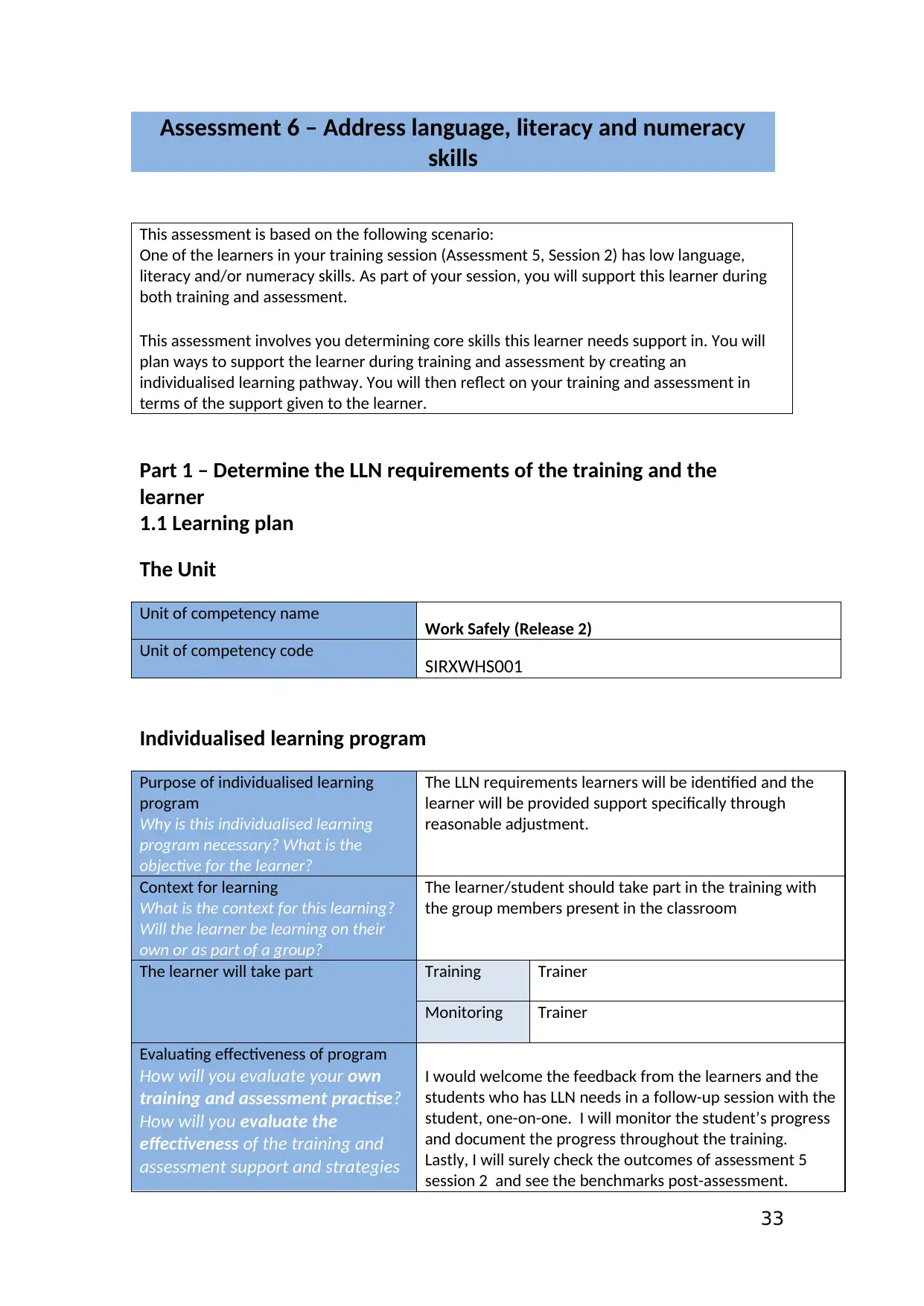
Assessment 6 – Address language, literacy and numeracy
skills
This assessment is based on the following scenario:
One of the learners in your training session (Assessment 5, Session 2) has low language,
literacy and/or numeracy skills. As part of your session, you will support this learner during
both training and assessment.
This assessment involves you determining core skills this learner needs support in. You will
plan ways to support the learner during training and assessment by creating an
individualised learning pathway. You will then reflect on your training and assessment in
terms of the support given to the learner.
Part 1 – Determine the LLN requirements of the training and the
learner
1.1 Learning plan
The Unit
Unit of competency name Work Safely (Release 2)
Unit of competency code SIRXWHS001
Individualised learning program
Purpose of individualised learning
program
Why is this individualised learning
program necessary? What is the
objective for the learner?
The LLN requirements learners will be identified and the
learner will be provided support specifically through
reasonable adjustment.
Context for learning
What is the context for this learning?
Will the learner be learning on their
own or as part of a group?
The learner/student should take part in the training with
the group members present in the classroom
The learner will take part Training Trainer
Monitoring Trainer
Evaluating effectiveness of program
How will you evaluate your own
training and assessment practise?
How will you evaluate the
effectiveness of the training and
assessment support and strategies
I would welcome the feedback from the learners and the
students who has LLN needs in a follow-up session with the
student, one-on-one. I will monitor the student’s progress
and document the progress throughout the training.
Lastly, I will surely check the outcomes of assessment 5
session 2 and see the benchmarks post-assessment.
33
skills
This assessment is based on the following scenario:
One of the learners in your training session (Assessment 5, Session 2) has low language,
literacy and/or numeracy skills. As part of your session, you will support this learner during
both training and assessment.
This assessment involves you determining core skills this learner needs support in. You will
plan ways to support the learner during training and assessment by creating an
individualised learning pathway. You will then reflect on your training and assessment in
terms of the support given to the learner.
Part 1 – Determine the LLN requirements of the training and the
learner
1.1 Learning plan
The Unit
Unit of competency name Work Safely (Release 2)
Unit of competency code SIRXWHS001
Individualised learning program
Purpose of individualised learning
program
Why is this individualised learning
program necessary? What is the
objective for the learner?
The LLN requirements learners will be identified and the
learner will be provided support specifically through
reasonable adjustment.
Context for learning
What is the context for this learning?
Will the learner be learning on their
own or as part of a group?
The learner/student should take part in the training with
the group members present in the classroom
The learner will take part Training Trainer
Monitoring Trainer
Evaluating effectiveness of program
How will you evaluate your own
training and assessment practise?
How will you evaluate the
effectiveness of the training and
assessment support and strategies
I would welcome the feedback from the learners and the
students who has LLN needs in a follow-up session with the
student, one-on-one. I will monitor the student’s progress
and document the progress throughout the training.
Lastly, I will surely check the outcomes of assessment 5
session 2 and see the benchmarks post-assessment.
33
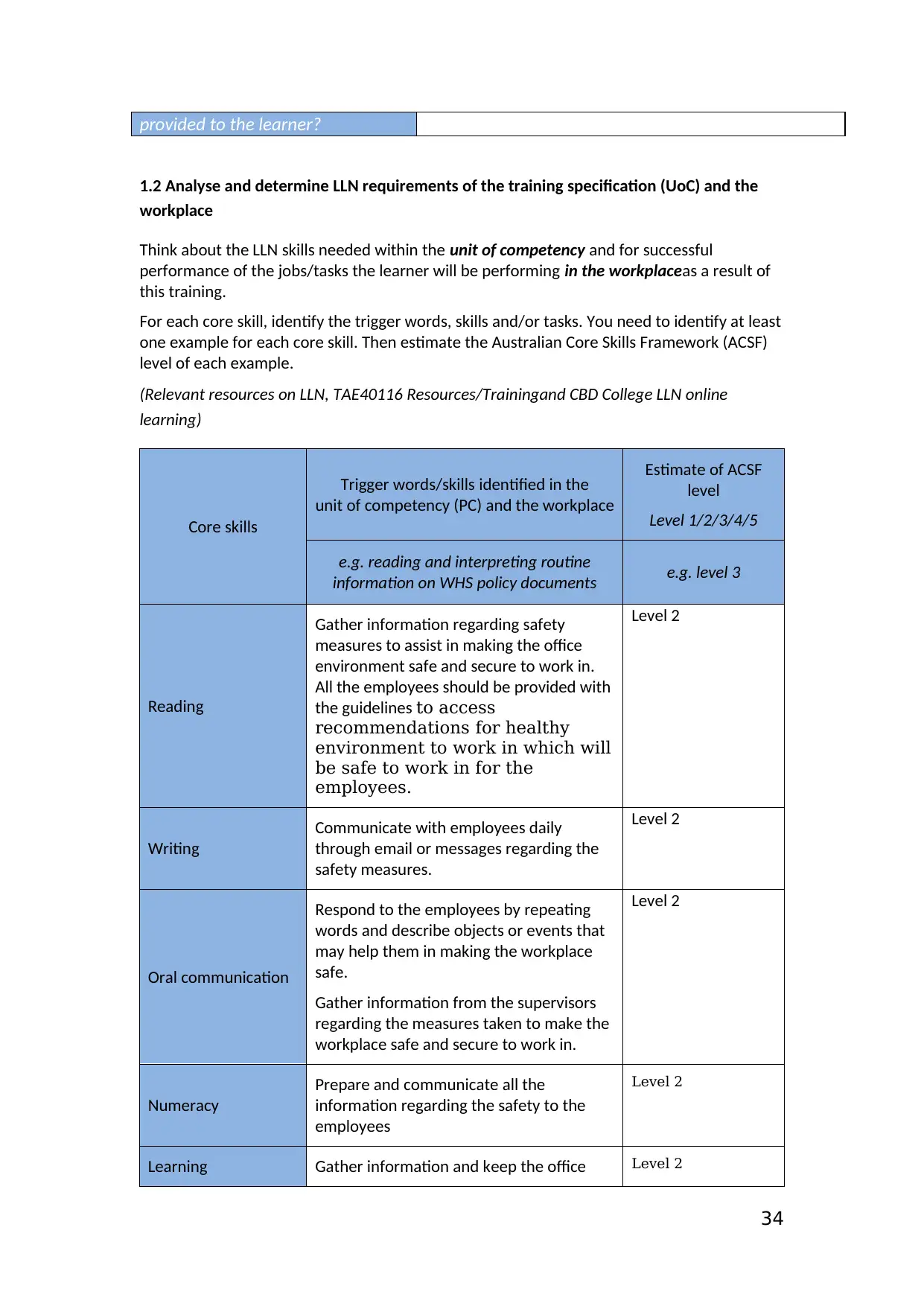
provided to the learner?
1.2 Analyse and determine LLN requirements of the training specification (UoC) and the
workplace
Think about the LLN skills needed within the unit of competency and for successful
performance of the jobs/tasks the learner will be performing in the workplaceas a result of
this training.
For each core skill, identify the trigger words, skills and/or tasks. You need to identify at least
one example for each core skill. Then estimate the Australian Core Skills Framework (ACSF)
level of each example.
(Relevant resources on LLN, TAE40116 Resources/Trainingand CBD College LLN online
learning)
Core skills
Trigger words/skills identified in the
unit of competency (PC) and the workplace
Estimate of ACSF
level
Level 1/2/3/4/5
e.g. reading and interpreting routine
information on WHS policy documents e.g. level 3
Reading
Gather information regarding safety
measures to assist in making the office
environment safe and secure to work in.
All the employees should be provided with
the guidelines to access
recommendations for healthy
environment to work in which will
be safe to work in for the
employees.
Level 2
Writing
Communicate with employees daily
through email or messages regarding the
safety measures.
Level 2
Oral communication
Respond to the employees by repeating
words and describe objects or events that
may help them in making the workplace
safe.
Gather information from the supervisors
regarding the measures taken to make the
workplace safe and secure to work in.
Level 2
Numeracy
Prepare and communicate all the
information regarding the safety to the
employees
Level 2
Learning Gather information and keep the office Level 2
34
1.2 Analyse and determine LLN requirements of the training specification (UoC) and the
workplace
Think about the LLN skills needed within the unit of competency and for successful
performance of the jobs/tasks the learner will be performing in the workplaceas a result of
this training.
For each core skill, identify the trigger words, skills and/or tasks. You need to identify at least
one example for each core skill. Then estimate the Australian Core Skills Framework (ACSF)
level of each example.
(Relevant resources on LLN, TAE40116 Resources/Trainingand CBD College LLN online
learning)
Core skills
Trigger words/skills identified in the
unit of competency (PC) and the workplace
Estimate of ACSF
level
Level 1/2/3/4/5
e.g. reading and interpreting routine
information on WHS policy documents e.g. level 3
Reading
Gather information regarding safety
measures to assist in making the office
environment safe and secure to work in.
All the employees should be provided with
the guidelines to access
recommendations for healthy
environment to work in which will
be safe to work in for the
employees.
Level 2
Writing
Communicate with employees daily
through email or messages regarding the
safety measures.
Level 2
Oral communication
Respond to the employees by repeating
words and describe objects or events that
may help them in making the workplace
safe.
Gather information from the supervisors
regarding the measures taken to make the
workplace safe and secure to work in.
Level 2
Numeracy
Prepare and communicate all the
information regarding the safety to the
employees
Level 2
Learning Gather information and keep the office Level 2
34
Secure Best Marks with AI Grader
Need help grading? Try our AI Grader for instant feedback on your assignments.
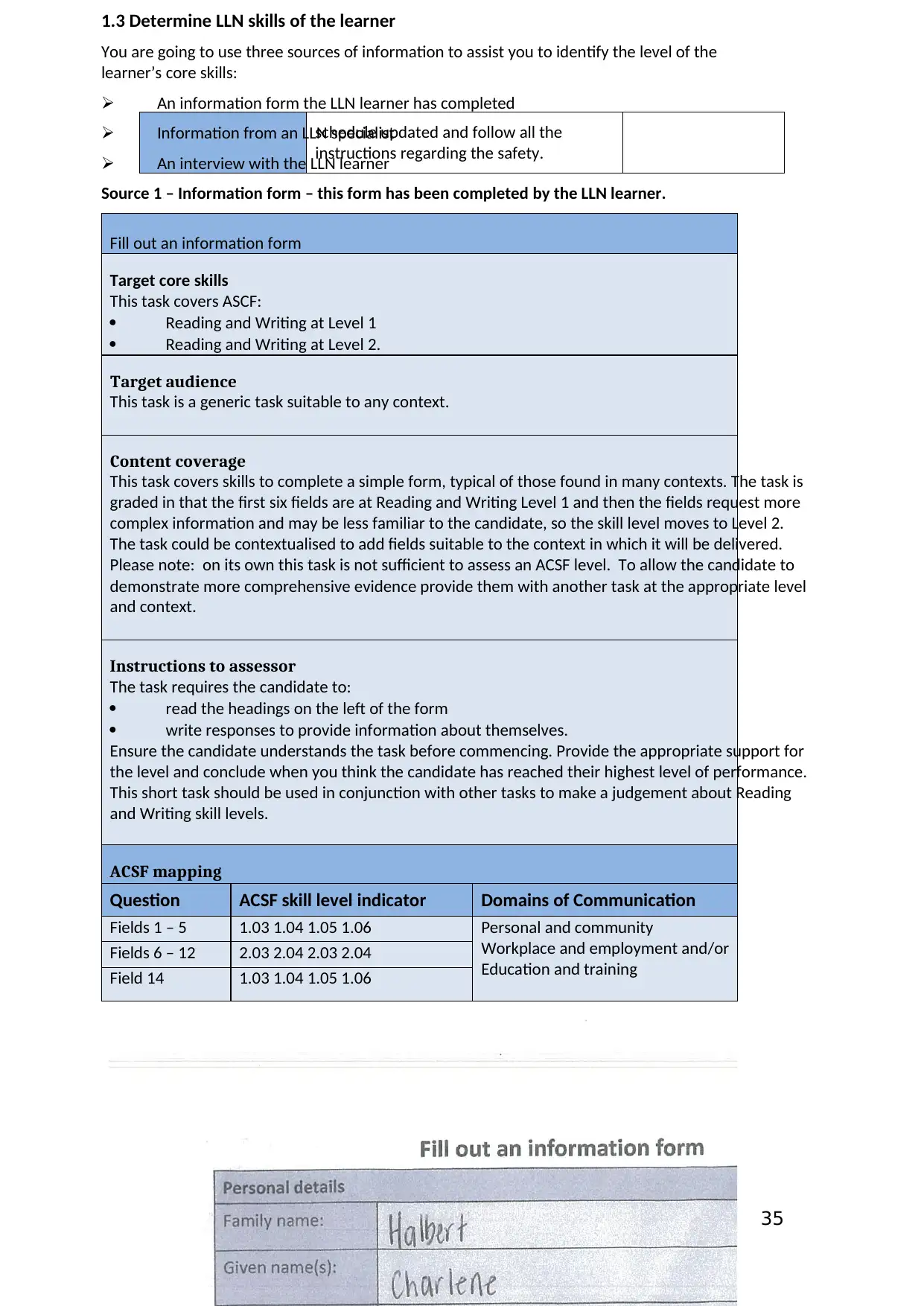
schedule updated and follow all the
instructions regarding the safety.
35
1.3 Determine LLN skills of the learner
You are going to use three sources of information to assist you to identify the level of the
learner’s core skills:
An information form the LLN learner has completed
Information from an LLN specialist
An interview with the LLN learner
Source 1 – Information form – this form has been completed by the LLN learner.
Fill out an information form
Target core skills
This task covers ASCF:
Reading and Writing at Level 1
Reading and Writing at Level 2.
Target audience
This task is a generic task suitable to any context.
Content coverage
This task covers skills to complete a simple form, typical of those found in many contexts. The task is
graded in that the first six fields are at Reading and Writing Level 1 and then the fields request more
complex information and may be less familiar to the candidate, so the skill level moves to Level 2.
The task could be contextualised to add fields suitable to the context in which it will be delivered.
Please note: on its own this task is not sufficient to assess an ACSF level. To allow the candidate to
demonstrate more comprehensive evidence provide them with another task at the appropriate level
and context.
Instructions to assessor
The task requires the candidate to:
read the headings on the left of the form
write responses to provide information about themselves.
Ensure the candidate understands the task before commencing. Provide the appropriate support for
the level and conclude when you think the candidate has reached their highest level of performance.
This short task should be used in conjunction with other tasks to make a judgement about Reading
and Writing skill levels.
ACSF mapping
Question ACSF skill level indicator Domains of Communication
Fields 1 – 5 1.03 1.04 1.05 1.06 Personal and community
Workplace and employment and/or
Education and training
Fields 6 – 12 2.03 2.04 2.03 2.04
Field 14 1.03 1.04 1.05 1.06
instructions regarding the safety.
35
1.3 Determine LLN skills of the learner
You are going to use three sources of information to assist you to identify the level of the
learner’s core skills:
An information form the LLN learner has completed
Information from an LLN specialist
An interview with the LLN learner
Source 1 – Information form – this form has been completed by the LLN learner.
Fill out an information form
Target core skills
This task covers ASCF:
Reading and Writing at Level 1
Reading and Writing at Level 2.
Target audience
This task is a generic task suitable to any context.
Content coverage
This task covers skills to complete a simple form, typical of those found in many contexts. The task is
graded in that the first six fields are at Reading and Writing Level 1 and then the fields request more
complex information and may be less familiar to the candidate, so the skill level moves to Level 2.
The task could be contextualised to add fields suitable to the context in which it will be delivered.
Please note: on its own this task is not sufficient to assess an ACSF level. To allow the candidate to
demonstrate more comprehensive evidence provide them with another task at the appropriate level
and context.
Instructions to assessor
The task requires the candidate to:
read the headings on the left of the form
write responses to provide information about themselves.
Ensure the candidate understands the task before commencing. Provide the appropriate support for
the level and conclude when you think the candidate has reached their highest level of performance.
This short task should be used in conjunction with other tasks to make a judgement about Reading
and Writing skill levels.
ACSF mapping
Question ACSF skill level indicator Domains of Communication
Fields 1 – 5 1.03 1.04 1.05 1.06 Personal and community
Workplace and employment and/or
Education and training
Fields 6 – 12 2.03 2.04 2.03 2.04
Field 14 1.03 1.04 1.05 1.06
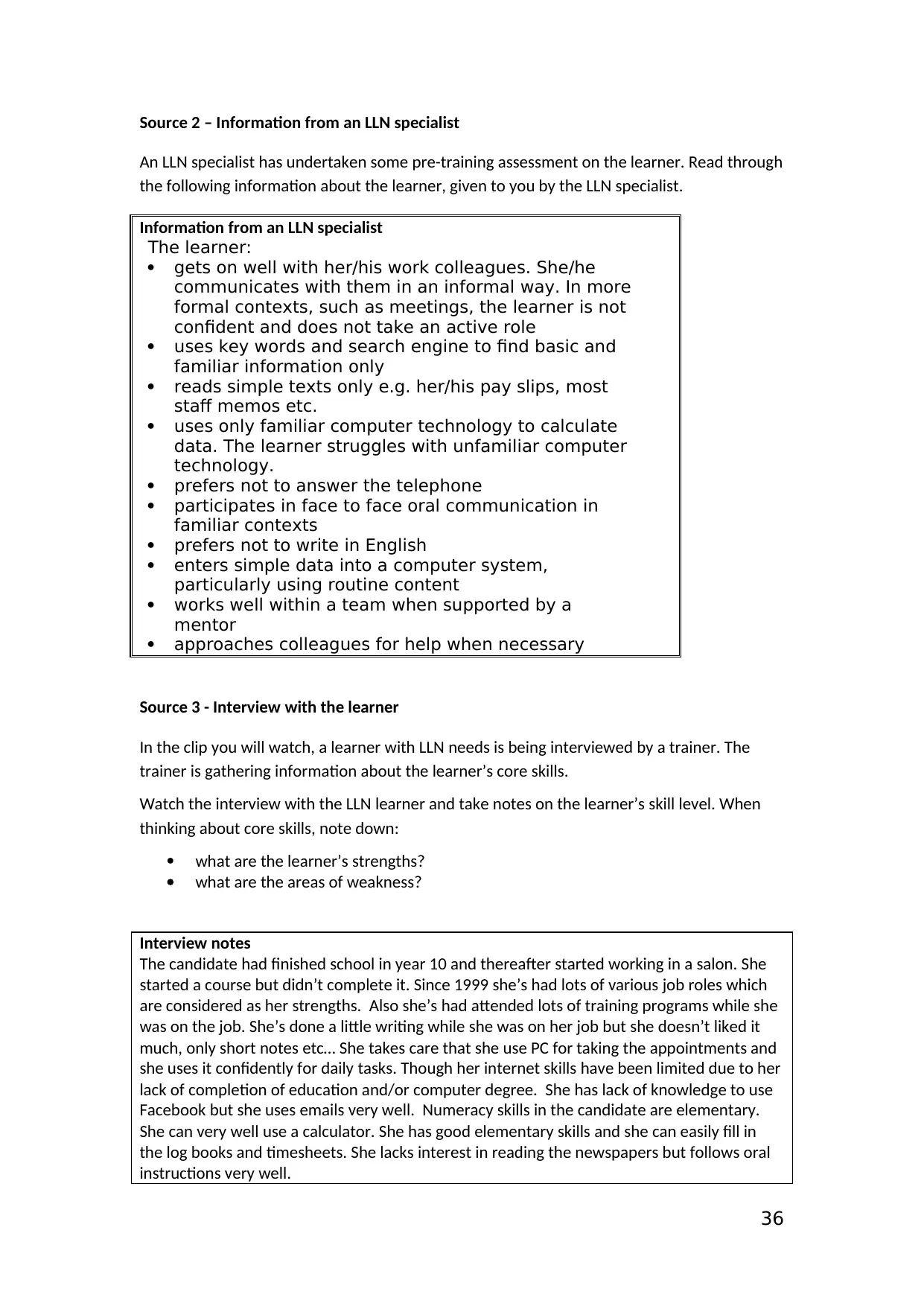
Source 2 – Information from an LLN specialist
An LLN specialist has undertaken some pre-training assessment on the learner. Read through
the following information about the learner, given to you by the LLN specialist.
Information from an LLN specialist
The learner:
gets on well with her/his work colleagues. She/he
communicates with them in an informal way. In more
formal contexts, such as meetings, the learner is not
confident and does not take an active role
uses key words and search engine to find basic and
familiar information only
reads simple texts only e.g. her/his pay slips, most
staff memos etc.
uses only familiar computer technology to calculate
data. The learner struggles with unfamiliar computer
technology.
prefers not to answer the telephone
participates in face to face oral communication in
familiar contexts
prefers not to write in English
enters simple data into a computer system,
particularly using routine content
works well within a team when supported by a
mentor
approaches colleagues for help when necessary
Source 3 - Interview with the learner
In the clip you will watch, a learner with LLN needs is being interviewed by a trainer. The
trainer is gathering information about the learner’s core skills.
Watch the interview with the LLN learner and take notes on the learner’s skill level. When
thinking about core skills, note down:
what are the learner’s strengths?
what are the areas of weakness?
Interview notes
The candidate had finished school in year 10 and thereafter started working in a salon. She
started a course but didn’t complete it. Since 1999 she’s had lots of various job roles which
are considered as her strengths. Also she’s had attended lots of training programs while she
was on the job. She’s done a little writing while she was on her job but she doesn’t liked it
much, only short notes etc… She takes care that she use PC for taking the appointments and
she uses it confidently for daily tasks. Though her internet skills have been limited due to her
lack of completion of education and/or computer degree. She has lack of knowledge to use
Facebook but she uses emails very well. Numeracy skills in the candidate are elementary.
She can very well use a calculator. She has good elementary skills and she can easily fill in
the log books and timesheets. She lacks interest in reading the newspapers but follows oral
instructions very well.
36
An LLN specialist has undertaken some pre-training assessment on the learner. Read through
the following information about the learner, given to you by the LLN specialist.
Information from an LLN specialist
The learner:
gets on well with her/his work colleagues. She/he
communicates with them in an informal way. In more
formal contexts, such as meetings, the learner is not
confident and does not take an active role
uses key words and search engine to find basic and
familiar information only
reads simple texts only e.g. her/his pay slips, most
staff memos etc.
uses only familiar computer technology to calculate
data. The learner struggles with unfamiliar computer
technology.
prefers not to answer the telephone
participates in face to face oral communication in
familiar contexts
prefers not to write in English
enters simple data into a computer system,
particularly using routine content
works well within a team when supported by a
mentor
approaches colleagues for help when necessary
Source 3 - Interview with the learner
In the clip you will watch, a learner with LLN needs is being interviewed by a trainer. The
trainer is gathering information about the learner’s core skills.
Watch the interview with the LLN learner and take notes on the learner’s skill level. When
thinking about core skills, note down:
what are the learner’s strengths?
what are the areas of weakness?
Interview notes
The candidate had finished school in year 10 and thereafter started working in a salon. She
started a course but didn’t complete it. Since 1999 she’s had lots of various job roles which
are considered as her strengths. Also she’s had attended lots of training programs while she
was on the job. She’s done a little writing while she was on her job but she doesn’t liked it
much, only short notes etc… She takes care that she use PC for taking the appointments and
she uses it confidently for daily tasks. Though her internet skills have been limited due to her
lack of completion of education and/or computer degree. She has lack of knowledge to use
Facebook but she uses emails very well. Numeracy skills in the candidate are elementary.
She can very well use a calculator. She has good elementary skills and she can easily fill in
the log books and timesheets. She lacks interest in reading the newspapers but follows oral
instructions very well.
36
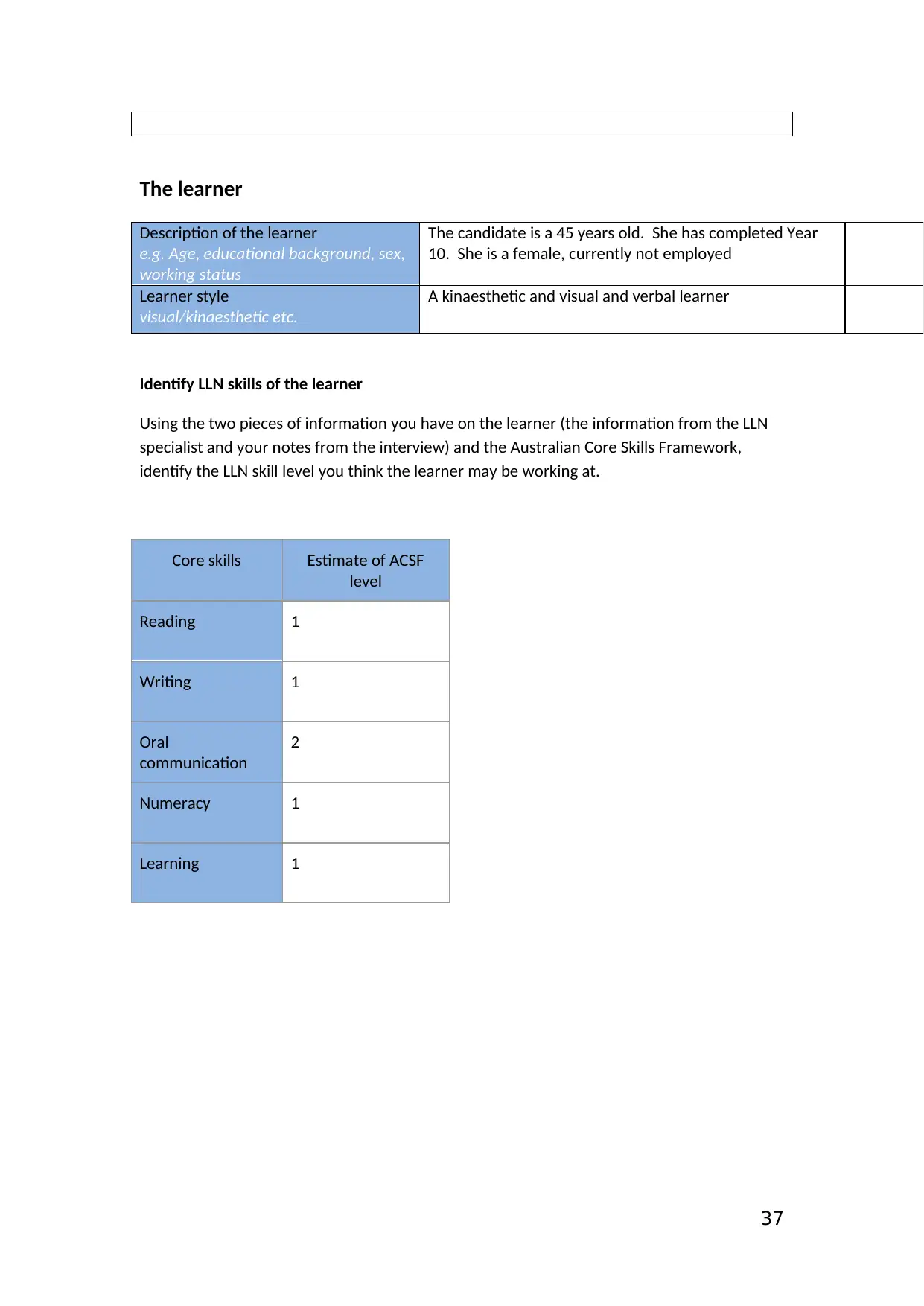
The learner
Description of the learner
e.g. Age, educational background, sex,
working status
The candidate is a 45 years old. She has completed Year
10. She is a female, currently not employed
Learner style
visual/kinaesthetic etc.
A kinaesthetic and visual and verbal learner
Identify LLN skills of the learner
Using the two pieces of information you have on the learner (the information from the LLN
specialist and your notes from the interview) and the Australian Core Skills Framework,
identify the LLN skill level you think the learner may be working at.
Core skills Estimate of ACSF
level
Reading 1
Writing 1
Oral
communication
2
Numeracy 1
Learning 1
37
Description of the learner
e.g. Age, educational background, sex,
working status
The candidate is a 45 years old. She has completed Year
10. She is a female, currently not employed
Learner style
visual/kinaesthetic etc.
A kinaesthetic and visual and verbal learner
Identify LLN skills of the learner
Using the two pieces of information you have on the learner (the information from the LLN
specialist and your notes from the interview) and the Australian Core Skills Framework,
identify the LLN skill level you think the learner may be working at.
Core skills Estimate of ACSF
level
Reading 1
Writing 1
Oral
communication
2
Numeracy 1
Learning 1
37
Paraphrase This Document
Need a fresh take? Get an instant paraphrase of this document with our AI Paraphraser
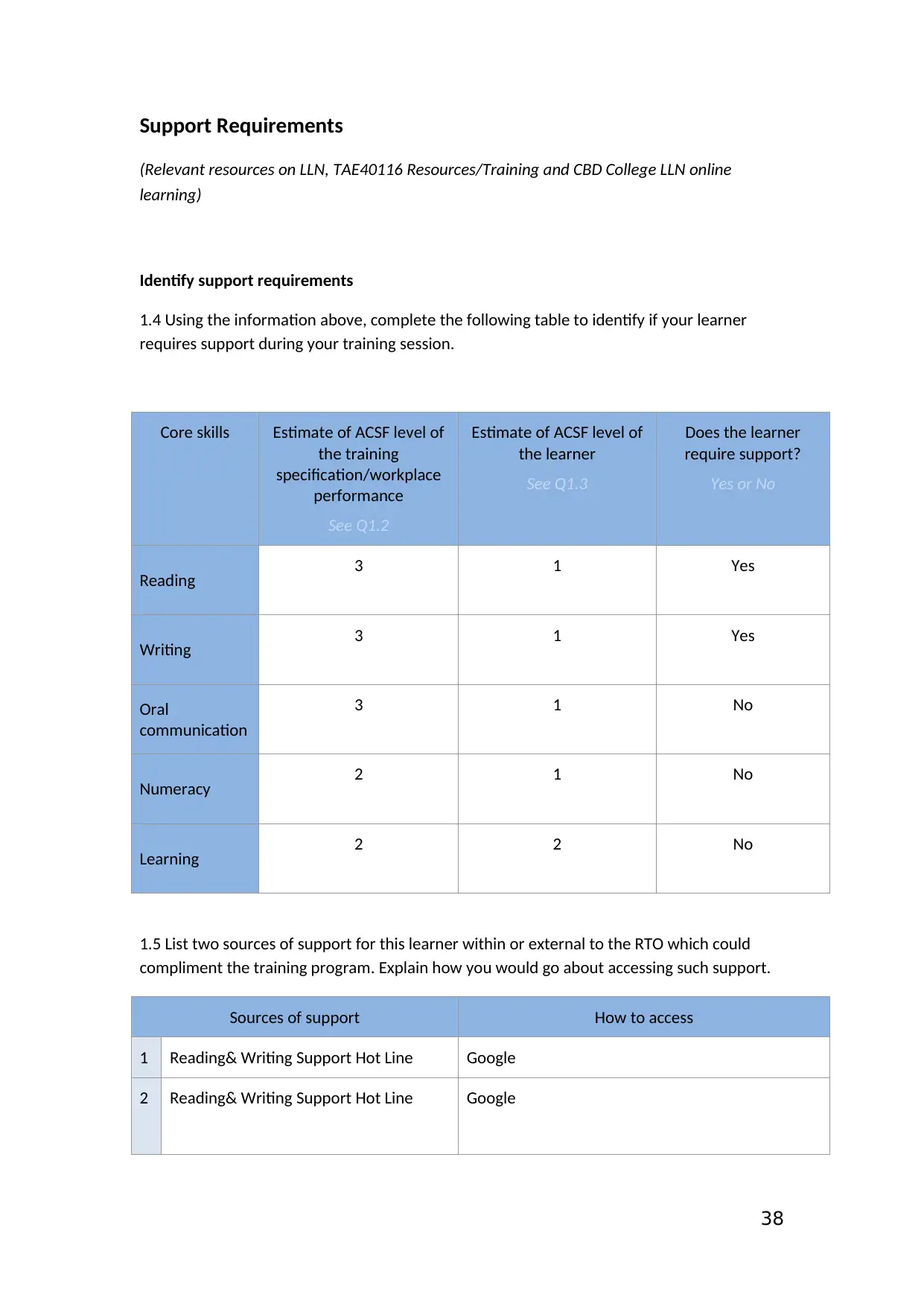
Support Requirements
(Relevant resources on LLN, TAE40116 Resources/Training and CBD College LLN online
learning)
Identify support requirements
1.4 Using the information above, complete the following table to identify if your learner
requires support during your training session.
Core skills Estimate of ACSF level of
the training
specification/workplace
performance
See Q1.2
Estimate of ACSF level of
the learner
See Q1.3
Does the learner
require support?
Yes or No
Reading 3 1 Yes
Writing 3 1 Yes
Oral
communication
3 1 No
Numeracy 2 1 No
Learning 2 2 No
1.5 List two sources of support for this learner within or external to the RTO which could
compliment the training program. Explain how you would go about accessing such support.
Sources of support How to access
1 Reading& Writing Support Hot Line Google
2 Reading& Writing Support Hot Line Google
38
(Relevant resources on LLN, TAE40116 Resources/Training and CBD College LLN online
learning)
Identify support requirements
1.4 Using the information above, complete the following table to identify if your learner
requires support during your training session.
Core skills Estimate of ACSF level of
the training
specification/workplace
performance
See Q1.2
Estimate of ACSF level of
the learner
See Q1.3
Does the learner
require support?
Yes or No
Reading 3 1 Yes
Writing 3 1 Yes
Oral
communication
3 1 No
Numeracy 2 1 No
Learning 2 2 No
1.5 List two sources of support for this learner within or external to the RTO which could
compliment the training program. Explain how you would go about accessing such support.
Sources of support How to access
1 Reading& Writing Support Hot Line Google
2 Reading& Writing Support Hot Line Google
38

1.6 Identify two resources which could support this learner’s LLN skill development. Explain
how you would go about accessing these resources.
Resources How to access
1 Glossary Trainer’s handout prior to session
2 Sharing pictures with her about the topic and
links to videos
Trainer’s handout prior to session
39
how you would go about accessing these resources.
Resources How to access
1 Glossary Trainer’s handout prior to session
2 Sharing pictures with her about the topic and
links to videos
Trainer’s handout prior to session
39
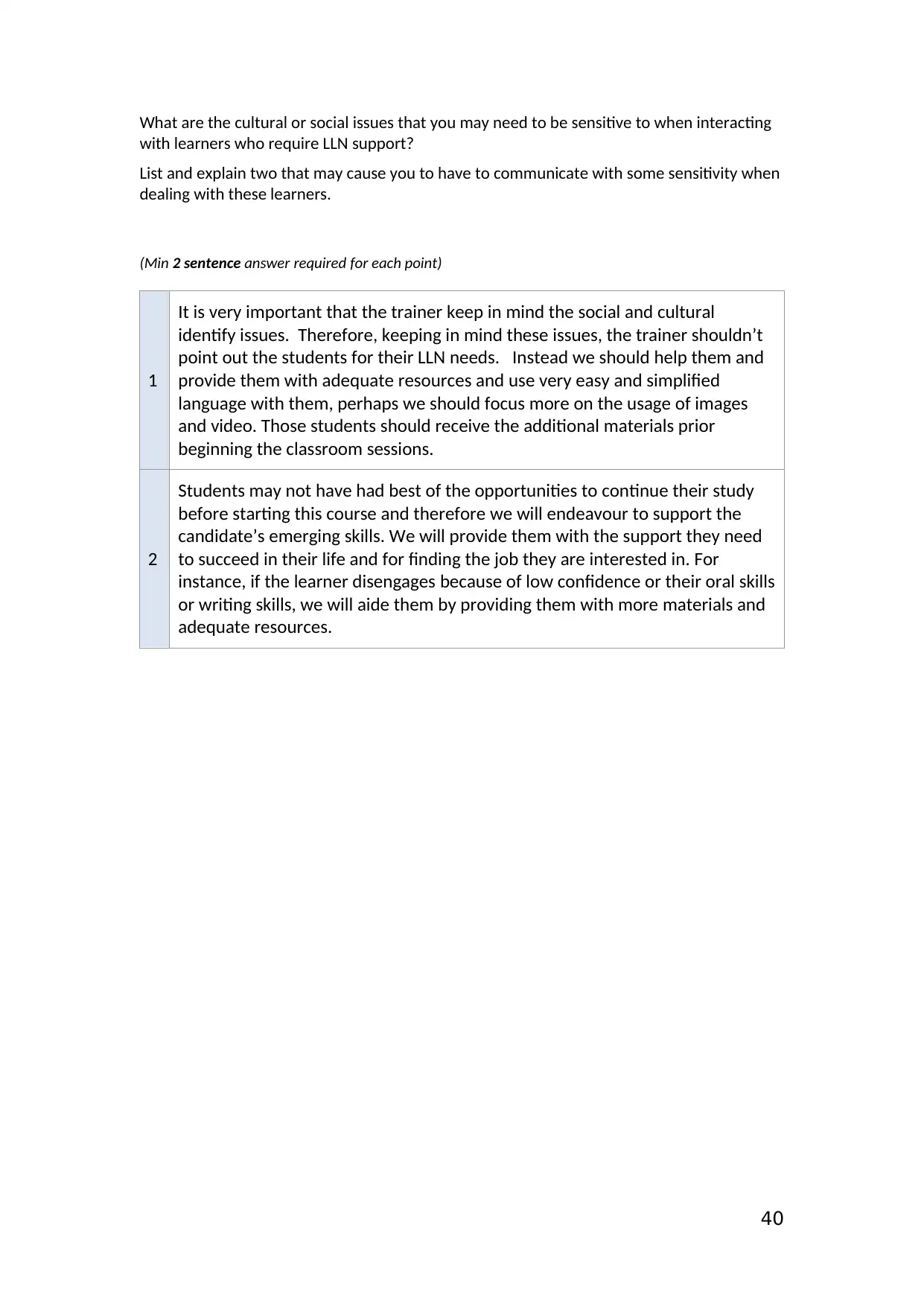
What are the cultural or social issues that you may need to be sensitive to when interacting
with learners who require LLN support?
List and explain two that may cause you to have to communicate with some sensitivity when
dealing with these learners.
(Min 2 sentence answer required for each point)
1
It is very important that the trainer keep in mind the social and cultural
identify issues. Therefore, keeping in mind these issues, the trainer shouldn’t
point out the students for their LLN needs. Instead we should help them and
provide them with adequate resources and use very easy and simplified
language with them, perhaps we should focus more on the usage of images
and video. Those students should receive the additional materials prior
beginning the classroom sessions.
2
Students may not have had best of the opportunities to continue their study
before starting this course and therefore we will endeavour to support the
candidate’s emerging skills. We will provide them with the support they need
to succeed in their life and for finding the job they are interested in. For
instance, if the learner disengages because of low confidence or their oral skills
or writing skills, we will aide them by providing them with more materials and
adequate resources.
40
with learners who require LLN support?
List and explain two that may cause you to have to communicate with some sensitivity when
dealing with these learners.
(Min 2 sentence answer required for each point)
1
It is very important that the trainer keep in mind the social and cultural
identify issues. Therefore, keeping in mind these issues, the trainer shouldn’t
point out the students for their LLN needs. Instead we should help them and
provide them with adequate resources and use very easy and simplified
language with them, perhaps we should focus more on the usage of images
and video. Those students should receive the additional materials prior
beginning the classroom sessions.
2
Students may not have had best of the opportunities to continue their study
before starting this course and therefore we will endeavour to support the
candidate’s emerging skills. We will provide them with the support they need
to succeed in their life and for finding the job they are interested in. For
instance, if the learner disengages because of low confidence or their oral skills
or writing skills, we will aide them by providing them with more materials and
adequate resources.
40
Secure Best Marks with AI Grader
Need help grading? Try our AI Grader for instant feedback on your assignments.
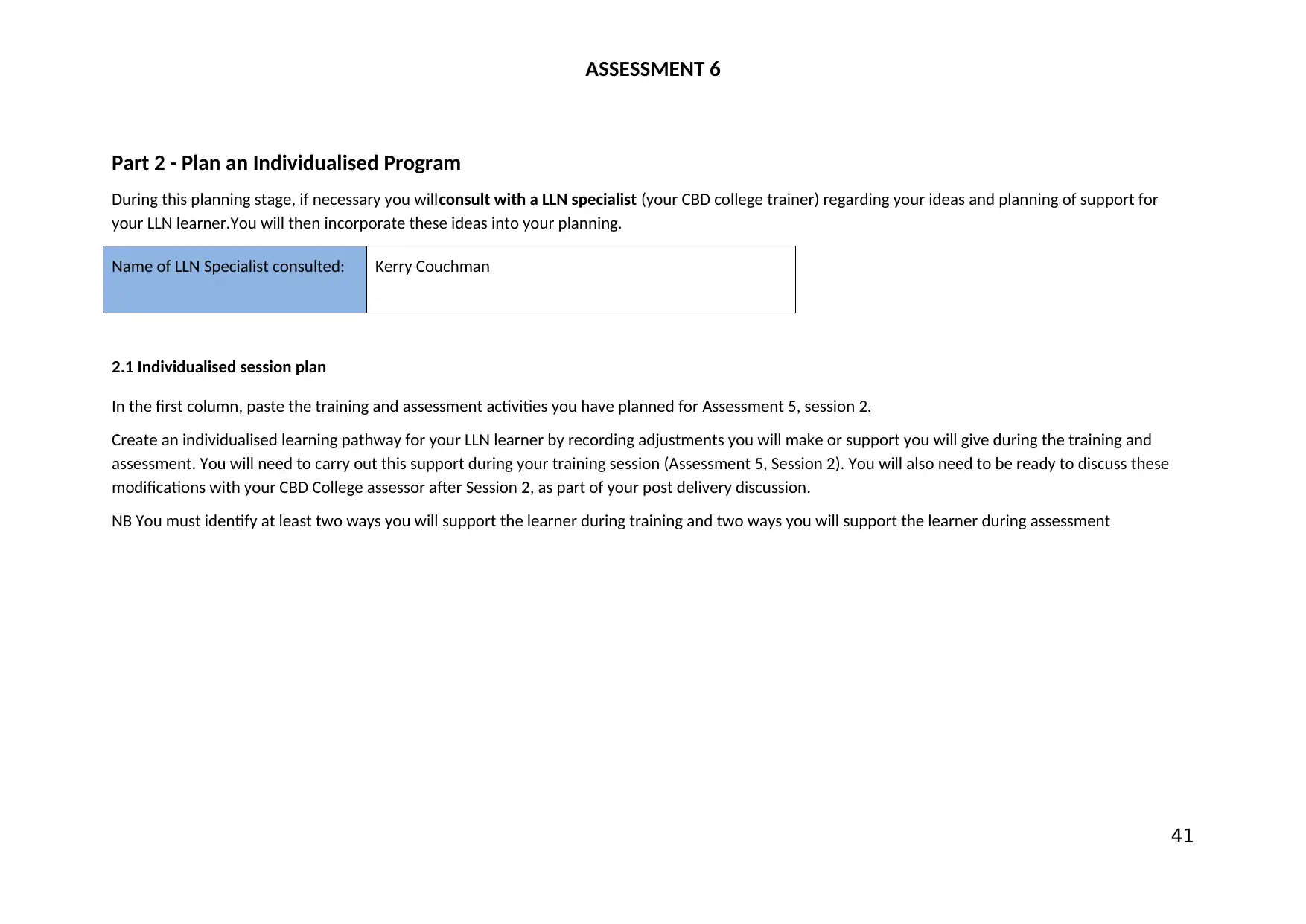
ASSESSMENT 6
Part 2 - Plan an Individualised Program
During this planning stage, if necessary you willconsult with a LLN specialist (your CBD college trainer) regarding your ideas and planning of support for
your LLN learner.You will then incorporate these ideas into your planning.
Name of LLN Specialist consulted: Kerry Couchman
2.1 Individualised session plan
In the first column, paste the training and assessment activities you have planned for Assessment 5, session 2.
Create an individualised learning pathway for your LLN learner by recording adjustments you will make or support you will give during the training and
assessment. You will need to carry out this support during your training session (Assessment 5, Session 2). You will also need to be ready to discuss these
modifications with your CBD College assessor after Session 2, as part of your post delivery discussion.
NB You must identify at least two ways you will support the learner during training and two ways you will support the learner during assessment
41
Part 2 - Plan an Individualised Program
During this planning stage, if necessary you willconsult with a LLN specialist (your CBD college trainer) regarding your ideas and planning of support for
your LLN learner.You will then incorporate these ideas into your planning.
Name of LLN Specialist consulted: Kerry Couchman
2.1 Individualised session plan
In the first column, paste the training and assessment activities you have planned for Assessment 5, session 2.
Create an individualised learning pathway for your LLN learner by recording adjustments you will make or support you will give during the training and
assessment. You will need to carry out this support during your training session (Assessment 5, Session 2). You will also need to be ready to discuss these
modifications with your CBD College assessor after Session 2, as part of your post delivery discussion.
NB You must identify at least two ways you will support the learner during training and two ways you will support the learner during assessment
41
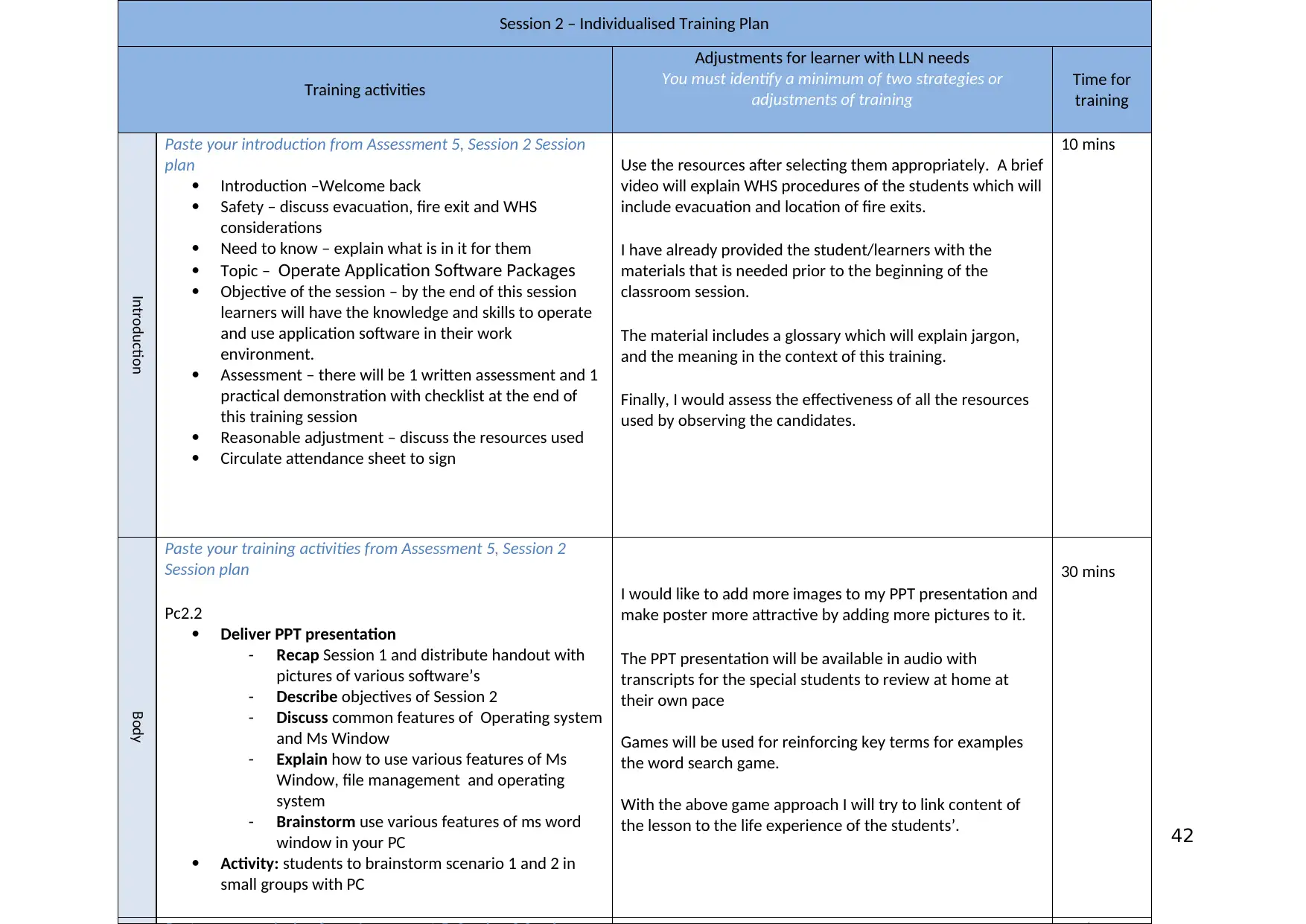
ASSESSMENT 6
42
Session 2 – Individualised Training Plan
Training activities
Adjustments for learner with LLN needs
You must identify a minimum of two strategies or
adjustments of training
Time for
training
Introduction
Paste your introduction from Assessment 5, Session 2 Session
plan
Introduction –Welcome back
Safety – discuss evacuation, fire exit and WHS
considerations
Need to know – explain what is in it for them
Topic – Operate Application Software Packages
Objective of the session – by the end of this session
learners will have the knowledge and skills to operate
and use application software in their work
environment.
Assessment – there will be 1 written assessment and 1
practical demonstration with checklist at the end of
this training session
Reasonable adjustment – discuss the resources used
Circulate attendance sheet to sign
Use the resources after selecting them appropriately. A brief
video will explain WHS procedures of the students which will
include evacuation and location of fire exits.
I have already provided the student/learners with the
materials that is needed prior to the beginning of the
classroom session.
The material includes a glossary which will explain jargon,
and the meaning in the context of this training.
Finally, I would assess the effectiveness of all the resources
used by observing the candidates.
10 mins
Body
Paste your training activities from Assessment 5, Session 2
Session plan
Pc2.2
Deliver PPT presentation
- Recap Session 1 and distribute handout with
pictures of various software’s
- Describe objectives of Session 2
- Discuss common features of Operating system
and Ms Window
- Explain how to use various features of Ms
Window, file management and operating
system
- Brainstorm use various features of ms word
window in your PC
Activity: students to brainstorm scenario 1 and 2 in
small groups with PC
I would like to add more images to my PPT presentation and
make poster more attractive by adding more pictures to it.
The PPT presentation will be available in audio with
transcripts for the special students to review at home at
their own pace
Games will be used for reinforcing key terms for examples
the word search game.
With the above game approach I will try to link content of
the lesson to the life experience of the students’.
30 mins
42
Session 2 – Individualised Training Plan
Training activities
Adjustments for learner with LLN needs
You must identify a minimum of two strategies or
adjustments of training
Time for
training
Introduction
Paste your introduction from Assessment 5, Session 2 Session
plan
Introduction –Welcome back
Safety – discuss evacuation, fire exit and WHS
considerations
Need to know – explain what is in it for them
Topic – Operate Application Software Packages
Objective of the session – by the end of this session
learners will have the knowledge and skills to operate
and use application software in their work
environment.
Assessment – there will be 1 written assessment and 1
practical demonstration with checklist at the end of
this training session
Reasonable adjustment – discuss the resources used
Circulate attendance sheet to sign
Use the resources after selecting them appropriately. A brief
video will explain WHS procedures of the students which will
include evacuation and location of fire exits.
I have already provided the student/learners with the
materials that is needed prior to the beginning of the
classroom session.
The material includes a glossary which will explain jargon,
and the meaning in the context of this training.
Finally, I would assess the effectiveness of all the resources
used by observing the candidates.
10 mins
Body
Paste your training activities from Assessment 5, Session 2
Session plan
Pc2.2
Deliver PPT presentation
- Recap Session 1 and distribute handout with
pictures of various software’s
- Describe objectives of Session 2
- Discuss common features of Operating system
and Ms Window
- Explain how to use various features of Ms
Window, file management and operating
system
- Brainstorm use various features of ms word
window in your PC
Activity: students to brainstorm scenario 1 and 2 in
small groups with PC
I would like to add more images to my PPT presentation and
make poster more attractive by adding more pictures to it.
The PPT presentation will be available in audio with
transcripts for the special students to review at home at
their own pace
Games will be used for reinforcing key terms for examples
the word search game.
With the above game approach I will try to link content of
the lesson to the life experience of the students’.
30 mins
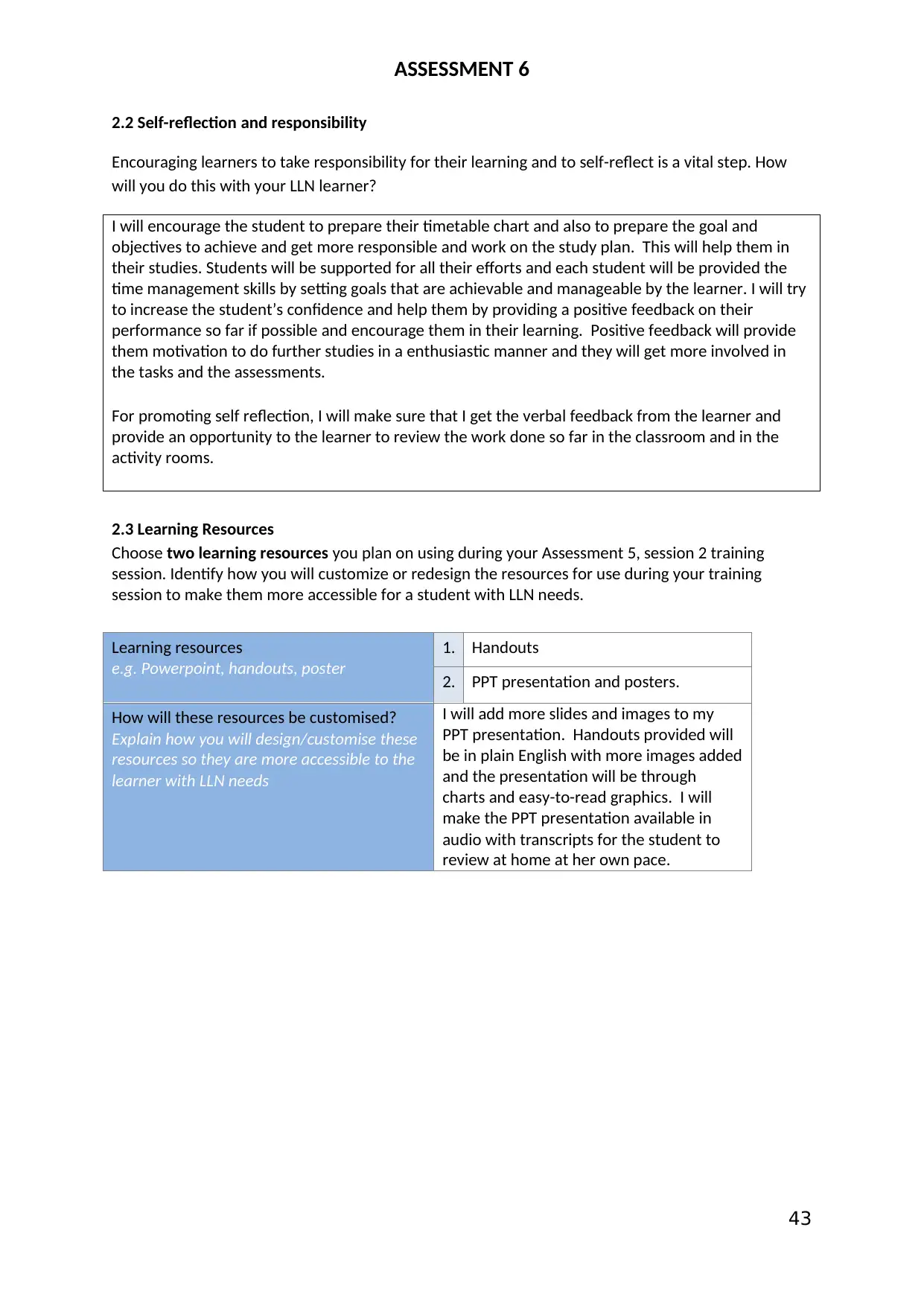
ASSESSMENT 6
2.2 Self-reflection and responsibility
Encouraging learners to take responsibility for their learning and to self-reflect is a vital step. How
will you do this with your LLN learner?
I will encourage the student to prepare their timetable chart and also to prepare the goal and
objectives to achieve and get more responsible and work on the study plan. This will help them in
their studies. Students will be supported for all their efforts and each student will be provided the
time management skills by setting goals that are achievable and manageable by the learner. I will try
to increase the student’s confidence and help them by providing a positive feedback on their
performance so far if possible and encourage them in their learning. Positive feedback will provide
them motivation to do further studies in a enthusiastic manner and they will get more involved in
the tasks and the assessments.
For promoting self reflection, I will make sure that I get the verbal feedback from the learner and
provide an opportunity to the learner to review the work done so far in the classroom and in the
activity rooms.
2.3 Learning Resources
Choose two learning resources you plan on using during your Assessment 5, session 2 training
session. Identify how you will customize or redesign the resources for use during your training
session to make them more accessible for a student with LLN needs.
Learning resources
e.g. Powerpoint, handouts, poster
1. Handouts
2. PPT presentation and posters.
How will these resources be customised?
Explain how you will design/customise these
resources so they are more accessible to the
learner with LLN needs
I will add more slides and images to my
PPT presentation. Handouts provided will
be in plain English with more images added
and the presentation will be through
charts and easy-to-read graphics. I will
make the PPT presentation available in
audio with transcripts for the student to
review at home at her own pace.
43
2.2 Self-reflection and responsibility
Encouraging learners to take responsibility for their learning and to self-reflect is a vital step. How
will you do this with your LLN learner?
I will encourage the student to prepare their timetable chart and also to prepare the goal and
objectives to achieve and get more responsible and work on the study plan. This will help them in
their studies. Students will be supported for all their efforts and each student will be provided the
time management skills by setting goals that are achievable and manageable by the learner. I will try
to increase the student’s confidence and help them by providing a positive feedback on their
performance so far if possible and encourage them in their learning. Positive feedback will provide
them motivation to do further studies in a enthusiastic manner and they will get more involved in
the tasks and the assessments.
For promoting self reflection, I will make sure that I get the verbal feedback from the learner and
provide an opportunity to the learner to review the work done so far in the classroom and in the
activity rooms.
2.3 Learning Resources
Choose two learning resources you plan on using during your Assessment 5, session 2 training
session. Identify how you will customize or redesign the resources for use during your training
session to make them more accessible for a student with LLN needs.
Learning resources
e.g. Powerpoint, handouts, poster
1. Handouts
2. PPT presentation and posters.
How will these resources be customised?
Explain how you will design/customise these
resources so they are more accessible to the
learner with LLN needs
I will add more slides and images to my
PPT presentation. Handouts provided will
be in plain English with more images added
and the presentation will be through
charts and easy-to-read graphics. I will
make the PPT presentation available in
audio with transcripts for the student to
review at home at her own pace.
43
Paraphrase This Document
Need a fresh take? Get an instant paraphrase of this document with our AI Paraphraser
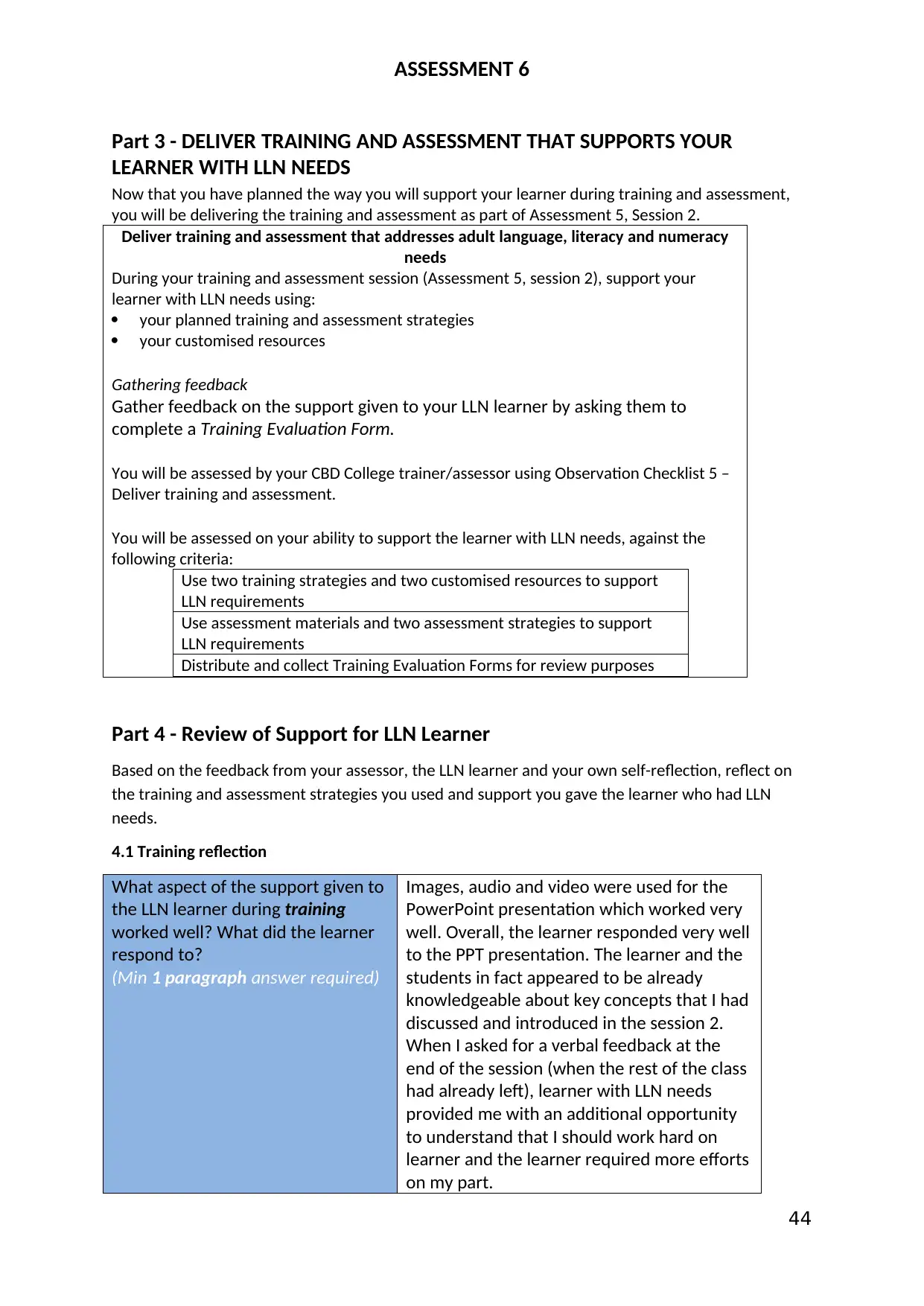
ASSESSMENT 6
Part 3 - DELIVER TRAINING AND ASSESSMENT THAT SUPPORTS YOUR
LEARNER WITH LLN NEEDS
Now that you have planned the way you will support your learner during training and assessment,
you will be delivering the training and assessment as part of Assessment 5, Session 2.
Deliver training and assessment that addresses adult language, literacy and numeracy
needs
During your training and assessment session (Assessment 5, session 2), support your
learner with LLN needs using:
your planned training and assessment strategies
your customised resources
Gathering feedback
Gather feedback on the support given to your LLN learner by asking them to
complete a Training Evaluation Form.
You will be assessed by your CBD College trainer/assessor using Observation Checklist 5 –
Deliver training and assessment.
You will be assessed on your ability to support the learner with LLN needs, against the
following criteria:
Use two training strategies and two customised resources to support
LLN requirements
Use assessment materials and two assessment strategies to support
LLN requirements
Distribute and collect Training Evaluation Forms for review purposes
Part 4 - Review of Support for LLN Learner
Based on the feedback from your assessor, the LLN learner and your own self-reflection, reflect on
the training and assessment strategies you used and support you gave the learner who had LLN
needs.
4.1 Training reflection
What aspect of the support given to
the LLN learner during training
worked well? What did the learner
respond to?
(Min 1 paragraph answer required)
Images, audio and video were used for the
PowerPoint presentation which worked very
well. Overall, the learner responded very well
to the PPT presentation. The learner and the
students in fact appeared to be already
knowledgeable about key concepts that I had
discussed and introduced in the session 2.
When I asked for a verbal feedback at the
end of the session (when the rest of the class
had already left), learner with LLN needs
provided me with an additional opportunity
to understand that I should work hard on
learner and the learner required more efforts
on my part.
44
Part 3 - DELIVER TRAINING AND ASSESSMENT THAT SUPPORTS YOUR
LEARNER WITH LLN NEEDS
Now that you have planned the way you will support your learner during training and assessment,
you will be delivering the training and assessment as part of Assessment 5, Session 2.
Deliver training and assessment that addresses adult language, literacy and numeracy
needs
During your training and assessment session (Assessment 5, session 2), support your
learner with LLN needs using:
your planned training and assessment strategies
your customised resources
Gathering feedback
Gather feedback on the support given to your LLN learner by asking them to
complete a Training Evaluation Form.
You will be assessed by your CBD College trainer/assessor using Observation Checklist 5 –
Deliver training and assessment.
You will be assessed on your ability to support the learner with LLN needs, against the
following criteria:
Use two training strategies and two customised resources to support
LLN requirements
Use assessment materials and two assessment strategies to support
LLN requirements
Distribute and collect Training Evaluation Forms for review purposes
Part 4 - Review of Support for LLN Learner
Based on the feedback from your assessor, the LLN learner and your own self-reflection, reflect on
the training and assessment strategies you used and support you gave the learner who had LLN
needs.
4.1 Training reflection
What aspect of the support given to
the LLN learner during training
worked well? What did the learner
respond to?
(Min 1 paragraph answer required)
Images, audio and video were used for the
PowerPoint presentation which worked very
well. Overall, the learner responded very well
to the PPT presentation. The learner and the
students in fact appeared to be already
knowledgeable about key concepts that I had
discussed and introduced in the session 2.
When I asked for a verbal feedback at the
end of the session (when the rest of the class
had already left), learner with LLN needs
provided me with an additional opportunity
to understand that I should work hard on
learner and the learner required more efforts
on my part.
44
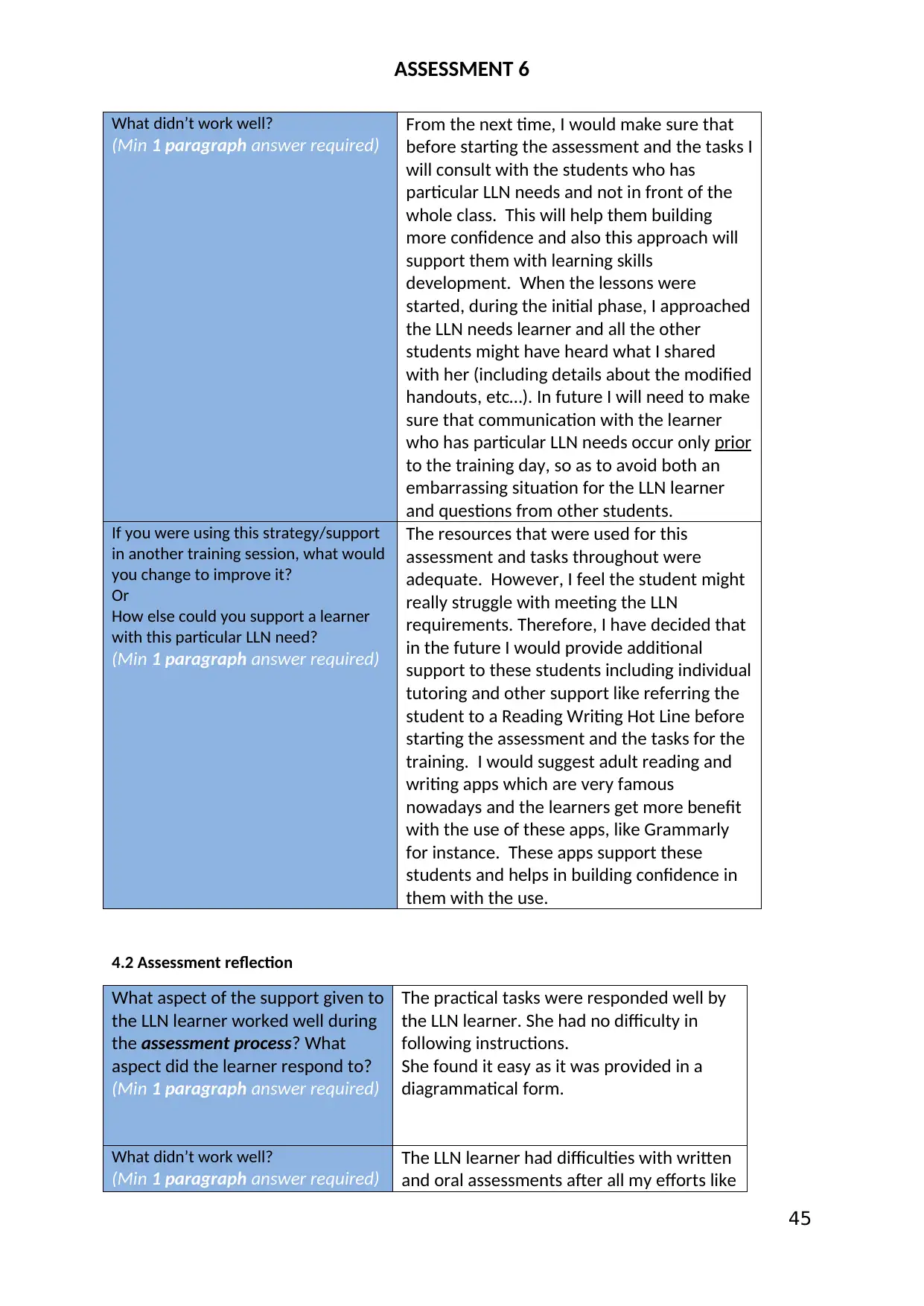
ASSESSMENT 6
What didn’t work well?
(Min 1 paragraph answer required)
From the next time, I would make sure that
before starting the assessment and the tasks I
will consult with the students who has
particular LLN needs and not in front of the
whole class. This will help them building
more confidence and also this approach will
support them with learning skills
development. When the lessons were
started, during the initial phase, I approached
the LLN needs learner and all the other
students might have heard what I shared
with her (including details about the modified
handouts, etc…). In future I will need to make
sure that communication with the learner
who has particular LLN needs occur only prior
to the training day, so as to avoid both an
embarrassing situation for the LLN learner
and questions from other students.
If you were using this strategy/support
in another training session, what would
you change to improve it?
Or
How else could you support a learner
with this particular LLN need?
(Min 1 paragraph answer required)
The resources that were used for this
assessment and tasks throughout were
adequate. However, I feel the student might
really struggle with meeting the LLN
requirements. Therefore, I have decided that
in the future I would provide additional
support to these students including individual
tutoring and other support like referring the
student to a Reading Writing Hot Line before
starting the assessment and the tasks for the
training. I would suggest adult reading and
writing apps which are very famous
nowadays and the learners get more benefit
with the use of these apps, like Grammarly
for instance. These apps support these
students and helps in building confidence in
them with the use.
4.2 Assessment reflection
What aspect of the support given to
the LLN learner worked well during
the assessment process? What
aspect did the learner respond to?
(Min 1 paragraph answer required)
The practical tasks were responded well by
the LLN learner. She had no difficulty in
following instructions.
She found it easy as it was provided in a
diagrammatical form.
What didn’t work well?
(Min 1 paragraph answer required)
The LLN learner had difficulties with written
and oral assessments after all my efforts like
45
What didn’t work well?
(Min 1 paragraph answer required)
From the next time, I would make sure that
before starting the assessment and the tasks I
will consult with the students who has
particular LLN needs and not in front of the
whole class. This will help them building
more confidence and also this approach will
support them with learning skills
development. When the lessons were
started, during the initial phase, I approached
the LLN needs learner and all the other
students might have heard what I shared
with her (including details about the modified
handouts, etc…). In future I will need to make
sure that communication with the learner
who has particular LLN needs occur only prior
to the training day, so as to avoid both an
embarrassing situation for the LLN learner
and questions from other students.
If you were using this strategy/support
in another training session, what would
you change to improve it?
Or
How else could you support a learner
with this particular LLN need?
(Min 1 paragraph answer required)
The resources that were used for this
assessment and tasks throughout were
adequate. However, I feel the student might
really struggle with meeting the LLN
requirements. Therefore, I have decided that
in the future I would provide additional
support to these students including individual
tutoring and other support like referring the
student to a Reading Writing Hot Line before
starting the assessment and the tasks for the
training. I would suggest adult reading and
writing apps which are very famous
nowadays and the learners get more benefit
with the use of these apps, like Grammarly
for instance. These apps support these
students and helps in building confidence in
them with the use.
4.2 Assessment reflection
What aspect of the support given to
the LLN learner worked well during
the assessment process? What
aspect did the learner respond to?
(Min 1 paragraph answer required)
The practical tasks were responded well by
the LLN learner. She had no difficulty in
following instructions.
She found it easy as it was provided in a
diagrammatical form.
What didn’t work well?
(Min 1 paragraph answer required)
The LLN learner had difficulties with written
and oral assessments after all my efforts like
45
1 out of 45
Related Documents
Your All-in-One AI-Powered Toolkit for Academic Success.
+13062052269
info@desklib.com
Available 24*7 on WhatsApp / Email
![[object Object]](/_next/static/media/star-bottom.7253800d.svg)
Unlock your academic potential
© 2024 | Zucol Services PVT LTD | All rights reserved.





